Motorola Mobility T56AD1 Dual Band Cellular PCS Transceiver User Manual AD EX08
Motorola Mobility LLC Dual Band Cellular PCS Transceiver AD EX08
Exhibit 8 Users Manual

APPLICANT: MOTOROLA, INC. FCC ID: IHDT56AD1
EXHIBIT 8
INSTRUCTION MANUAL
A preliminary draft copy of the Users Manual follows:
Phoenix Wireless Telephone
User Guide
Draft for FCC Type Approval
March 10, 2000

1
Welcome
Welcome to the world of Motorola digital wireless
communications from a global leader in communications
technology! We are pleased you have chosen the Motorola
V
wireless phone to keep you connected with ease.
All Motorola phones are designed and manufactured to
meet Motorola’s rigorous specifications and world-class
quality standards. During development, our testing team
took the Motorola
V
phone through rigorous durability
tests including temperature, humidity, shock, dust, vibration,
and drop tests—and the phone still worked!
We are confident that you and your callers will find your
wireless phone to be a convenient and reliable way to stay
in touch. Thank you for choosing a Motorola
V
product
and enjoy your new phone!

2
Contents
Safety Information
. . . . . . . . . . . . . . . . . . . . . . . . . . . . . 10
Overview
. . . . . . . . . . . . . . . . . . . . . . . . . . . . . . . . . . . . . 16
Package Content Options . . . . . . . . . . . . . . . . . . . . . . 16
Phone Diagram . . . . . . . . . . . . . . . . . . . . . . . . . . . . . . 18
Phone Overview . . . . . . . . . . . . . . . . . . . . . . . . . . . . . 19
Understanding the Guide . . . . . . . . . . . . . . . . . . . . . . 20
Batteries
. . . . . . . . . . . . . . . . . . . . . . . . . . . . . . . . . . . . . 22
Storing and Disposing of Batteries . . . . . . . . . . . . . . . 22
Removing and Attaching Battery Covers . . . . . . . . . . 23
Installing and Removing Batteries . . . . . . . . . . . . . . . 25
Battery Talk Time and Standby Time . . . . . . . . . . . . . 27
Charging Batteries . . . . . . . . . . . . . . . . . . . . . . . . . . . 28
Phone Basics
. . . . . . . . . . . . . . . . . . . . . . . . . . . . . . . . . 33
Turning the Phone On and Off . . . . . . . . . . . . . . . . . . 33
Activating the Phone . . . . . . . . . . . . . . . . . . . . . . . . . . 34
Power-Up Display . . . . . . . . . . . . . . . . . . . . . . . . . . . . 34
The External Display . . . . . . . . . . . . . . . . . . . . . . . . . . 36
The Indicators . . . . . . . . . . . . . . . . . . . . . . . . . . . . . . . 36
Status Light . . . . . . . . . . . . . . . . . . . . . . . . . . . . . . . . . 39
Storing the Phone in its Holster . . . . . . . . . . . . . . . . . 40
Viewing the Phone Number . . . . . . . . . . . . . . . . . . . . 40
Placing a Call . . . . . . . . . . . . . . . . . . . . . . . . . . . . . . . 40
Ending a Call . . . . . . . . . . . . . . . . . . . . . . . . . . . . . . . 41
Redialing a Number . . . . . . . . . . . . . . . . . . . . . . . . . . 41
Receiving a Call . . . . . . . . . . . . . . . . . . . . . . . . . . . . . 43
Using the Keypad to Enter Text . . . . . . . . . . . . . . . . . . 45
Controlling the Volume . . . . . . . . . . . . . . . . . . . . . . . . 48

3
The Smart Button . . . . . . . . . . . . . . . . . . . . . . . . . . . . 49
The Menu System
. . . . . . . . . . . . . . . . . . . . . . . . . . . . . 50
Menu Features . . . . . . . . . . . . . . . . . . . . . . . . . . . . . . 50
Navigating Through the Menu . . . . . . . . . . . . . . . . . . 53
Menu Elements . . . . . . . . . . . . . . . . . . . . . . . . . . . . . . 54
Sending and Receiving Calls
. . . . . . . . . . . . . . . . . . . . 59
Menu Features . . . . . . . . . . . . . . . . . . . . . . . . . . . . . . 60
Dialing Numbers and Characters . . . . . . . . . . . . . . . . 60
Dialing with Speed Dial . . . . . . . . . . . . . . . . . . . . . . . . 62
Dialing with Turbo Dial® . . . . . . . . . . . . . . . . . . . . . . . 62
Dialing Numbers from Missed or Recent Calls . . . . . . 63
Dialing from a Text Message . . . . . . . . . . . . . . . . . . . 66
Adding or Attaching Numbers . . . . . . . . . . . . . . . . . . . 67
Dialing Emergency Calls . . . . . . . . . . . . . . . . . . . . . . 71
Receiving a Basic Call . . . . . . . . . . . . . . . . . . . . . . . . 72
Receiving Calls with Caller ID . . . . . . . . . . . . . . . . . . 73
Using Call Waiting . . . . . . . . . . . . . . . . . . . . . . . . . . . 73
In-Call Features
. . . . . . . . . . . . . . . . . . . . . . . . . . . . . . . 76
Menu Features . . . . . . . . . . . . . . . . . . . . . . . . . . . . . . 76
Receiving a Second Call . . . . . . . . . . . . . . . . . . . . . . 77
Sending and Receiving Data or Fax Calls . . . . . . . . . 78
Viewing Your Phone Number . . . . . . . . . . . . . . . . . . . 79
Muting a Call . . . . . . . . . . . . . . . . . . . . . . . . . . . . . . . . 80
Placing a Call on Hold . . . . . . . . . . . . . . . . . . . . . . . . 80
Dialing and Entering Numbers . . . . . . . . . . . . . . . . . . 81
Setting Up a Three-Way Analog Call . . . . . . . . . . . . . 82
Using Digital Conference Call Options . . . . . . . . . . . . 83
Transferring a Call . . . . . . . . . . . . . . . . . . . . . . . . . . . 86
Sending Tones . . . . . . . . . . . . . . . . . . . . . . . . . . . . . . 88
Entering a PIN (Analog) . . . . . . . . . . . . . . . . . . . . . . . 88
Viewing Entries . . . . . . . . . . . . . . . . . . . . . . . . . . . . . . 89

4
Using a Speakerphone (Handsfree Mode) . . . . . . . . . 92
Recent Calls
. . . . . . . . . . . . . . . . . . . . . . . . . . . . . . . . . . 93
Menu Features . . . . . . . . . . . . . . . . . . . . . . . . . . . . . . 93
Tips for the Received Calls List . . . . . . . . . . . . . . . . . 93
Tips for the Dialed Calls List . . . . . . . . . . . . . . . . . . . . 94
Using the Notepad . . . . . . . . . . . . . . . . . . . . . . . . . . 101
Viewing or Resetting Call Timers . . . . . . . . . . . . . . . 102
Call Forwarding
. . . . . . . . . . . . . . . . . . . . . . . . . . . . . . 104
Menu Features . . . . . . . . . . . . . . . . . . . . . . . . . . . . . 104
Setting up Call Forwarding . . . . . . . . . . . . . . . . . . . . 105
Checking Call Forward Status . . . . . . . . . . . . . . . . . 108
Turning Off Call Forwarding . . . . . . . . . . . . . . . . . . . 109
Calls and Messages
. . . . . . . . . . . . . . . . . . . . . . . . . . . 112
Menu Features for Calls and Messages . . . . . . . . . . 112
Sending a Text Message . . . . . . . . . . . . . . . . . . . . . . 113
Sending Data and Fax Calls . . . . . . . . . . . . . . . . . . . 118
Receiving a Fax . . . . . . . . . . . . . . . . . . . . . . . . . . . . 120
Messages
. . . . . . . . . . . . . . . . . . . . . . . . . . . . . . . . . . . 123
Menu Features for Messages . . . . . . . . . . . . . . . . . . 123
Types of Messages . . . . . . . . . . . . . . . . . . . . . . . . . . 124
Receiving New Messages . . . . . . . . . . . . . . . . . . . . 124
Text and Information Services Messages . . . . . . . . . 126
Information Services and Text Message Inboxes . . . 138
VoiceMail Messages . . . . . . . . . . . . . . . . . . . . . . . . . 159
Quicknotes . . . . . . . . . . . . . . . . . . . . . . . . . . . . . . . . 161
The Outbox . . . . . . . . . . . . . . . . . . . . . . . . . . . . . . . . 165
The Drafts Folder . . . . . . . . . . . . . . . . . . . . . . . . . . . 170
Synchronizing Messages with PIM Software . . . . . . 175
Checking Memory and Cleaning Up All Messages . . 176
Troubleshooting . . . . . . . . . . . . . . . . . . . . . . . . . . . . 178

5
Phone Status
. . . . . . . . . . . . . . . . . . . . . . . . . . . . . . . . 180
Menu Features . . . . . . . . . . . . . . . . . . . . . . . . . . . . . 180
Displaying Your Phone Number . . . . . . . . . . . . . . . . 181
Displaying Credit Information . . . . . . . . . . . . . . . . . . 181
Displaying and Changing Your Active Phone Number . .
182
Changing the Current Phone Line . . . . . . . . . . . . . . 183
Displaying the Battery Charge Level . . . . . . . . . . . . 185
Initial Setup
. . . . . . . . . . . . . . . . . . . . . . . . . . . . . . . . . 186
Menu Features . . . . . . . . . . . . . . . . . . . . . . . . . . . . . 187
Changing the Time and Date . . . . . . . . . . . . . . . . . . 187
Setting the Phonebook for One-Touch Dialing . . . . . 191
Adjusting Automatic Redial . . . . . . . . . . . . . . . . . . . . 192
Adjusting the Display Backlight . . . . . . . . . . . . . . . . . 193
Adjusting the Status Light . . . . . . . . . . . . . . . . . . . . . 194
Changing the Zoom Setting . . . . . . . . . . . . . . . . . . . 194
Changing Scrolling Behavior . . . . . . . . . . . . . . . . . . 195
Turning Animation On and Off . . . . . . . . . . . . . . . . . 196
Setting a Language Preference . . . . . . . . . . . . . . . . 197
Setting Battery Charge Conservation Preferences . . 198
Adjusting the DTMF Setting . . . . . . . . . . . . . . . . . . . 198
Master Reset . . . . . . . . . . . . . . . . . . . . . . . . . . . . . . 199
Master Clear . . . . . . . . . . . . . . . . . . . . . . . . . . . . . . . 200
In-Call Settings
. . . . . . . . . . . . . . . . . . . . . . . . . . . . . . . 202
Menu Features . . . . . . . . . . . . . . . . . . . . . . . . . . . . . 202
Setting Up In-Call Timers . . . . . . . . . . . . . . . . . . . . . 202
Turning Answer Options On or Off . . . . . . . . . . . . . . 205
Turning Call Waiting On or Off . . . . . . . . . . . . . . . . . 207
Using Lock/Security Features
. . . . . . . . . . . . . . . . . . 208
Menu Features . . . . . . . . . . . . . . . . . . . . . . . . . . . . . 209
Locking and Unlocking Your Phone . . . . . . . . . . . . . 209

6
Locking and Unlocking the Keypad . . . . . . . . . . . . . . 214
Restricting Access to Applications . . . . . . . . . . . . . . 216
Restricting Calls . . . . . . . . . . . . . . . . . . . . . . . . . . . . 218
Changing Passwords . . . . . . . . . . . . . . . . . . . . . . . . 219
Ring and Vibrate Features
. . . . . . . . . . . . . . . . . . . . . . 222
Menu Features . . . . . . . . . . . . . . . . . . . . . . . . . . . . . 223
Selecting a Ring/Vibration Type . . . . . . . . . . . . . . . . 223
Changing the Ring Volume . . . . . . . . . . . . . . . . . . . . 224
Selecting a Ring/Vibration for a Specific Event . . . . . 225
Selecting a Reminder . . . . . . . . . . . . . . . . . . . . . . . . 226
Changing Keypad Volume . . . . . . . . . . . . . . . . . . . . . 226
Phonebook
. . . . . . . . . . . . . . . . . . . . . . . . . . . . . . . . . . 228
Menu Features . . . . . . . . . . . . . . . . . . . . . . . . . . . . . 229
Making the Most of Memory . . . . . . . . . . . . . . . . . . . 229
Fields in Phonebook Entry Forms . . . . . . . . . . . . . . 230
Storing Phonebook Entries . . . . . . . . . . . . . . . . . . . . 231
Calling Phonebook Entries . . . . . . . . . . . . . . . . . . . . 237
Editing/Deleting Phonebook Entries . . . . . . . . . . . . . 239
Adding or Attaching Numbers Before Calling . . . . . . 244
Copying Phonebook Entries to a SIM Card . . . . . . . 244
Checking Phonebook Capacity . . . . . . . . . . . . . . . . . 249
Synchronization with PIM Software . . . . . . . . . . . . . 250
Phonebook Setup . . . . . . . . . . . . . . . . . . . . . . . . . . . 251
Troubleshooting . . . . . . . . . . . . . . . . . . . . . . . . . . . . 254
Shortcuts
. . . . . . . . . . . . . . . . . . . . . . . . . . . . . . . . . . . 256
Menu Features . . . . . . . . . . . . . . . . . . . . . . . . . . . . . 256
Help for Setting Shortcuts . . . . . . . . . . . . . . . . . . . . . 257
Setting Navigation Shortcuts . . . . . . . . . . . . . . . . . . 258
Setting Voice Shortcuts . . . . . . . . . . . . . . . . . . . . . . . 262
Shortcut Setup Errors . . . . . . . . . . . . . . . . . . . . . . . . 266
Editing Shortcuts . . . . . . . . . . . . . . . . . . . . . . . . . . . 268

7
Deleting Shortcuts . . . . . . . . . . . . . . . . . . . . . . . . . . 270
Using Shortcuts . . . . . . . . . . . . . . . . . . . . . . . . . . . . 273
Personal Options
. . . . . . . . . . . . . . . . . . . . . . . . . . . . . 277
Menu Features . . . . . . . . . . . . . . . . . . . . . . . . . . . . . 277
Reordering the Main Menu . . . . . . . . . . . . . . . . . . . . 277
Changing the Idle Functions of the Smart and Soft Keys
278
Changing the Wake-up Greeting . . . . . . . . . . . . . . . 280
Changing the Phone’s Idle Banner . . . . . . . . . . . . . . 281
Changing Quick Dial Numbers . . . . . . . . . . . . . . . . . 282
The Datebook
. . . . . . . . . . . . . . . . . . . . . . . . . . . . . . . . 284
Menu Features . . . . . . . . . . . . . . . . . . . . . . . . . . . . . 285
Using the Datebook Menu . . . . . . . . . . . . . . . . . . . . 285
Datebook Views . . . . . . . . . . . . . . . . . . . . . . . . . . . . 286
Storing a New Event . . . . . . . . . . . . . . . . . . . . . . . . . 290
Editing Events . . . . . . . . . . . . . . . . . . . . . . . . . . . . . . 297
Copying Events . . . . . . . . . . . . . . . . . . . . . . . . . . . . . 299
Deleting Events . . . . . . . . . . . . . . . . . . . . . . . . . . . . 300
Changing the Datebook Setup . . . . . . . . . . . . . . . . . 303
Event Reminders . . . . . . . . . . . . . . . . . . . . . . . . . . . 306
Quick Dial
. . . . . . . . . . . . . . . . . . . . . . . . . . . . . . . . . . . 309
Menu Features . . . . . . . . . . . . . . . . . . . . . . . . . . . . . 309
Calling the Quick Dial Number . . . . . . . . . . . . . . . . . 310
Using VoiceNotes
. . . . . . . . . . . . . . . . . . . . . . . . . . . . . 313
Viewing the VoiceNotes List . . . . . . . . . . . . . . . . . . . 313
Playing Back a VoiceNote . . . . . . . . . . . . . . . . . . . . . 315
The Playback Screen . . . . . . . . . . . . . . . . . . . . . . . . 315
Using the VoiceNotes Menu . . . . . . . . . . . . . . . . . . . 317
Viewing VoiceNote Recording Instructions . . . . . . . . 318
Recording a VoiceNote . . . . . . . . . . . . . . . . . . . . . . . 320

8
Locking/Unlocking a VoiceNote . . . . . . . . . . . . . . . . . 321
Deleting a VoiceNote Entry . . . . . . . . . . . . . . . . . . . . 323
Deleting All VoiceNotes . . . . . . . . . . . . . . . . . . . . . . . 325
Checking VoiceNotes Memory Capacity . . . . . . . . . . 326
Hands-Free Use
. . . . . . . . . . . . . . . . . . . . . . . . . . . . . . 328
Menu Features . . . . . . . . . . . . . . . . . . . . . . . . . . . . . 328
Setting Automatic Answer . . . . . . . . . . . . . . . . . . . . . 329
Setting Automatic Hands-Free . . . . . . . . . . . . . . . . . 329
Setting the Power-Off Delay . . . . . . . . . . . . . . . . . . . 330
Setting the Phone Charge Time . . . . . . . . . . . . . . . . 331
The Browser
. . . . . . . . . . . . . . . . . . . . . . . . . . . . . . . . . 333
Menu Features . . . . . . . . . . . . . . . . . . . . . . . . . . . . . 334
Starting a Browser Session . . . . . . . . . . . . . . . . . . . 334
Navigating the Browser . . . . . . . . . . . . . . . . . . . . . . . 337
Displaying Content . . . . . . . . . . . . . . . . . . . . . . . . . . 338
Placing Calls in an Active Browser Session . . . . . . . 343
Ending Calls in an Active Browser Session . . . . . . . 345
Running the Browser in the Background . . . . . . . . . 345
Network Services
. . . . . . . . . . . . . . . . . . . . . . . . . . . . . 349
Menu Features . . . . . . . . . . . . . . . . . . . . . . . . . . . . . 349
Viewing the Currently Registered Network . . . . . . . . 350
Displaying Available Networks . . . . . . . . . . . . . . . . . 350
Registering on a Network . . . . . . . . . . . . . . . . . . . . . 352
Finding a New Network . . . . . . . . . . . . . . . . . . . . . . . 352
Finding a Public Network . . . . . . . . . . . . . . . . . . . . . 355
Changing Network Setup Values . . . . . . . . . . . . . . . 355
Changing Network Search Types . . . . . . . . . . . . . . . 358
Setting Service Tones . . . . . . . . . . . . . . . . . . . . . . . . 360
Setting the Call Drop Alert . . . . . . . . . . . . . . . . . . . . 361
Interactive Services
. . . . . . . . . . . . . . . . . . . . . . . . . . . 363

9
Menu Features . . . . . . . . . . . . . . . . . . . . . . . . . . . . . 363
Starting an Interactive Service . . . . . . . . . . . . . . . . . 364
Recognizing Error Conditions . . . . . . . . . . . . . . . . . . 369
Interacting with a Service . . . . . . . . . . . . . . . . . . . . . 370
Infrared Connections
. . . . . . . . . . . . . . . . . . . . . . . . . . 376
Menu Features . . . . . . . . . . . . . . . . . . . . . . . . . . . . . 376
Establishing an Infrared Connection . . . . . . . . . . . . . 376
Accessories
. . . . . . . . . . . . . . . . . . . . . . . . . . . . . . . . . 378
Troubleshooting
. . . . . . . . . . . . . . . . . . . . . . . . . . . . . . 381
Glossary
. . . . . . . . . . . . . . . . . . . . . . . . . . . . . . . . . . . . 386
Patent Information
. . . . . . . . . . . . . . . . . . . . . . . . . . . 403

10
Safety Information
Important:
Read this information before using your
wireless handheld phone.
Exposure to Radio Frequency Signals
Your wireless handheld portable telephone is a low power
radio transmitter and receiver. When it is ON, it receives
and also sends out radio frequency (RF) signals.
In August 1996, The Federal Communications Commission
(FCC) adopted RF exposure guidelines with safety levels
for handheld wireless phones. Those guidelines are
consistent with safety standards previously set by both U.S.
and international standards bodies:
•
American National Standards Institute (ANSI) IEEE.
C95. 1-1992
•
National Council on Radiation Protection and
Measurement (NCRP). Report 86
•
International Commission on Non-Ionizing Radiation
Protection (ICNIRP) 1996
•
Ministry of Health (Canada), Safety Code 6
Those standards were based on comprehensive and
periodic evaluations of the relevant scientific literature. For
example, over 120 scientists, engineers, and physicians
from universities, government health agencies, and industry
reviewed the available body of research to develop the
ANSI Standard (C95.1).

Safety Information
11
The design of your phone complies with the FCC guidelines
(and those standards). For additional information
concerning exposure to radio frequency signals, see the
statement by the FDA at the end of this user guide.
To maintain compliance with FCC RF exposure guidelines,
if you wear a handset on your body, use the Motorola-
supplied or approved carrying case, holster, or other body-
worn accessory.
If you do not use a body-worn accessory, ensure the
antenna is at least one inch (2.5 centimeters) from your
body when transmitting. Use of non-Motorola accessories
may violate FCC RF exposure guidelines.
Antenna Care
Use only the supplied or an approved replacement
antenna. Unauthorized antennas, modifications, or
attachments could damage the phone and may violate FCC
regulations.
Phone Operation
Normal Operation
Hold the phone as you would any other telephone, with the
antenna pointed up and over your shoulder.
Tips on Efficient Operation
Observe the following guidelines to operate your phone
most efficiently.
•
Extend your antenna fully, if applicable.
•
Do not touch the antenna unnecessarily when the
phone is in use. Contact with the antenna affects call

12
Safety Information
quality and may cause the phone to operate at a
higher power level than otherwise needed.
Batteries
Caution:
All batteries can cause property damage, injury,
or burns if a conductive material, such as jewelry, keys or
beaded chains, touches exposed terminals. The material
may complete an electrical circuit and become quite hot. To
protect against such unwanted current drain, exercise care
in handling any charged battery, particularly when placing it
inside your pocket, purse, or other container with metal
objects. When the battery is detached from the phone, your
batteries are packed with a protective battery cover; please
use this cover for storing your batteries when not in use.
Driving
Check the laws and regulations on the use of wireless
telephones in the areas where you drive. Always obey
them. Observe the following guidelines when using your
phone while driving.
•
Give full attention to driving--driving safely is your first
responsibility.
•
Use hands-free phone operation, if available.
•
Pull off the road and park before making or answering
a call if driving conditions so require.
Electronic Devices
Most modern electronic equipment is shielded from RF
signals. However, certain equipment may not be shielded
against the RF signals from your wireless phone.

Safety Information
13
Pacemakers
The Health Industry Manufacturers Association
recommends that a minimum separation of six inches (6")
be maintained between a handheld wireless phone and a
pacemaker to avoid potential interference with the
pacemaker. These recommendations are consistent with
the independent research by and recommendations of
Wireless Technology Research.
Persons with pacemakers:
•
should ALWAYS keep the phone more than six inches
from their pacemaker when the phone is turned ON
•
should not carry the phone in a breast pocket
•
should use the ear opposite the pacemaker to
minimize the potential for interference
•
should turn the phone OFF immediately if you have
any reason to suspect that interference is taking
place
Hearing Aids
Some digital wireless phones may interfere with some
hearing aids. In the event of such interference, you may
want to consult your hearing aid manufacturer to discuss
alternatives.
Other Medical Devices
If you use any other personal medical device, consult the
manufacturer of your device to determine if it is adequately
shielded from external RF energy. Your physician may be
able to assist you in obtaining this information.

14
Safety Information
Turn your phone OFF in health care facilities when any
regulations posted in these areas instruct you to do so.
Hospitals or health care facilities may be using equipment
that could be sensitive to external RF energy.
Vehicles
RF signals may affect improperly installed or inadequately
shielded electronic systems in motor vehicles. Check with
the manufacturer or its representative regarding your
vehicle. You should also consult the manufacturer of any
equipment that has been added to your vehicle.
Posted Facilities
Turn your phone OFF in any facility where posted notices
so require.
Aircraft
Switch OFF your phone before boarding an aircraft. Airline
regulations prohibit using your phone while in the air. Check
and comply with the policy of your airline regarding the use
of your phone while the aircraft is on the ground.
Blasting Areas
To avoid interfering with blasting operations, turn your
phone OFF when in a “blasting area” or in areas posted:
“Turn off two-way radio.” Obey all signs and instructions.
Potentially Explosive Atmospheres
Turn your phone OFF, do not remove your battery when you
are in any area with a potentially explosive atmosphere,
and obey all signs and instructions. Sparks from your

Safety Information
15
battery in such areas could cause an explosion or fire
resulting in bodily injury or even death.
Areas with a potentially explosive atmosphere are often but
not always clearly marked. They include: fueling areas such
as gasoline stations; below deck on boats; fuel or chemical
transfer or storage facilities; areas where fuel odors are
present (for example, if a gas/propane leak occurs in a car
or home); areas where the air contains chemicals or
particles, such as grain, dust, or metal powders; and any
other area where you normally would be advised to turn off
your vehicle engine.
For Vehicles Equipped with an Air Bag
An air bag inflates with great force. Do NOT place objects,
including both installed or portable wireless equipment, in
the area over the air bag or in the air bag deployment area.
If in-vehicle wireless equipment is improperly installed and
the air bag inflates, serious injury could result.
US021600
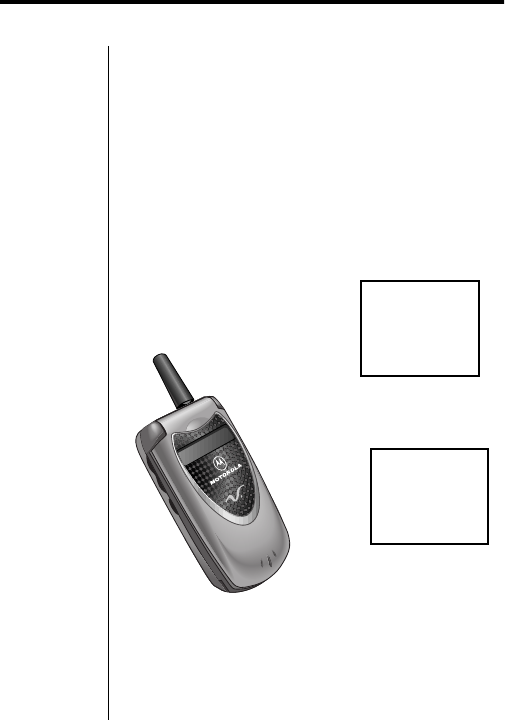
16
Overview
Package Content Options
Your digital wireless phone typically comes equipped with a
charger and at least one battery. A large selection of
accessory options can customize your wireless package for
maximum performance and portability. Below is a sampling
of the different package options.
Note:
Your phone and accessories may not look exactly as
pictured.
Motorola Telephone
Headset
Illustration
to come
Illustration
to come
Lithium Polymer Battery

Overview
17
Holster
Illustration
to come
Desktop Charger
(AC Adapter required)
Illustration
to come
Illustration
to come
Desktop Charger
(AC Adapter required)
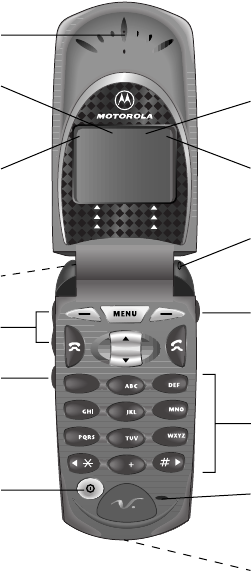
Overview
18
Phone Diagram
2
13
6
5
4
9
8
7
0
Battery Level
Indicator
Earpiece
Headset Jack
Power/Status
Indicator
Signal Strength
Indicator
Volume Keys
Smart Key
Voice Key
Icon Indicators VibraCall
®
Alert
Indicator
Microphone
Accessory
Connector Port
Power On/Off Key
Alphanumeric
Keypad

Overview
19
Phone Overview
See “Phone Diagram” on page 18 for an illustration of the
components described below.
Earpiece
—Ultra-compact phone speaker.
Headset Jack
—Connects an optional headset.
Power/Status Indicator
—Provides status information on
the current type of service and message status.
Signal Strength Indicator
—Indicates the strength of your
phone’s connection with the local wireless system.
Volume Keys
—The upper and lower volume keys can
adjust keypad, earpiece, and ringer volume. .
Smart Key
—Use the Smart key to recall information from
memory, place and end calls, select menu features, and
toggle features on and off. The symbol in your display
represents the Smart key.
Voice Key
—Use the voice key to record a VoiceNote memo
or to record a voice name for a phonebook entry.
Icon Indicators
—Displays various indicators such as
digital, in use, in building, no service, message waiting, and
voice message waiting indicators.
Battery Level Indicator
—Show the amount of charge
remaining in your battery.
VibraCall
®
Alert Indicator
—Indicates the on/off status of
the ringer and VibraCall alert.
Microphone
—Positioned for convenient conversation.
Accessory Connector Port
—Provides the connections for
an external power supply and vehicular and optional
accessories.

20
Overview
Special Keys
Understanding the Guide
Key Presses
Key presses are represented in this guide using symbols so
that you may locate and use the required sequence quickly.
A sequence of key presses may be shown as follows:
1
0
8
This means you should press
1
followed by
0
and
then
8
, in sequence, not simultaneously.
P
The power key turns the phone on and off
O
The send key places or answers calls
N
The end key ends phone calls
M
The menu key enters the menu system
S
The scroll key scrolls through memory
entries and menu features, and moves the
cursor when entering names or messages
-
and
+
The soft keys perform context-sensitive
functions as indicated by prompts in the
bottom line of the display.
The
-
(left soft key) usually returns to
a previous menu or exits the menu system.
The
+
(right soft key) usually selects
an item or confirms an action.

Overview 21
Prompts and Messages
Your phone responds to key presses by displaying either a
prompt that guides you to the next action or a message
confirming that your action is complete. Prompts and
messages are represented in this guide in LCD style, for
example:
Reset Timer
.
Shortcuts and Tips
In the margins of your guide are shortcuts and useful tips to
improve your phone’s performance.

22
Batteries
Your digital phone uses Lithium Polymer batteries. In this
chapter, you will learn how to:
•store and dispose of batteries
•remove and attach the cover to the battery
•install and remove batteries
•interpret battery talk time and standby time
•charge batteries using the internal charger and the
desktop charger
Storing and Disposing of
Batteries
To prolong the life of your batteries, do not expose them to
temperatures below -10°C (14°F) or above 45°C (113°F).
Always take your phone with you when you leave your car.
To dispose of batteries, check with your local recycling
center for a battery recycler near you. Never dispose of
batteries in a fire.
Caution: To prevent injuries or burns, do not allow metal
objects to contact or short-circuit the battery terminals.

Batteries 23
Removing and Attaching
Battery Covers
Your phone’s battery is shipped in an uncharged state and
fitted with a protective cover. Before you can use your
phone, you will need to remove the cover and charge the
battery. The cover prevents metal objects from contacting
the battery terminals, thereby reducing the risk of injury or
damage from a battery short circuit.
Removing the Battery Cover
Attaching the Battery Cover
Press
tab
1. Hold one end of the battery cover in
one hand. Press down on the tab at the
opposite end of the cover with your
other hand.
Remove
cover
2. Rotate the cover away from the battery.
Insert
side
1. Insert one end of the battery into the
cover, so that the battery fits the
notches on the cover.
Illustration
to come

24 Batteries
Click
latch
2. Push down the other side of the battery
until it clicks into place.
Illustration
to come
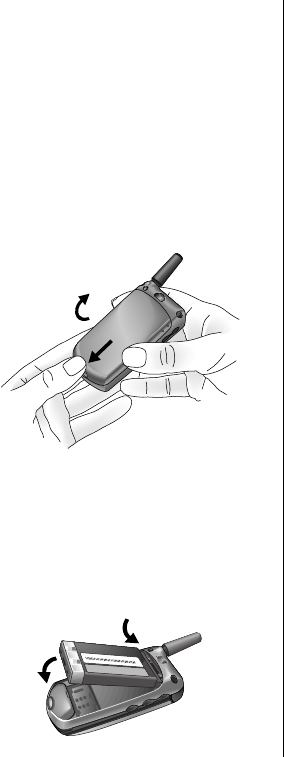
Batteries 25
Installing and Removing
Batteries
Installing the Battery
Remove
cover
1. Use your thumb to slide the release
latch toward the base of the phone.
2. With your other hand, rotate the cover
away from the phone.
Insert
battery
3. Insert the battery, printed arrows first,
into the top edge of the battery
compartment.
4. Push down the bottom edge of the
battery until it snaps into place.
1
2
3
4
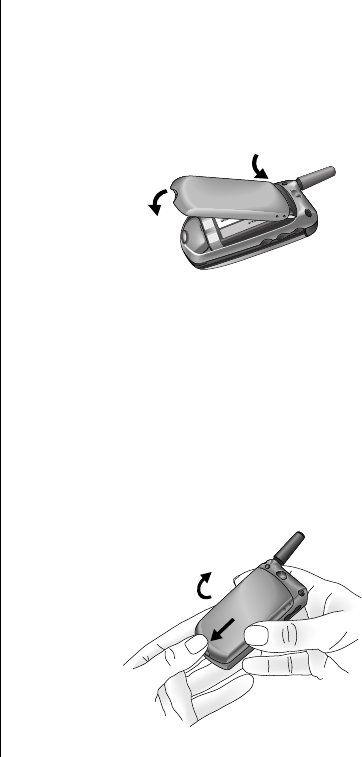
26 Batteries
Removing the Battery
Replace
cover
5. Insert the tabs of the battery cover into
the top edge of the battery
compartment.
6. Rotate the battery cover down until it
snaps into place.
Turn off
phone
1. Press
P
to turn off your phone.
Remove
cover
2. Use your thumb to slide the release
latch toward the base of the phone.
3. With your other hand, rotate the cover
away from the phone.
5
6
2
3
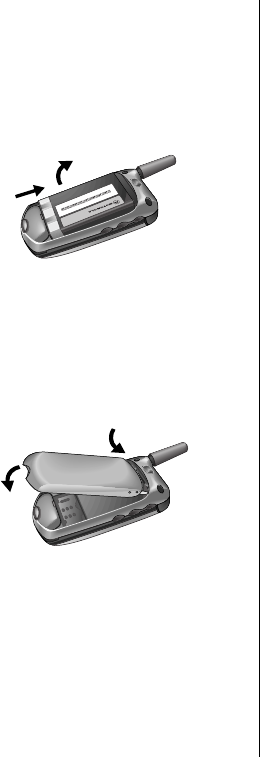
Batteries 27
Battery Talk Time and
Standby Time
Talk time
refers to the time you can talk on your phone
before the battery is fully discharged.
Standby time
is the
time that your phone is on but not used for talking.
Remove
battery
4. Push the battery toward the top of the
phone until the bottom edge comes
clear.
5. Rotate the bottom edge of the battery
up and lift the battery from the phone.
Replace
cover
6. Insert the tabs of the battery cover into
the top edge of the battery
compartment.
7. Rotate the battery cover down until it
snaps into place.
5
4
6
7

28 Batteries
Notes:
•Talking on the phone uses more power than leaving it
idle. The more power you use for talking, the less you
will have for standby time, and vice versa.
•Talk time and standby time can vary, depending on
the battery used, network configuration, signal
strength, and the features selected.
Charging Batteries
Using the Internal Charger
Tip:
If you talk
on the phone
while charging
your battery,
charging takes
more time. To
place the
phone in
charger-only
mode, turn off
the phone by
pressing
P
once.
Your phone has a built-in battery charger. Using either the
AC or vehicle power adapter, you can plug the handset
directly into a power source to charge any attached
batteries.
You can still place and answer calls while using the internal
charger. To place the phone in charger-only mode, turn off
the phone by pressing
P
once.
To charge:
B
Empty
J
Low
H
Medium
F
High
Attach
adapter
to
phone
1. Plug the AC adapter or vehicle power
adapter into the accessory connector
on the bottom of your phone as shown,
with the release tab facing up.

Batteries 29
Using the Desktop Charger
You can use the desktop charger to charge batteries while
they are attached to your phone, or you can charge a
battery separately.
To charge:
Plug in
adapter
2. Plug the power adapter into an AC
electrical outlet.
or
Plug the vehicle power adapter into the
cigarette lighter opening in the vehicle.
Note: In some cars, the ignition must be on
to use the vehicle’s accessory power.
In both cases, a beep tone sounds, and the
battery icon flashes.
Attach
adapter
to
charger
1. Plug the AC adapter into the back of
the charger, with the release tab facing
up.
Illustration
to come

30 Batteries
Note: When the phone is charging, the battery level
indicator flashes. When the battery is fully charged, the
indicator stops flashing. If your phone cannot charge the
battery, this indicator does not appear.
Desktop Charger Indicator Lights
The front LED light for charging a battery attached to the
phone in the charger’s front pocket is:
The rear LED lights for charging a battery in the rear pocket
are:
Plug in
adapter
2. Plug the power adapter into an AC
electrical outlet.
Insert
phone
and/or
battery
3. With battery attached, place the phone
into the charger’s front pocket.
Optionally, place an additional battery
into the charger’s back pocket.
Yellow
The phone is inserted. Check phone for
battery charge status.
Red
The battery is rapid charging.
Flashing
yellow
The battery is waiting for its charge.
Illustration
to come

Batteries 31
Battery Charging Tips
To ensure that you enjoy maximum battery life and use your
battery to its fullest capacity:
•Always use Motorola approved battery chargers.
•For the best results, charge Lithium Polymer batteries
using the E•P
®
Desktop Charger or your phone’s
internal charger.
•The battery should be at or near room temperature
when charging.
•New batteries or batteries that have been stored for
long periods of time may not rapid charge properly. In
these instances, the battery requires an overnight
charge.
•When you do not intend to use a battery for a while,
store it uncharged in a cool, dark, dry place, such as
a refrigerator.
•Over extended periods of time, batteries gradually
wear down and require longer charging times. This is
normal. If you charge your battery regularly and
notice a decrease in talk time or an increase in
charging time, then it is probably time to purchase a
new battery.
Green
The battery is charged over 90% of its
capacity and can be used. Another hour of
charging will bring it up to 100% capacity.
Flashing
red
Either the battery or the power supply is
damaged and cannot be charged.

32 Batteries
Expert Performance E•P
®
Charging
System
The Expert Performance E•P
®
Charging System enables
your phone’s built-in charger to communicate with installed
batteries and tailor its charging cycle to optimize
performance. If you see
Invalid Battery
when you power
up the phone, the built-in charger is not able to
communicate with the battery and cannot charge it. There
are several possible reasons for this message. The most
likely one is that the battery is not a Motorola original, and it
does not have the appropriate E•P
®
technology.
We recommend that you use only Motorola original
batteries and accessories and that you store your batteries
in their protective covers when not in use.

33
Phone Basics
This chapter introduces you to the basic features of your
new phone. It describes how to:
•turn the phone on and off
•activate your phone
•read the displays
•read the status line indicators
•store the phone in its holster
•view the phone number
•place a call
•end a call
•redial a number
•receive a call
•control the volume
•use the smart button
Turning the Phone On and
Off
To turn the phone on and off:
On
Press the
P
button.
Off
Press the
P
power button again.

34 Phone Basics
Activating the Phone
The first time you turn on your phone, you may see one of
the following messages:
Press to Activate
or
Activation required
.
If you do not see one of these displays, your phone was
activated at the time of purchase, and you may skip the
steps below.
If you do see one of the activation messages, complete the
activation procedure as follows:
Power-Up Display
When you turn on the phone, it plays a single power-up
tone and displays an animated Motorola wake-up greeting
for two seconds.
Place
Call
1. Press
O
to place the call.
or
Press and hold the smart key on the
left side of your phone until you hear a
high tone.
Once the connection is made,
activation begins.
Help?
2. If necessary, contact your service
provider for further assistance.
9

Phone Basics 35
Afterwards, the phone displays a customer wake-up
greeting for two seconds.
If the phone detects an invalid battery, it displays the
following message for two seconds:
Next, the phone scans the area for a network signal and
displays the message:
Searching for Network
. If the
phone does not find an appropriate network, it displays the
message
Registering
every two seconds until a network is
found.
When the phone has completed its power up sequence and
is ready to use, it displays the
Ready
message.
Number Display
Your phone can be activated with two unique phone
numbers. If more than one number is programmed, the
phone displays the active number whenever it is turned on.
To change the active number, see “Changing the Current
Phone Line” on page XX.
Power Saver Mode
If you travel outside the range of available networks, your
phone continues to search for a signal. To save power, it
Safety: Your
Most Important
Call
Invalid Battery
K

36 Phone Basics
stops searching ever few minutes and displays a
Power
Save
message. Your phone begins searching again in a
minute or two. Press any key to immediately resume
searching.
Standby Mode
Your phone may turn off the backlight to save power when
in standby mode. The backlight comes back on whenever
you press a key.
The External Display
Add information on viewing the external display to find out
information on caller id, voice mail, time and date, call
forwarding status, and alert status.
The Indicators
Signal Strength (1)
The Signal Strength indicator is one of the status icons at
the top of the display. It shows the strength of your phone’s
connection with the local wireless system.
A strong signal increases your ability to place and receive
calls. Weak signal strength can occur at the edge of a
wireless service area or in buildings, tunnels, and during
bad weather. Weak signal strength can interfere with or
block your ability to place and to receive calls and can affect
your reception.
v
Strong
w
Weak

Phone Basics 37
Battery Level Indicator (2)
The Battery Level indicator at the top of the display shows
the amount of charge left in your battery. The more
segments visible, the greater the charge.
When the battery level is low and only a few minutes of talk
time remain, your phone signals you in three ways:
•
Low Battery
appears in the first line of the display.
•No bar segments are highlighted.
•A short tone plays periodically.
Clock (3)
Your phone displays the current time and date when it is on
a digital network. You can set your clock for either 12 or 24
hour format.
Digital or Analog Indicator (4)
The digital icon appears when you are receiving a digital
signal. The analog icon appears if you receive an analog
signal.
In Use Indicator (5)
The In Use indicator appears when a call is in progress.
Roam Indicator (6)
The roam indicator appears when your phone accesses a
wireless system outside your home network. When you
leave your wireless service area, your phone
roams
or
seeks another service area.
B
Empty
J
Low
H
Medium
F
High
W
Z
p

38 Phone Basics
No Service Indicator (7)
If you travel beyond the range of wireless service, the No
Service indicator appears to let you know that you cannot
place or receive a call.
Message Waiting Indicator (8)
The Message Waiting indicator is displayed when the
phone receives a text message. (This is an optional,
network and subscription-dependent feature that is not
available in all areas.)
Voice Message Waiting Indicator (9)
The Voice Message Waiting indicator is displayed when
your voicemail has received a message.(This is an optional,
network and subscription-dependent feature that is not
available in all areas.)
Alphanumeric Display (10)
Text and number messages appear in the middle of the
phone’s display. Text and numbers show keypad input,
information recalled from memory, and other messages.
Alert Indicators (11)
Your phone displays the current selected alert. The default
alert is a ringer.
h
Ringer on—Your phone’s ringer is turned on and vibrate
alert is off.
j
Vibrate on—Your vibrate alert is on and ringer is
turned off.
w
P
O

Phone Basics 39
g
Vibrate then ring—Both ring and vibrate alerts are
turned on.
f
Ring then vibrate—Both ring and vibrate alerts are
turned on.
i
Silent—All of your phone’s tones are silenced and the
vibrate alert is turned on.
e
Vibrate with all tones off—
Your vibrate alert is on.
d
All Alerts off—Both vibrate and ring alerts are turned
off.
Status Light
You can check the status light on top of the phone for status
information on your current type of service and message
status. The messages can include voice mails and
messages, or the receipt of recent calls. (This is an
optional, network and subscription-dependent feature that
is not available in all areas.)
The status light changes color and flashes or remains on to
indicate different states. Status lights are as follows:
alternating red and
green incoming call or message
flashing green In Service, home-type system
slow flashing yellow no service
fast flashing yellow roaming, non-home type system

40 Phone Basics
Storing the Phone in its
Holster
To slip your phone into its holster, make sure the battery is
facing the outside of the holster. Then clip the holster onto a
belt, purse or briefcase.
The holster has been designed for your convenience and is
not meant to secure your phone under all circumstances.
Viewing the Phone Number
Placing a Call
To place a call:
Turn on
1. Press and hold
P
until the display
appears and you hear an audible alert.
Enter
number
2. Enter the number you want to call, for
example: 555-1212.
•Press
-
to erase one digit at a
time if you make a mistake.
•Press and hold
-
to clear the
entire entry.
You can also recall a previously dialed
or stored number. See “Using Phone
Memory” for details on storing or
recalling numbers.

Phone Basics 41
Ending a Call
To end a call:
•Press
N
or
•Press and hold the smart key until you hear a second
tone. The display reads
*smart key*
To End Call
.
Press *smart key* again to end the call.
Redialing a Number
Automatic Redial
You may not be able to complete a call if the wireless
system is busy. When this happens, the system transmits a
fast busy signal, and the phone displays one of the following
messages :
Call Failed. Press O to redial.
Place
call
1. Press
O
to place the call.
or
Press and hold the smart key on the
left side of the phone until you hear a
high tone.
The phone sounds a single-tone alert
(if the keypad tones are turned on) and
displays
Dialing 555-1212
.
2. You can dial phone numbers with up to
32 digits, but only the last 24 digits
appear in the display.

42 Phone Basics
WIth Automatic Redial, your phone repeats the call attempt
over the next four minutes. When the call goes through,
your phone rings or vibrates until the other party answers.
To activate Automatic Redial:
If you hear an ordinary busy signal, the phone number you
dialed is busy.
Recent Calls
Your phone keeps track of the last ten numbers that you
have dialed. You can display this list and select a number to
call.
Auto
Redial
To redial the busy number, press
O
or
Press and hold the smart key.
In either case,
Calling
is displayed.
Hang Up
1. Press
N
to hang up.
Redial
2. Press the smart key or
O
to redial the
busy number.
Dialing 5551234
is
displayed.
Display
1. Press
M
. Press
S
to scroll down
to
Recent Calls
. Press
+
.
2. Scroll down and select either
Received Calls
or
Dialed Calls
.
Press
+
.
3. Review the list and select a phone
number. Press
O
.

Phone Basics 43
Receiving a Call
Answering a Call
Your phone must be turned on to receive calls. When the
phone rings or vibrates, press
O
to answer the call.
Unanswered Call Indicator
When you cannot answer a call, your phone keeps a record
and a count of your unanswered calls and displays a
message like :
To view and place missed calls:
Review
4. Press
S
to scroll through the last calls.
The display includes the time, date and
phone number.
Call
5. Press
O
or press and hold *smart key*
to call the number in your display. The
Calling
message is displayed.
View list
1. Press
+
.
The received calls list is displayed.
2. Press
S
to scroll through the list.
Select any call that you wish to return.
2 Missed Calls
1 Unknown Call

44 Phone Basics
To clear the display, press
N
.
Caller ID
Caller ID is an optional feature that allows you to see who is
calling before you answer. Contact your service provider for
information about availability.
•If the caller’s name is recorded in your phone book,
the name is displayed.
•If the name is not in your phone book, the caller’s
phone number is displayed.
If you prefer to always see the caller’s phone number, see
“Turn Number Preference On.” Your phone stores IDs for
the last sixteen callers. See xxx to learn how to review the
stored Caller ID list.
Canceling the Ring or Vibrate Alert
Press either of the volume keys while the phone is ringing
to cancel the ring or vibrate alert.
The ringer or vibrator remains off while the current call
lasts. The caller still hears ringing, and you can still answer
the call by pressing
O
.
Call Waiting
Call Waiting is an optional service available through many
service providers. If you subscribe to call waiting, you may
Place
call
3. Press
O
.
The number is dialed and the call
processed for you.

Phone Basics 45
hear a tone while you are on a call. This tone indicates that
you have received a second call.
To answer the second call:
Using the Keypad to Enter
Text
When you want to add names to your phonebook or send
text messages, you can use your phone’s keypad to enter
letters and other characters.
Each number key represents several letters, which you can
cycle through by pressing the key repeatedly. For instance,
2
represents
a
,
b
,
c
, and
2
. Press
2
once to enter
the character
a,
twice to enter the character
b
, and three
times to enter
c.
Follow these steps:
Answer
1. Press
O
to answer the new call and
place the first call on hold.
or
End and
Answer
1. Press
N
to end the current call. Your
phone then rings or vibrates to signal
the new call.
2. Press
O
to answer the new call.
Press key
once
1. When you press
2
once, the letter
a
appears with a flashing block
cursor highlighting the letter.

46 Phone Basics
The following table shows you what letters each key
represents, and how many times you have to press the key
for each letter:
Continue
pressing
keys
2. As long as the block cursor highlights
the letter, press
2
a second time
to see the
b
, a third time to see the
c
,
a fourth time to see the
2
, a fifth time
to see the
a
again, and so on.
Toggle
case
3. Press
S
to toggle between upper or
lower case characters.
Enter
character
4. When the block cursor highlights your
selected character, wait for two
seconds.
The block cursor disappears, and a
thin I-beam cursor appears next to
the letter.
5. Enter the next character.
Key
Number of key presses
1234567891
01
11
21
31
41
5
0
+- 0x* / =><#(repeat)
1
.1?!,@&:;“-()’
2
a b c 2 (repeat)
3
d e f 3 (repeat)
4
g h i 4 (repeat)
5
j k l 5 (repeat)
6
m n o 6 (repeat
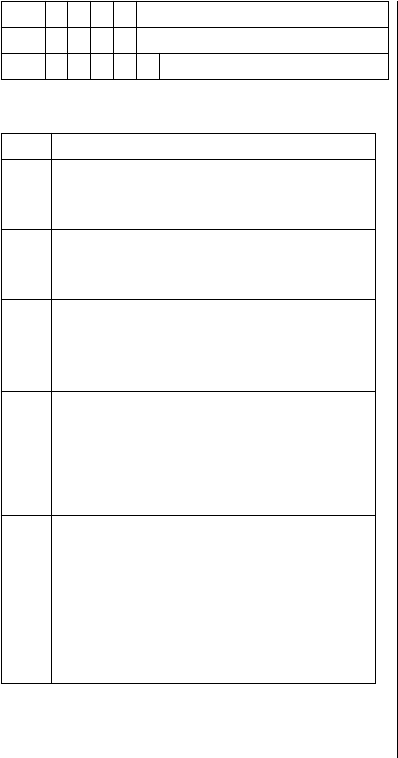
Phone Basics 47
The following table explains the roles other keys play while
you enter text.
7
q r s 7 (repeat)
8
t u v 8 (repeat)
9
wxyz9(repeat)
Key Explanation
*
Moves the I-beam cursor one character to the
left. If the cursor is a block cursor, it changes to
an I-beam cursor.
#
Moves the I-beam cursor one character to the
right. If the cursor is a block cursor, it changes
to an I-beam cursor.
S
Moves the I-beam cursor up or down one line in
the message. If the cursor is a block cursor, the
scroll buttons change the case of the
highlighted character.
-
Cancels the message field and returns you to
the text message form
before
you enter any
characters
Deletes the character to the left of the cursor
after
you have entered a character.
+
Takes you to the QuickNote menu, which lets
you select from a list of pre-written messages,
before
you enter any characters. See “Sending
a Message With a QuickNote” on page 113.
Accepts the message and returns to the text
message form
after
you have entered a
character.

48 Phone Basics
Controlling the Volume
Use the upper and lower volume keys to adjust earpiece,
keypad, and ringer volume. When you press these keys, the
phone’s speaker demonstrates the current volume level.
This audio feedback is called
keypad tones
. For more
advanced volume settings, refer to “Ring and Vibrate
Features.”
Earpiece Volume
You can adjust the earpiece volume
only
during a call.
Press the up volume key to increase earpiece volume.
Press the down volume key to decrease volume. A volume
meter in the display indicates the volume level you have
selected.
Ringer Volume
You can adjust the ringer volume when you are
not
on a
call. Press the up volume key to increase ringer volume,
and press the down volume key to decrease volume. A
volume meter in the display indicates the volume level you
have selected.
Keypad Volume
Refer to “Changing Keypad Volume” for details on adjusting
the keypad volume.

Phone Basics 49
The Smart Button
The smart button is the lower key on the left side of the
phone—easy to feel, easy to find, and easy to use. Use the
Smart Button to place and end calls, select menu items,
select items in a display, toggle features on and off, and
open your phonebook.
Place and End Calls
Use the smart button to place or to end a call as described
in “Placing a Call” on page 40 and “Ending a Call” on
page 41.
Select Menu or Display Items
When you access the menu system, you can press the
smart button to select a menu or display item.
Toggle Features On and Off
Some of the phone’s features toggle on and off. Use the
smart button to select the on or off setting of a feature.
Open Your Phonebook
Before you make a call, press the smart button to open your
phonebook. Press
S
to scroll to the phone number you
want, the press *smart button* again to place the call.
You can set up your smart button to open an application
other than the phonebook. Refer to “Personalizing Phone
Display Items.”

50
The Menu System
You can access many of the features in your phone through
a menu system. This chapter provides a table of menu
features and shows you how to navigate through the
menus. It also introduces you to the menu elements,
including lists, forms, and meters.
Menu Features
The menu is the gateway to accessing phone features. This
section provides a list and description of the menu features.
Menu Name Features Submenu
Features
Recent Calls Received Calls
Dial Calls
Notepad
Call Time
Call Cost
Service Dial Service Dial
Application
Fixed Dial Fixed Dial
Application
Phonebook Phonebook
Application
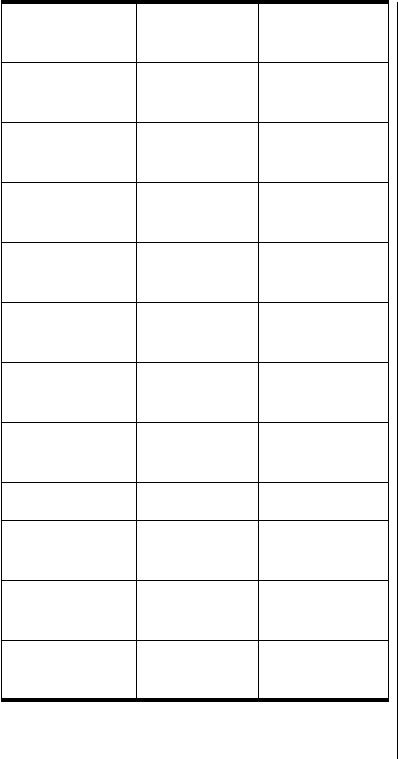
The Menu System 51
Datebook Datebook
Application
Quick Dial Quick Dial
Application
Radio Radio
Application
Messages Message
Application
SMS Interactive SMS Interactive
Application
Shortcuts Shortcuts
Application
VoiceNotes VoiceNotes
Application
mymotorola.com mymotorola.co
m Application
SIM Apps SIM Application
Browser Browser
Application
World TIme World Time
Application
Calculator Calculator
Application

52 The Menu System
Settings Ring/Vibrate Alert
Detail
Call Forward Voice Calls
Fax Calls
Data Calls
Cancel
Status
Phone Status My Tel. No.
Credit Available
Credit Info
PhoneLine 1/2
Signal Strength
Battery Meter
Other
Information
Connection IRDA Link
In Call Setup In Call Timer
Call Cost Setup
My Caller ID
Talk & Fax
Answer Options
Call Waiting

The Menu System 53
Note: Some features are optional network and
subscription-dependent features that are not available in all
areas. Contact your service provider for availability.
Navigating Through the
Menu
provides a detailed example of how to navigate through the
menu.
Settings Security Phone Lock
Lock Keypad
Lock Application
Talk Secure
Fixed Dial
Restrict Calls
Call Barring
User Group
SIM PIN
New Passwords
Other Settings Personalize
Initial Setup
Network
Car Settings
Head-set

54 The Menu System
Navigate through the menu system as follows:
When scrolling through menus, you can also use the keys
*
and
#
.
Menu Elements
Menu elements include lists, forms, and meters.
Lists
Lists present menu items, such as tasks or data items that
you can select. When you see a list, you can look at the
entries and select an item.
List Title
All lists begin with a title that identifies the information
contained in the list.
Scrollbar
If a list contains three or more entries, a scrollbar appears
on the right side of the display. The scrollbar indicates that
more items are included in the list than are currently
displayed on the screen.
M
Press the menu key to enter the menu
display.
- +
The soft keys are the two unmarked
keys at the top of your keypad.
S
Press the scroll key to move up or
down through menu items.

The Menu System 55
The scrollbar changes, depending on where you are in the
list.
•If unseen items are above the list, the scrollbar
contains an up arrow.
•If unseen items are below a list, the scrollbar contains
a down arrow.
When you see a scrollbar, press
S
to move up or down
through the list.
End of List Indicator
Lists can also contain an
end of list
indicator, such as
New
Entry,
that appears at the bottom of the list. You can often
select the end of list indicator to add new entries to the list.
Soft Key Function
Tip:
To move
quickly through
a list, press the
letter or
number key for
the selection
you want. The
list moves
automatically
to your
selection.
The
soft keys
are the two unmarked keys at the top of your
keypad. Their functions change, but their current function
names always appear in the lower corners of the display.
The last display line, just below a list, describes the function
of the soft keys
as they relate to the list
.
Following is a common use of soft keys:
Key Soft Function Action
M
M
activate a sub-menu
-
(left)
Exit
return to a previous
menu or exit the list
+
(right)
Select
select an item or
confirm an action

56 The Menu System
Some lists, like lists of messages, contain long text entries.
In such cases, the soft keys provide navigation through the
message as follows:
)
Forms
Forms allow you to add or change text or number
characters to update information stored in your phone. They
appear when you select a menu item to enter or change
information, such as a Phonebook entry. You can update
any part of the entry using the form. Refer to “Adding
Names and Numbers” on page xxx to learn how to enter
data.
Key Soft Function Action
-BACK
return to earlier lines in the
message
+MORE
ask for more text to go forward
through a message
+NEXT
ask for the next message when
you reach the last line of a
message
Begin
1. When you begin using a new or empty
form, press
-
to
CANCEL
; press
+
to
CHANGE
.

The Menu System 57
Enter
letters
2. When you enter character data, such
as letters for a name, in an empty field,
the flashing cursor appears on the
right.
Enter
numbers
3. When you enter numbers, such as for
a phone number, the flashing cursor
appears on the left.
Use soft
keys
4. While you’re entering data, navigate
as follows:
•Press
-
to
DELETE
.
•Press
+
to accept the data (
OK
).
After you’ve entered data, the soft
keys change:
•Press
-
to remove or
CLEAR
the
data that is entered.
•Press
+
to accept the data (
OK
).
Add
lines
5. When you complete and accept a line
of data, the form automatically
advances to the next line. Continue
entering information into the form.
Finish
6. When you have entered all the
required information, the soft keys
change again:
•Press
-
to accept the entry (
DONE
).
•Press
+
to
CHANGE
the entry.

58 The Menu System
Meters
Meters provide measurements stored in your phone, such
as how much talk time is left in your battery or how strong
the signal is from your wireless network. Meters also
appear on the display when you need to see or change a
volume.
You can display a meter by pressing a key. The meter only
appears for a few seconds and then disappears.
You can also display a meter by going through a menu. In
this case, press
-
to
EXIT
, and press
+
to dismiss
(
CHANGE
) or edit the setting.

59
Sending and Receiving Calls
Your phone provides several dialing options, from dialing
basic numbers to dialing stored numbers joined into a
single string. You can also receive basic phone calls and
calls with caller ID or call waiting.
In this chapter you will learn how to:
•dial numbers and special characters
•dial with Speed Dial and Turbo Dial®
•dial numbers from missed or recent calls, your
phonebook, or a text message
•add or attach stored numbers
•dial emergency numbers
•receiving a basic call
•using call waiting
•receiving calls with caller ID

60 Sending and Receiving Calls
Menu Features
Dialing Numbers and
Characters
The simplest way to dial a number is to enter the number
from the idle state and then send it. This section describes
how to dial numbers and enter special characters, such as
pauses.
To dial a number from the idle state:
Dialing
Attach Number
Insert Pause
Insert Wait
Insert ‘n’
Send Message
Dial
number
1. Enter the phone number.
2. Press
N
.
The phone displays
Calling . . .
(phone number)
.

Sending and Receiving Calls 61
Inserting Pause, Wait, and ‘n’
Characters for Calling Cards
You can insert the following types of characters, typically for
calling card numbers:
Shortcut:
While dialing,
press and hold
*
. The
phone will
cycle through
p
,
w
, and
n
.
Release the
*
when you
see the
character you
want.
To insert a pause, wait, or ‘n’ character in a number:
Inserting the International Dialing
Prefix
The international dialing prefix lets you call from any
country without knowing its international access code.
Pause
character
tells your phone to wait for a defined
length of time before it dials the next
digit in a series
Wait
character
tells your phone to wait for an
undefined length of time before it dials
the next digit in a series
‘n’
character
tells your phone to stop and prompts
you for a number before it continues
dialing
Insert
character
1. While dialing, press
M
.
2. Press
S
to scroll to
Insert Pause
,
Insert Wait
, or
Insert ÔnÕ
.
3. Press
+
.
The phone displays the special
character:
p
for pause,
w
for wait, or
n
for ‘n’.

62 Sending and Receiving Calls
To insert the international dialing prefix:
Dialing with Speed Dial
You can dial numbers from your phonebook without viewing
them first. Speed Dial lets you call any phonebook entry
just by entering the two-digit index number.
To dial with Speed Dial:
Dialing with Turbo Dial®
You can dial some numbers from your phonebook with the
press of a single key. Turbo Dial lets you call your first nine
phonebook entries (one to nine) just by entering their
single-digit index number.
Insert +
1. Before dialing any digits, press and
hold
0
.
The phone displays a
+
.
Dial
2. Enter the number and press
N
.
Dial
number
Press the phonebook entry’s index
number, followed by the
N
key.
The phone displays
Calling . . .
(entry phone number)
.
To see the index numbers for your
phonebook entries, refer to
“Phonebook” on page XX.

Sending and Receiving Calls 63
To dial with Turbo Dial:
Dialing Numbers from
Missed or Recent Calls
Your phone saves a list of phone numbers from the calls
that you recently dialed or received. You can view this list, or
even select one of the numbers and instantly place a call.
Dialing Missed Calls
Your phone tells you when you have missed a calls by
displaying
X
Missed Calls
, where
X
is the number of
missed calls.
Note: If your answering machine feature answers a call, it is
not considered missed.
Your display may also tell you that a missed call is one of
the following:
Dial
number
Press and hold the phonebook entry’s
index number for one second.
The phone displays
Calling . . .
(entry phone number)
.
To see the index numbers for your
phonebook entries, refer to
“Phonebook” on page XX.
Note: Pressing and holding
0
inserts
the international dialing prefix.
Unknown
the caller’s name or number is not available

64 Sending and Receiving Calls
If the caller’s number is not available , you cannot redial the
call with this procedure.
Shortcut:
From the
missed call
dialog, Press
and hold the
smart key to
dial the last
missed call.
To dial the number from a missed call:
Note: You can use
+
in place of the smart key in this
procedure.
Dialing Recent Calls
You can view the last ten calls that you dialed or received by
checking the lists under the Recent Calls menu.
To view or dial the number from a recent call:
Private
the caller’s name or number is intentionally
blocked by the caller or the network
Dial the
number
1. Press the smart key. The phone
displays the
Received Calls
list, with
the most recent call selected.
Press
S
to scroll to the number in the
list that you want to call. Calls are listed
from newest (10) to oldest (1).
2. Press
N
, or press and hold the smart
key to dial the selected number.
Find the
feature
1. Press
M
and navigate to the
feature
Recent Calls
.
Choose
dialed /
received
2. Press
S
to scroll to either
Received
Calls
or
Dialed Calls
.
3. Press
+
. The phone displays a list
of the last ten calls.

Sending and Receiving Calls 65
Dialing from the Phonebook
You can dial the numbers in your phonebook either from the
list view or the detail view.
To dial a number from your phonebook:
Dial the
number
4. Press
S
to scroll to the call you want
to dial. Calls are listed from newest
(10) to oldest (1).
5. Press
+
to dial the number of the
selected call.
Find the
feature
1. Press
M
and navigate to the
feature
Phonebook
.
The phone displays the phonebook’s
list view.
2. If you want to see an entry’s details,
press
S
to scroll to the entry and
press
+
.
Dial the
number
3. Press
S
to scroll to the entry you want
to call.
Icons next to the entries identify the
entries for work, home, main, mobiles,
faxes, or pagers.
4. Press
+
to dial the entry’s number.

66 Sending and Receiving Calls
Dialing from a Text Message
Phone numbers can be included in text messages. If you
view a text message with an embedded phone number, you
can call the number directly.
Your phone tells you when you have an incoming text
message.
Before you open the inbox, you must set it up. See Inbox
Setup on page XX. When you see this display, you can go
directly to the text message and dial the embedded
number, if there is one. Even if your phone is idle, you can
open your inbox and dial the embedded numbers in old
messages.
To view or dial a number from a text message:
From
new
msg
1. Press
+
.
The phone displays the text message
inbox.
or
From
idle
Press
M
and navigate to the
feature
Text Msgs
.
The phone displays the text message
inbox.

Sending and Receiving Calls 67
Adding or Attaching
Numbers
Sometimes you may want to dial a number from your
phonebook or recent calls list with a special prefix or suffix.
If you want to use a prefix, you can enter it and then
attach
a number from your list. If you want to use a suffix, you can
select the listed number and then
add
the suffix.
Use Call
Back
2. Press
S
to scroll to the message you
want.
Messages are listed from newest to
oldest (#1). You can press
+
to see
the full message and the call back
number.
3. .Press
M
.
The phone displays the Text Message
Menu.
4. Press
S
to scroll to
Call Back
.
5. Press
+
.
If a message has more than one
embedded number with no preferred
number, the phone displays a list of all
the numbers. Press
S
to scroll to the
number you want and press
+
.
The phone displays
Calling...
(phone number)
.

68 Sending and Receiving Calls
Attaching Digits While Dialing
This is an easy way to attach digits to the beginning of a
number from your phonebook or recent calls list. To attach a
number while dialing:
Enter
prefix
1. Enter the prefix—the numbers that
precede the number from your
phonebook or recent calls list.
Select
source
2. Press
M
.
3. Press
S
to scroll to
Attach Number
.
4. Press
+
.
The phone displays the attach menu,
with options such as phonebook and
dialed numbers.
5. Press
S
to scroll to the source of the
number you want to attach.
6. Press
+
.
The phone displays the list of numbers
from the source you selected.
Attach
number
7. Press
S
to scroll to the entry you want
to attach.
8. Press
+
.
9. The phone displays your prefix plus the
attached number. You can enter more
numbers to add to the end, or press
N
to dial.

Sending and Receiving Calls 69
Attaching Numbers from Your
Phonebook or Recent Calls List
You can attach two or more numbers stored in your
phonebook or recent calls list. To attach numbers in your
phonebook or recent calls list:
For
Phone-
book
1. Press
M
and navigate to the
feature
Phonebook
.
The phone displays the phonebook list.
or
For
Recent
Calls
Press
M
and navigate to the
feature
Dialed Calls
or
Received
Calls
.
The phone displays the list of recent
calls for the type you selected.
Select
first
number
2. Press
S
to scroll to the first number
you want to attach.
3. Press
M
.
4. Press
S
to scroll to
Attach Number
.
5. Press
+
.
The phone displays the attach menu,
with options such as phonebook and
dialed numbers.

70 Sending and Receiving Calls
Adding Digits to the End of a Number
You can open your phonebook or recent calls list, select a
number, and then add digits to the end of the number.
To add digits to numbers from your phonebook or recent
calls list:
Select
second
number
6. Press
S
to scroll to the source of the
second number you want to attach.
7. Press
+
.
The phone displays the list of numbers
from the source you selected.
8. Press
S
to scroll to the second
number you want to attach.
9. Press
+
to attach the number and
go to the idle number editor, or press
M
to attach another number (go to
step 4).
The phone displays the attached
numbers in the idle number editor.
10. Press
N
to dial.
For
Phone-
book
1. Press
M
and navigate to the
feature
Phonebook
.
The phone displays the phonebook list.
or

Sending and Receiving Calls 71
Dialing Emergency Calls
Your phone stores one or more emergency numbers, which
can only be changed by your provider or another authorized
technician. You should always know the emergency
numbers stored in your phone.
To dial an emergency number, simply enter the numbers
and press
N
, just like other number.
Emergency numbers are different, because you can dial
them even if the phone, keypad, and SIM card are locked.
You can also dial them if the SIM card is damaged or
missing.
For
Recent
Calls
Press
M
and navigate to the
feature
Dialed Calls
or
Received
Calls
.
The phone displays the list of recent
calls for the type you selected.
Attach
number
2. Press
S
to scroll to the entry to which
you want to attach a number.
3. Press
M
.
4. Press
S
to scroll to
Add Digits
.
5. The phone displays the selected
number in the idle number editor.
Enter
suffix
6. Enter the suffix—the numbers that will
follow the number you selected from
your list.
7. Press
N
to dial.

72 Sending and Receiving Calls
Refer to your phone provider for questions about the
emergency numbers stored in your phone.
Receiving a Basic Call
When a new call arrives, your phone notifies you with a new
call dialog and your chosen alert (for example, ring or
vibrate). When you receive a call:
Setup
Your phone notifies you with a new call
dialog and your chosen alert (for example,
ring or vibrate).
The phone displays information about the
caller if:
•you subscribe to caller ID service (CLI)
•the network issues a call waiting flash
with information
Choose
answer
or
Ignore
Complete one of the following:
•Press
N
or
+
to answer the call.
or
•Press
O
or
-
to ignore the call (the
network handles the call appropriately).
or
•Press and hold
O
for one second to end
the call without forwarding it to voicemail
or any other designated number.

Sending and Receiving Calls 73
Receiving Calls with Caller
ID
If you subscribe to caller ID (CLI), your phone usually
displays the caller’s name or number when a new call
arrives.
If the caller’s information is
not
available, the word
Private
is displayed in place of the information. You can choose to
answer or ignore these calls.
When you receive a call with no caller ID:
Using Call Waiting
If you subscribe to call waiting, your phone notifies you with
a call waiting tone if you receive a second call while you are
on another call. You can choose to switch to the other call or
not.
Note: If you already have an active call and another call on
hold, your phone does not notify you of additional incoming
calls.
Setup
An incoming call with no caller information
displays
Private
in place of the caller’s
information.
Choose
answer
or
ignore
Complete one of the following:
•Press
-
or
O
to ignore the call.
or
•Press
+
or
N
to answer the call. The
phone resumes normal function.

74 Sending and Receiving Calls
Call waiting is an optional feature. Contact your service
provider for information about availability.
Using Call Waiting on an Analog
System
When a second call arrives on an analog system, complete
the following:
Setup
While you are on a call, you hear a call
waiting tone, and the current call stays
active.
The phone displays a call waiting dialog
that identifies the new caller if:
•you subscribe to caller ID service (CLI)
•the network issues a call waiting flash
with info
If you see this notification, you can press
+
to answer the new call.
Answer
the new
call
1. Press
N
to switch to the new call and
put the current call on hold.
or
Press
O
to end the current call and
switch to the new call.
Switch
calls
2. If you put the original call on hold,
press
+
to return to it.
3. Press
O
to end the current call.
Your phone switches to the other call, if
present, or returns to the idle state.

Sending and Receiving Calls 75
Using Call Waiting on a Digital
System
When a second call arrives on a digital system:
Setup
While you are on a call, you hear a call
waiting tone, and the current call stays
active.
The phone displays a call waiting dialog
that identifies the new caller if your
technology supports this feature.
Answer
new call
1. Press
N
or
+
to switch to the new
call and put the current call on hold.
You see both calls on your display, with
a flashing phone icon next to the active
call.
or
Press
O
to end the current call and
switch to the new call.
or
Press
-
to ignore the new
incoming call. The network handles the
call appropriately.
Switch
calls
2. If you put the original call on hold,
press
+
to return to it.
3. You can press
-
to link the two
calls into a conference, so that you can
talk to both people at the same time.
See Conference Calls on pgXX. Press
O
to end the current call.

76
In-Call Features
Phone features that are available during an active call are
called
in-call features
. In this chapter you will learn how to:
•receive other calls
•look up your phone number, recent calls, phone book
entries, messages, and datebook items
•put a call on mute or hold
•dial/enter numbers, tones, and PIN numbers
•set up a three-way or conference call
•transfer calls
•use a speakerphone (handsfree mode)
Menu Features
Call Menu Call/Dial Menu
My Tel. Number Spkrphone On/Off*
Hold My Tel. Number
Mute/Unmute Hold
Talk to One** Mute/Unmute
Transfer Send Tones
New Call Attach Number
Dialed Calls Hide ID/Show ID
Received Calls Insert Pause
Messages Insert Wait
Datebook Insert ‘n’
Send Message

In-Call Features 77
* appears only if a speakerphone is connected to the phone
** appears only if a conference call is in progress
Receiving a Second Call
When you receive a second call while you are already on
the line, complete the following steps:
2 Calls Menu 2 Calls/Dial Menu
Spkrphone On/Off* Switch
Mute/Unmute Link
Transfer Spkrphone On/Off*
Phonebook Mute/Unmute
Dialed Calls Send Tones
Received Calls Attach Number
Messages Hide ID/Show ID
Datebook Insert Pause
Insert Wait
Insert ‘n’
Send Message
Setup
When a second call arrives, your
phone notifies you with a new call
dialog and an in-call tone.
The phone displays information about
the caller if either:
•you subscribe to caller ID service
(CLI)
•the network issues a call waiting flash
with information

78 In-Call Features
Sending and Receiving Data
or Fax Calls
While your phone is being used as a wireless modem to
send or receive data or fax calls, your phone cannot
perform any other functions. The following conditions occur:
Choose
answer
or
Ignore
Press
N
or
+
to answer the call.
or
Press
O
or
-
to ignore the call.
(The network handles the call
appropriately.)
or
Press and hold
O
for 1 second to end
the call without forwarding it to
voicemail or to any other designated
number.
Note: You can only keep two calls open at a
time. If a third call arrives while you already
have two calls open, your phone does not
notify you.
Fax call
Your phone queues all call waiting and
new events (incoming text messages,
voicemail, etc.) so that they reappear
after the fax is complete. You cannot
view or act on them during the fax call.

In-Call Features 79
For more details about these calls, refer to “Sending and
Receiving Data or Fax Calls” on page 78.
For details about how to handle a fax call that arrives while
you are on another call, refer to “Receiving a Second Call”
on page 77.
Viewing Your Phone Number
You can view your own phone number while you are on an
active call.
Data call
Your phone ignores all call waiting and
new events (incoming text messages,
voicemail, etc.) unless they are
supported by peripheral software. You
cannot view or act on them.
Find the
feature
1. Press
M
and navigate to the
feature
My Tel. Number
.
The phone displays its own telephone
number.
Exit
2. Press
-
to return to the active call
dialog.

80 In-Call Features
Muting a Call
You can turn off or
mute
your phone’s microphone during a
call. When you mute a call, you temporarily stop the caller
from hearing you.
Placing a Call on Hold
Your phone lets you put a call on hold.
Turn
mute on
1. Press
M
and navigate to the
feature
Mute
.
The phone displays the message
Mute is on
, followed by the
Mute
dialog.
Turn
mute off
2. Press
+
again to turn the mute
feature off and turn the microphone on.
Find the
feature
1. Press
M
and navigate to the
feature
Hold
.
or
Press
+
when the phone displays
Hold
above the key.
The phone displays an
On Hold
message, followed by the
On Hold
dialog.
Dial
another
call
2. Optionally, while a call is on hold, you
can press
-
to open the
phonebook and dial another call.
Exit
3. Press
+
to resume the call.

In-Call Features 81
Dialing and Entering
Numbers
You can enter digits during an active call, whether it is to
dial another number or to enter a password or credit card
number. Following are some of the tasks you can complete:
Enter
digits
Enter the digits on the keypad or select a
number from your phonebook or other list.
The digits appear in the active call dialog as
you enter them. The phone automatically
stores the digits to Notepad. Refer to “Using
the Notepad” on page 101.
Delete
digits
To delete a single digit, press
-
.
To delete all of the digits you entered, press
and hold
-
for one second.
Dial
number
To dial the number you entered, press
N
.
Refer to “Setting Up a Three-Way Analog
Call” on page 82 or “Using Digital
Conference Call Options” on page 83.
Create
phone-
book
entry
If you do not have a call on hold or muted,
you can create a phonebook entry by
pressing
+
.
Refer to “Storing Phonebook Entries” on
page 231.
•If you have a call on hold, pressing
+
will return to the call.
•If you have a call muted, pressing
+
will unmute the call.

82 In-Call Features
Setting Up a Three-Way
Analog Call
You can set up a three-way call on an analog network by
calling a third party during an active call. However, since
calls on hold have higher priority than three-way calls, you
cannot set up a three-way call if you already have a call on
hold.
Note: Three-way calling is an optional network feature.
Contact your service provider for information about
availability.
Send as
DTMF
If you do not have a call on hold, you can
send the numbers as Dual Time Multi-
Frequency (DTMF) tones, which are used
for passwords, credit card numbers, and
other codes.
For more detail, refer to “Sending Tones” on
page 88.
Send as
MMI
To send MMI commands , press
N
. Your
network may give you MMI commands to
perform certain tasks.
Time
Out
If you do not take any action within 20
seconds, the phone clears the digits you
entered. However, they are still stored in the
Notepad.

In-Call Features 83
To set up a three-way call on an analog network:
Using Digital Conference
Call Options
If you want to talk to several people at once, you can set up
a conference call. To do this, call each person separately
and add or link them to the call.
While you are connected to a conference call, you can also
choose to have a private conversation with one of the
people in the call.
Note: You can only set up one conference call at a time.
Conference calls are only available on digital networks. For
analog networks, refer to “Setting Up a Three-Way Analog
Call” on page 82.
Call
third
party
1. During an active call, dial the third
party and press
N
.
or
Select a number from your phonebook
or other list and press
N
.
Your phone will briefly display:
Dialing
(third party’s phone number)
Your active call display returns, and the
third party should be connected. Since
the phone does not receive any
indication of whether the call connects,
it does not display any notification.
Exit
2. Press
O
to disconnect.

84 In-Call Features
Setting Up a Conference Call
To set up a conference call:
Call
another
party
1. During an active call, dial the new party
and press
N
.
or
Select a number from your phonebook
or other list and press
N
.
Your phone displays the
Calling
and
Connected
dialogs while calling the
new party.
When your phone returns to the active
call display, you see a list of the
connected calls, with a hold icon
n
next to the call on hold and an active
icon
q
next to the active call.
Link
calls
2. Press
-
to link the two calls.
Your phone links the new call to the
previous call.
To add more people to the conference
call, repeat these two steps. Since you
can only keep two calls open at once,
you must link each new call to the
conference before making another call.
Exit
3. Press
O
to disconnect.

In-Call Features 85
Setting up a Private Call From a
Conference Call
Note: This feature is only available if you initiated the
conference call and no one else is on hold.
To step out of a conference call and set up a private call
with one of the participants, complete these steps:
Find the
Feature
1. During an active conference call, press
M
and navigate to the feature
Talk to One
.
Your phone displays the
Talk only
with
menu, listing all the parties in the
conference call.
Select a
single
party
2. Scroll
S
to the party with whom you
want to have a private call.
3. Press
+
.
You begin a private call with the
selected party. The conference call is
on hold, but its participants can
continue to converse.
Return
to conf.
call
4. To return to the conference call:
Press
-
to link both of you back
into the conference call.
or
Press
+
to put the private call on
hold and return temporarily.
Exit
5. Press
O
in the conference call to
disconnect.

86 In-Call Features
Transferring a Call
When you receive a call, you can transfer the call to another
phone, called the
target phone
. This section describes how
to use a warm and a cold transfer.
Using a Warm Transfer
A
warm transfer
permits you to speak to the person who
answers the target phone first. You can tell them whom you
are transferring or why, before you transfer the call.
To transfer a call with a warm transfer:
Put call
on hold
1. When you are talking to someone who
you want to transfer to another phone
number, Press
M
. Press
S
to
scroll to
Hold
.
2. Press
+
.
The phone displays the
On Hold
dialog. Refer to “Placing a Call on
Hold” on page 80.
Call
target
phone
3. Dial the target phone number and
press
N
to call.
or
Select a number from your phonebook
or other list and press
N
to call.
The phone displays the
2 calls
dialog.
4. Speak to the person who answers the
target phone.

In-Call Features 87
Using a Cold Transfer
A
cold transfer
sends an active call directly to another
phone, without giving you the chance to speak to the
person on the target phone.
To transfer a call with a cold transfer:
Transfer
the call
5. Press
M
. Press
S
to scroll to
Transfer
.
6. Press
+
.
The phone displays the
Transfer
confirmation dialog.
7. Press
+
to confirm the transfer.
The phone displays the
Transferring
dialog and the transfer is complete.
Choose
transfer
1. When you are talking to someone you
want to transfer to a target phone,
press
M
B
Transfer
.
The phone displays the
Transfer to
dialog.
Transfer
the call
2. Dial the target phone number and
press
N
to call.
or
Select a number from your phonebook
or other list and press
N
to call.
The phone displays the
Transferring
dialog and the transfer is complete.

88 In-Call Features
Sending Tones
You can enter digits and send them as Dual Time Multi-
Frequency tones (DTMF) tones. These tones are used to
access automated calling systems, such as credit card
entry, password entry, or number linking. Your phone
transmits DTMF tones when you press a key on the
keypad.
This feature only applies in certain situations, such as when
you are on an active call, dialing, or viewing your
phonebook, dialed calls, or received calls.
To send tones:
Entering a PIN (Analog)
On some analog networks, you have to enter a PIN
(Personal Identification Number) to dial certain numbers.
If your Auto-PIN feature is turned on, you can send your
PIN with the press of a button whenever required.
Enter
digits
1. Enter the digits on the keypad or select
a number from your phonebook or
other list.
Send
tones
2. Press
M
. Press
S
to scroll to
Send Tones
, and press
+
.
or
Press and hold
N
for one second.
You can hear the tones in your
earpiece as the phone sends them to
the network.

In-Call Features 89
Otherwise, you can enter your PIN digits and then send
them.
To dial a number with a PIN:
Viewing Entries
Recent Calls
You can view your list of recent calls while you are on a call.
The list shows you the names or numbers from calls you
Dial
number
1. Enter the number you want to dial and
press
N
.
Send
PIN
2. If the network requires a PIN for this
number, complete one of the following
steps:
a. If Auto-PIN is on, your phone
displays the
Send PIN Code
dialog.
Press
+
or
N
to send your PIN.
or
b. If Auto-PIN is off, you hear the
network prompt (beep or recording),
and your phone displays the
Connected
dialog.
Enter your PIN and press
N
to send
your PIN.
The call proceeds to connect.

90 In-Call Features
recently dialed or received. To view the recent calls list
during a call:
The Phonebook
You can open your phonebook during a call, to see a list of
your entries. To view your phonebook during a call:
Display
the list
1. Press
M
.
2. Press
S
to scroll to
Dialed Calls
or
Received Calls
, depending on which
list you want to see.
3. Press
+
.
Your phone displays the list of the ten
most recent calls, numbered from the
oldest (1) to the most recent (10).
For more details, refer to “Recent
Calls” on page 93.
Exit
4. Press
-
to return to the active call.
Display
phone-
book
1. If you have only one call, press
-
.
or
If two calls are active, press
M
.
Then press
S
to scroll to
Phonebook
,
and press
+
.
Your phone displays your list of
phonebook entries. For more detail,
refer to “Using the Phonebook” on
page XX.
Exit
2. Press
-
to return to the active call.

In-Call Features 91
Messages
During a call, you can look at your messages from any
category, such as Voicemail or Text. To view your messages
during a call:
The Datebook
During a call, you can open your datebook and view, edit, or
create entries. To view your datebook during a call:
Display
message
menu
1. Press
M
.
2. Press
S
to scroll to
Messages
.
3. Press
+
.
Your phone displays the
Message
Center
menu, where you can select
the messages you want to see. For
more detail, refer to “Using the
Message Center” on page XX.
Exit
4. Press
-
to return to the active call.
Display
date-
book
1. Press
M
.
2. Press
S
to scroll to
Datebook
.
3. Press
+
.
Your phone displays your datebook,
where you can select days to view and
edit. For more detail, refer to “Using the
Datebook” on page XX.
Exit
4. Press
-
to return to the active call.

92 In-Call Features
Using a Speakerphone
(Handsfree Mode)
If you connect your phone to an external earpiece and
microphone, you can switch your phone to communicate
through this handsfree device. You can even do this during
a call.
Note: Speakerphone options are not available on phone
menus unless a speakerphone is plugged into the phone.
To switch to a speakerphone during a call:
Switch
speaker
on
1. Press
#
.
Your phone displays a
Spkrphone On
notification.
Switch
speaker
off
2. Press
#
.
Your phone displays a
Spkrphone Off
notification.

93
Recent Calls
Your phone keeps track of the most recent calls you dialed
and received. You can find out what numbers you called (or
what numbers called you) and how long the calls lasted.
In this chapter you will learn how to:
•look at your list of received calls and use its options
•look at your list of dialed calls and use its options
•use the notepad
•view and reset your call timers
Menu Features
Tips for the Received Calls
List
Your phone keeps a list of numbers for calls that you most
recently received—both calls that you answered and calls
that you missed. This list tells you the caller’s name and
Recent Calls Last Calls
Received Calls Store
Dialed Calls Delete
Notepad Delete All
Call Time
Send Message
Add Digits
Attach Number
Send Tones

94 Recent Calls
number (if available) and whether you spoke to the caller or
not.
•The list entries are sorted from newest (10) to oldest (1).
•Each call is represented by the name or, if the name is
unavailable, the number of the other party.
•An icon next to an entry indicates if you answered the
call or have since placed a call to the number.
•Unknown entries and duplicate entries are included in
the list as individual entries.
•Fax and data calls are included in the list, with any
unrecognizable characters represented by an asterisk
*
.
•SIM or Browser programs may not provide a number to
call back. You can call back the entry if a name is
present, but if none is present and the program
suppressed the number, then the call does not appear in
the list.
•The list reflects changes in the phonebook. For example:
If you make a phonebook entry for a number in the list
and assign a name to it, the list updates to show the
name.
•If caller information is unavailable, the entry says
Unknown
.
•If caller information is withheld, the entry says
Private
.
•The list includes calls that are answered by network
voicemail.
Tips for the Dialed Calls List
Your phone keeps a list of the numbers that you called most
recently. This list tells you the caller’s name (if available)

Recent Calls 95
and number, and it indicates whether they answered the
call or not.
•The list entries are arranged from newest (10) to oldest
(1).
•Each call is represented by the name or, if the name is
unavailable, the number of the other party.
•Conference calls do not appear as entries in the list.
Each call placed to each member of the conference is a
separate dialed calls entry.
•Duplicate entries are included in the list as individual
entries.
•Fax and data calls are included in the list.
Viewing the Received Calls or Dialed
Calls List
To view the received calls or dialed calls list:
Find the
feature
1. Press
M
and navigate to the
feature
Recent Calls B
Received Calls
or
Dialed Calls
.
The phone displays the list.

96 Recent Calls
Complete
tasks
2. You can press
S
to scroll to an entry
and complete one or more of the
following tasks:
•Press
N
to call the entry’s number.
•Press and hold
N
for one second
(with a call in progress) to send the
entry’s number as DTMF tones.
•Press
+
to view the entry’s
details, if
View
appears above the
key. Refer to “Viewing Details for
Received Calls and Dialed Calls”
on page 98.
or
Press
+
to store the entry’s
details in the phonebook, if
Store
appears above the key. Refer to
“Storing Phonebook Entries” on
page 231.
•Press
M
to open the Last Calls
menu. Refer to “Received Calls and
Dialed Calls Menu Options” on
page 97.
Exit
3. Press
-
to return to the previous
dialog
or
Press
O
return to the main dialog.

Recent Calls 97
Received Calls and Dialed Calls
Menu Options
If you are viewing the received calls or dialed calls list, or
the details of a received calls or dialed calls list entry, you
can press
M
to see the following options:
Store
Create a new phonebook entry, with the
selected number in the
Tel No.
field. Refer
to “Storing Phonebook Entries” on
page 231.
This option is not available if
Store
appears on the list dialog.
Delete
or
Delete
all
Refer to “Deleting Entries from the
Received Calls or Dialed Calls List” on
page 100.
Send
msg.
Create a new message, with the selected
number in the
Tel No.
field. Refer to
“Sending a Text Message” on page 113.
Add
digits
Add digits to the end of the selected
number. Refer to “Adding Digits to the End
of a Number” on page 70.
Attach
number
Attach digits to the beginning of the
selected number. You can either use the
keypad or select another number from your
phonebook or other list. Refer to “Adding or
Attaching Numbers” on page 67.

98 Recent Calls
Viewing Details for Received Calls
and Dialed Calls
To view a call’s details in the received calls list:
Send
tones
Send tones, only with a call in progress.
Refer to “Sending Tones” on page 88.
Find the
feature
1. Press
M
and navigate to the
feature
Recent Calls B
Received Calls
or
Dialed Calls
.
The phone displays the list.
Select
entry
2. Press
S
to scroll the desired entry.
If details are available, the phone
displays
View
over the
+
.
If details are not available, the phone
displays
Store
over the
+
. This
opens a new phonebook entry with
the call’s number in the
Tel No
field.
To complete this entry, refer to
“Storing Phonebook Entries” on
page 231.
3. Press
+
to see an entry’s details,
if they are available.
The details form includes: caller
name, caller number, start date and
time, and duration.

Recent Calls 99
Complete
tasks
4. You can complete the following tasks
from the received calls details form:
•Press
-
to close the entry’s
details and return to the list.
•Press
+
to delete the entry (if
a phonebook entry already exists
for the entry’s number)
or
Press
+
to create a phonebook
entry for the entry’s number, if one
does not exist. Refer to “Storing
Phonebook Entries” on page 231.
•Press
N
to place a call to the
entry’s number, if you do not
already have two calls open.
•Press and hold
N
for one second
(with a call in progress) to send the
entry’s number as DTMF tones.
•Press
M
to open the Last
Calls menu. Refer to “Received
Calls and Dialed Calls Menu
Options” on page 97.
Exit
5. Press
-
to return to the previous
dialog
or
Press
O
return to the main dialog.

100 Recent Calls
Deleting Entries from the Received
Calls or Dialed Calls List
To delete entries in the received calls list:
Find the
feature
1. Press
M
and navigate to the
feature
Recent Calls B Received
Calls
or
Dialed Calls
.
The phone displays the list.
Delete
entry
2. Press
S
to scroll the entry you want to
delete.
If you want to delete all of the entries,
select any entry and continue.
3. Press
M
.
4. Press
S
to scroll to
Delete
.
If you want to delete all of the entries,
select
Delete All
instead.
5. Press
+
.
The phone displays a delete
confirmation dialog.
6. Press
-
to confirm the deletion.
Exit
7. Press
-
to return to the previous
dialog
or
Press
O
return to the main dialog.

Recent Calls 101
Using the Notepad
Your phone uses a notepad to store the most recent string
of digits entered. You can use this notepad to recall the last
number you entered, even if you did not place a call.
Example: You enter a number, but decide not to dial it yet.
You turn off your phone. Later, you decide to dial the
number, so you turn on your phone again. The number
does not appear on the display, but it is still on the notepad.
The notepad even records digits that you enter during a call
or other activity. It stores these digits until they are cleared
from the display and you dial new digits.
To view the Notepad:
Find the
feature
1. Press
M
and navigate to the
feature:
Recent Calls B Notepad
The phone displays the digits on the
notepad.
Complete
tasks
2. You can complete the following tasks
from the Notepad dialog:
•Press
-
to delete the numbers one
at a time.
•Press
M
to open the phonebook
menu. Refer to “Storing Phonebook
Entries” on page 231.

102 Recent Calls
Viewing or Resetting Call
Timers
Your phone keeps track of the amount of time you spend on
calls. This time is broken down into five different categories,
each of which is a separate timer:
Last Call timer—the time spent on the last call you dialed
or received (cannot be manually reset)
Dialed Calls timer—the total amount of time you spent on
all dialed calls since the last time you reset this timer
Received Calls timer—the total amount of time you spent
on all received calls, since the last time you reset this timer
All Calls timer—the total amount of time you spent on all
calls (dialed and received) since the last time you reset this
timer
Lifetime timer—the total amount of time spent on all calls
ever made on this phone (cannot be manually reset)
•Press
+
to open the new
phonebook entry form, with the
notepad number copied into the
Tel
No.
field. Refer to “Storing Phonebook
Entries” on page 231.
Exit
3. If the notepad is empty, press
+
to return to the recent calls menu.
or
Press
O
to return to the phone’s main
dialog at any point.

Recent Calls 103
To view or reset your call timers:
Find the
feature
1. Press
M
and navigate to the
feature:
Recent Calls B Call Times
The phone displays the call times
menu.
View
time
2. Press
S
to scroll to the call timer you
want to see (for call timer definitions,
refer to the timer list that precedes this
procedure).
3. Press
+
.
4. The phone displays the time recorded
by the selected call timer.
Reset
time
5. If you want to reset the time, press
+
.
The phone displays a
Reset Timer
confirmation.
To confirm the reset, press
-
. The
phone resets the timer and returns you
to the call times menu.
To cancel, press
+
.
Exit
6. Press
-
to return to the call times
menu (if you are still viewing a call
timer).
or
Press
O
to return to the main dialog.
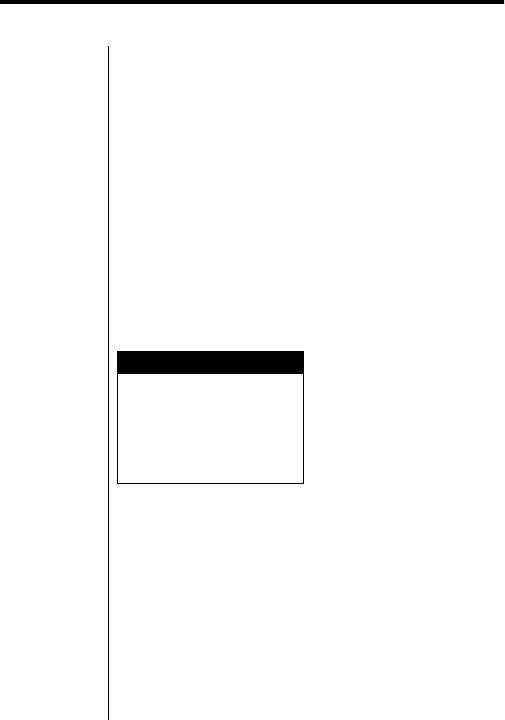
104
Call Forwarding
You can tell your phone to forward your calls to another
phone number, and you can assign a different number to
different types of calls—voice, fax, or data. You can even
provide second forwarding numbers for voice calls, in case
the first number is busy or unanswered.
In this chapter you will learn how to:
•set up your call forwarding
•check your call forwarding settings on the network
•turn off your call forwarding
Menu Features
Call Forward
Voice Calls
Fax Calls
Data Calls
Cancel All
Forward Status

Call Forwarding 105
Setting up Call Forwarding
Your phone lets you specify which types of calls you want to
forward—voice, fax, or data, and how you want to forward
them. You have three field options for forwarding calls:
Note: You can choose any of the above for voice calls, and
you can choose either
All Calls
or
If Unavailable
for
fax and data calls.
All Calls
This forwards all of your calls of the
selected type.
You want all of your voice calls to go to
the same number without ringing on
your phone.
If
Unavailable
This forwards calls of the selected type
if your phone is out of range,
unanswered, or turned off.
You want all of your voice calls to go the
same number, if you do not answer
them first.
Detailed
This lets you specify three different
forwarding numbers.
Your phone can forward calls to one
number if you are busy, another one if
your phone is off or out of range, and a
third number if you do not answer your
phone.

106 Call Forwarding
To set up call forwarding:
Find the
feature
1. Press
M
and navigate to:
Settings B Call Forward
The phone displays the call forward
menu.
Select
call type
2. Press
S
to scroll to the call type you
want to set up:
Voice Calls
,
Fax
Calls
, or
Data Calls
.
3. Press
+
.
The phone displays the call type form.
Select
Forward
option
4. Select an option in the
Forward
field:
a. Press
S
to scroll to
Forward
.
b. Press
+
to open the
Forward
field list and press
S
to scroll to the
field option you want to select.
(Detailed is not available for fax or
data calls.). Press
-
to store
your selection and return to the call
type form.
or
Press
*#
to scroll through the
Forward field options to the field
option you want to select.

Call Forwarding 107
Open
number
editor
5. Press
S
to scroll to the
To
field.
For Detailed forwarding, the
To
field is
replaced by the
If Busy
,
If No
Answer
, and
If Unreachable
fields.
Complete these fields as follows (the
same as the To field).
6. Press
-
to open the field editor.
or
Enter the forwarding number using the
keypad. The field editor opens
automatically.
Select
or enter
number
7. Press
+
to browse through the
numbers in your phonebook or recent
calls.
The phone displays a browse menu
with selections such as Voicemail and
Phonebook.
8. Press
S
to scroll to the list you want
and press
+
to view the list. (If you
select Voicemail, the phone enters your
voicemail number or prompts you for
one.) Press
S
to scroll to the number
you want and press
+
to select it.
Browse is only available before you
enter any characters in this field.
or
Enter the forwarding number using the
keypad.

108 Call Forwarding
Checking Call Forward
Status
Sometimes, network settings interfere with the call
forwarding you set up on your phone. You can check your
call forwarding status on the network to make sure the
settings match what you want.
To check your call forward status on the network:
Edit and
cancel
or store
number
9. After you enter digits, you can:
•Press
-
to delete digits
•Press
-
(with all digits deleted)
to cancel
10. Press
+
to store the number and
return to the entry form.
Exit
11. Press
-
to close the entry form
and store your changes.
12. Press
-
to return to the settings
menu.
or
Press
O
to return to the main dialog.
Find the
feature
1. Press
M
and navigate to:
Settings B Call Forward B
Forward Status
The phone displays the forward status
menu.

Call Forwarding 109
Turning Off Call Forwarding
You can switch your call forwarding off for a single type of
call—voice, fax, or data, or for all calls together.
Select
call type
2. Press
S
to scroll to
Voice Calls
,
Fax
Calls
, or
Data Calls
.
3. Press
+
.
The phone displays the call type form,
with the fields that you completed
when you set up your call forwarding.
Examine the fields to make sure they
match what you want. (You cannot
modify the fields here.)
You can press
+
to see each field’s
details. To make changes, refer to
“Setting up Call Forwarding” on
page 105.
Exit
4. Press
-
to close the form.
5. Press
-
to return to the call
forward menu.
or
Press
O
to return to the main dialog.

110 Call Forwarding
To turn of call forwarding:
Find the
feature
1. Press
M
and navigate to:
Settings B Call Forward
The phone displays the call forward
menu.
Turn off
call
forward
for all
calls
2. To turn off call forwarding for all types
of calls together—voice, fax, or data:
a. Press
S
to scroll to
Cancel All
.
b. Press
+
.
Turn off
call
forward
for a
call type
3. To turn off call forwarding for a specific
type of call:
a. Press
S
to scroll to
Voice Calls
,
Fax Calls
, or
Data Calls
(the
one you want to turn off).
b. Press
+
.
The phone displays the call type
form.
c. Press
S
to scroll to
Forward
.
d. Press
+
, press
S
to scroll to
Off
, and press
-
to store your
selection and return to the call type
form.
or
Press
*#
to scroll through the
Forward field options to
All Calls
,
If Unavailable
, or
Detailed
.

Call Forwarding 111
e. Press
-
to return to the call
forward menu.
Although your forwarding number
fields disappear, their data is not
lost. Your forwarding numbers return
when you re-select All Calls, If
Unavailable, or Detailed.
Exit
4. Press
-
to return to the settings
menu.
or
Press
O
to return to the main dialog.

112
Calls and Messages
In addition to voice calls, your phone can send and receive
text and fax messages.
Your phone incorporates several dialing options to give you
the most versatility and ease of use. This chapter describes
how to use these options, from basic number dialing to
joining stored numbers into a single string.
In this chapter you will learn how to:
•use the keypad to enter text
•send a text message
•send data and fax calls
•receive a call or fax
•use call waiting
Menu Features for Calls and
Messages
Dialing
Attach Number
Insert Pause
Insert Wait
Insert ‘n’
Send Message

Calls and Messages 113
Sending a Text Message
You can use your phone to create and send text messages.
You can start either with a blank message or a QuickNote.
QuickNotes are little pre-written messages that you can
select, edit, and send, such as
Call me at
...
You can also create your own QuickNotes. If a QuickNote
matches what you want to say, you can save time by
selecting it to start your message.
Sending a Message With a QuickNote
To send a text message with a QuickNote:
Find the
feature
1. Press
M
and navigate to the
feature
Quicknotes
.
The phone displays the QuickNote list.
If a QuickNote is longer than the list
display, you can press
S
to scroll to it
and press
+
to read it.
Select
Quick-
Note
2. Press
S
to scroll to the QuickNote you
want and press
N
.
The phone displays the text message
form, with your selected QuickNote in
the
Msg:
field.

114 Calls and Messages
Enter To
#
3. Press
S
to scroll to the
To:
field.
4. Press
+
.
The phone displays the
To:
editor.
5. Press
+
to browse through the
numbers in your phonebook or recent
calls. The phone displays a browse
menu, containing
Received Calls
,
Dialed Calls
, and
Phonebook
. Press
S
to scroll to the list you want and
press
+
to see the list. Then Press
S
to scroll to the number you want and
press
+
to select it.
Browse is only available before you
enter any characters in this field.
or
Use your number keys to enter the
number.
6. Press
+
to return to the text
message form.
Edit
msg
7. Press
S
to scroll to the
Msg:
field.
8. Press
+
.
The phone displays the message
editor, containing your selected
QuickNote.

Calls and Messages 115
9. Use the keypad to add any extra text,
as described in “Using the Keypad to
Enter Text” on page 45.
10. When you finish entering text, press
+
to return to the text message
form.
Enter
Priority
11. Press
S
to scroll to the
Priority:
field.
You can use
*
#
to scroll through
the priority options without opening the
Priority menu (when complete, skip to
step 15).
12. Press
+
.
The phone displays the priority menu.
13. Press
S
to scroll to the priority you
want.
14. Press
+
to return to the text
message form.
Enter
Call #
15. Press
S
to scroll to the
Call:
field.
16. Press
+
.
The phone displays the call editor.
17. Enter the number that you want your
recipient to call back (the From number
for your message).
18. Press
+
to return to the text
message form.

116 Calls and Messages
Sending a Message Without a
QuickNote
To send a text message without a QuickNote:
Send
msg
When you have completed the fields in the
text message, continue with these steps:
19. From the text message form, press
-
.
20. .The phone displays the Send
Message dialog.
21. Press
-
to send the message
or
Press
+
to cancel. If you cancel,
select one of the options, such as
Save
to Drafts
.
Enter
prefix
1. From the idle display, enter the number
to which you are sending the message.
Open
new
msg
form
2. Press
M
.
3. Press
S
to scroll to
Send Message
.
4. Press
+
.
The phone displays the text message
form, with the number you entered in
the
To:
field.
Note: You can also open this form by
selecting
Create Message
to complete
the
To:
field.

Calls and Messages 117
Enter
msg
5. Press
S
to scroll to the
Msg:
field.
6. Press
+
.
The phone displays the message
editor.
7. Enter your message using the keypad
as described in “Using the Keypad to
Enter Text” on page 45.
8. When you finish entering text, you can
press
+
to return to the text
message form.
Enter
Priority
9. Press
S
to scroll to the
Priority:
field.
You can use
*
#
to scroll through
the priority options without opening the
Priority menu.
10. Press
+
.
The phone displays the priority menu.
11. Press
S
to scroll to the priority you
want.
12. Press
+
to return to the text
message form.

118 Calls and Messages
Sending Data and Fax Calls
If your phone is connected to a computer or fax machine,
you can use it as a wireless modem to send and receive
information.
You can connect your phone using an infrared (IRDA) link.
Once your phone is connected, you can send fax and data
calls through your phone by initiating them on the machine
connected to it. You can also receive fax and data calls on
Enter
Call #
13. Press
S
to scroll to the
Call:
field.
14. Press
+
.
The phone displays the call editor.
15. Enter the number that you want your
recipient to call back (the
From
number
for your message).
16. Press
+
to return to the text
message form.
Send
msg
When you have completed the fields in the
text message, continue with these steps:
17. From the text message form, press
-
.
18. .The phone displays the Send
Message dialog.
19. Press
-
to send the message or
press
+
to cancel. If you cancel,
select one of the options, such as
Save
to Drafts
.

Calls and Messages 119
your phone, sending the information directly to the machine
connected to it.
Two types of data and fax calls are available:
Tip:
To set up
an IRDA
connection,
your phone
must be within
one meter
(with nothing
interfering in
the line of
sight) of the
other IRDA-
compatible
device.
To send a data or fax call:
Active calls
occur when a machine connected to
your phone sends data or a fax
(All of your other phone functions are
temporarily unavailable, and any calls
are put on hold.)
Background
calls
occur when a program on your phone
sends data or a fax (such as a browser
making a packet data call to exchange
data)
Set up
IRDA
link
1. Press
M
and navigate to the
feature
IRDA Link
.
The phone displays
Infrared Link
Connecting
, then
IRDA Link is
active
.
If the IRDA link fails, you have the option
of trying again.

120 Calls and Messages
Receiving a Fax
You can receive incoming faxes through your phone. When
a fax call arrives, your phone rings and displays a new call
dialog.
Note: If a fax call arrives while you are on another call, refer
to “Using Call Waiting” on page 73.
To send a fax call directly to a fax machine, connect your
phone to a fax machine with an infrared (IRDA) link. Once
About
the
IRDA
link
•The link remains active until the
connected machine begins a transfer, but
closes if no transfer begins within 60
seconds.
•If the connection is lost, the phone
continues to display
IRDA Link is
active
for 15 seconds while it tries to re-
establish the connection.
•You cannot leave this dialog without
closing the connection.
-To restart the connection, press
+
.
-To close the connection, press
-
.
Initiate
the
transfer
2. Initiate the data or fax call from the
connected machine.
Your phone displays the data or fax
dialog.
Exit
3. Press
-
to end the connection when
the call is complete.

Calls and Messages 121
your phone is connected, you can also send fax and data
calls through your phone by initiating them on the machine
connected to it.
You can receive both data and fax calls, as described in
“Sending Data and Fax Calls” on page 118.
When you receive a fax call:
Setup
Your phone notifies you of an incoming fax
according to the selected fax alert. Refer to
“Selecting a Ring/Vibration for a Specific
Event” on page 225).
Answer
fax
1. Press
+
to set up an infrared link, if
your phone supports IRDA and is not
connected to a peripheral device.
To set up an IRDA connection, your
phone must be within one meter (with
nothing interfering in the line of sight) of
the other IRDA-compatible device.
or
Press
-
to ignore the fax. The
network handles the fax appropriately.
or
Press and hold
O
for 1 second to end
the fax without sending it to a fax
mailbox or any other designated
number.

122 Calls and Messages
Setting
up IRDA
link
2. If you selected an infrared link, the
phone attempts to set up the link:
•If the link is successful, the call can be
answered by the peripheral device.
Refer to Using Infrared Links on XX.
•If the connection is lost, the phone
continues to display
IRDA Link is
active
for 15 seconds while it tries to
re-establish the connection.
•If the link is unsuccessful, the phone
gives you the option to try again or quit.

123
Messages
You can check on several types of messages in your
phone’s message center. In this chapter you will learn how
to:
•receive new messages
•read and manage messages
•set up inboxes for messages
•access voicemail messages
•manage QuickNotes
•use your outbox
•use your drafts folder
•check memory and clean up all messages
Menu Features for Messages
Msg Centr Text Msg
New Message Call Back
Cleanup All Go To
Memory Meter Reply
VoiceMail Setup Lock
Text Msg Setup UnLock
Info Srvc Setup Store Number
Outbox Setup Delete
Delete All
New
Setup

124 Messages
Types of Messages
You can send and receive the following types of messages:
Receiving New Messages
When you receive a new message, your phone displays a
new message dialog and gives an alert—a sound or
vibration, unless you set your alert to silent.
A new message dialog is displayed:
New
(message type)
message
X
New
(message type)
messages
where
message type
can be
VoiceMail
,
Text
,
Info.
Service
, or
Browser
. If you receive more than one
message, then
X
is the number of new messages. One of
VoiceMail messages that are stored on the network
rather than on your phone
Text
Messages brief text messages, sometimes including
phone numbers or URLs
Information
Services broadcast or browser messages
QuickNote customizable pre-written text messages
that you can send quickly
Drafts
Folder messages that you have written but have
not sent yet

Messages 125
the following message icons is displayed at the top of your
dialog:
Notes:
•If reminders are turned on, your phone plays a
reminder every five minutes until you close the new
message dialog, read the message, or turn off your
phone.
•If you turn off your phone, the new message dialogs
reappears five minutes after you turn it on again.
•If another type of message arrives while the new
message dialog is still open, the newest message
dialog overrides the older one. Once you close or
read the newest message, the older one comes up
again.
•Your phone does not display new message dialogs if
you are in a detailed view or already in the message
center.
New
message
P
You have new text, information service, or
browser messages in your message center.
New
VoiceMail
O
You have new VoiceMail messages (or any,
depending on your network).

126 Messages
When you see a new message dialog:
Text and Information
Services Messages
Text messages
are brief messages that you can enter,
send, and receive. You use your number keypad to enter
Respond
to new
msg
dialog
Press
-
to close the new message
dialog and return to your previous
state.
or
Press
+
to review the message or
messages.
Receive
new
msg
If you chose to receive the new
message, your phone does one of the
following:
•dials your VoiceMail (for VoiceMail
messages)
•displays the message (for a single
new text, info. services, or browser
message)
•opens the appropriate inbox (for
multiple new text, info services, or
browser messages)
Respond
to new
msg
For instructions on responding to,
saving, or deleting the new message,
refer to the appropriate section in this
chapter.

Messages 127
the message text (refer to “Using the Keypad to Enter Text”
on page 45).
Information Service
s are information messages delivered
via Broadcast or a Browser service. They can include stock
updates, news headlines, and so on. You usually have to
subscribe to the service.
Unlike text messages, new information services messages
can overwrite old unlocked messages in the information
services inbox. If the inbox is full of locked messages, the
phone cannot receive any new information services
messages.
Reading and Saving Messages
You can open your message inbox at any time to read the
stored text and information service messages.
Before you can use your inbox, you need to set it up. Refer
to “Information Services and Text Message Inboxes” on
page 138.
Note: If you open a message directly from the new
message dialog, you can skip the Find the feature and
Open msg steps in the following procedure.
To read a text or information services message:
Find the
feature
1. Press
M
and navigate to
Messages
.
The phone displays the
Message
Center
.

128 Messages
To the right of each message type is a
count of the new/total messages for
that type.
2. Press
S
to scroll to
Text Msgs
or
Info Srvc
.
3. Press
+
.
If you have one unread text message,
your phone opens the unread
message.
Otherwise, your phone displays the
inbox, sorting messages from newest
(highest number) to oldest (number
one). The following icons can appear
next to the messages:
!
unread and urgent
1
read
b
read and locked
Open
msg
4. Press
S
to scroll to the message you
want to read.
5. Press
+
.
Your phone displays the text message.

Messages 129
Reading and Saving QuickView
Messages
QuickView messages
are brief one- or two-line information
service messages that appear in your idle display. They are
received from your specified QuickView channel from a
broadcast or browser service. Refer to “Information
Read or
delete
msg
6. Press
S
to scroll through the message
as you read it.
7. Press
-
to save the message and
return to the inbox.
or
Press
+
to page down through the
message, until you get to the end.
Notes:
•At the end of the message, the function
of the soft key
+
changes to
Delete
.
The phone displays a confirmation dialog
before it deletes the message and
returns to the
Inbox
.
•Pressing
+
unlocks a locked
message. You cannot delete a locked
message unless you unlock it first.
Exit
8. Press
-
to return to the Message
Center.
or
Press
O
to return to the main dialog.

130 Messages
Services and Text Message Inboxes” on page 138 for
instructions on setting up a QuickView channel.
QuickView messages usually carry information such as
stock quotes or news updates. When a QuickView message
arrives, your phone rings or vibrates just as it does when
you receive any new message (unless you set your phone
to silent). Rather than displaying a new message dialog,
your phone displays the QuickView message itself.
Unlike the new message dialog, QuickView messages only
appear when your phone is idle. If you are on a call or
performing some other activity with your phone, the phone
waits until it is idle before it displays the QuickView
message. Also, if a new QuickView message arrives while
one is already present, the new one overwrites the old one.
To read or save a QuickView message:
Single
Line
msg
When a single-line QuickView message
appears, read it and press
O
to clear your
display (returning to idle).
•If you set up your phone to save
QuickView messages in your Information
Services inbox, the message becomes a
read message in your inbox. (Refer to
“Information Services and Text Message
Inboxes” on page 138.)
•If you did not set up your phone to save
QuickView messages in your Information
Services inbox, then pressing
O
clears
the message without saving it.

Messages 131
Deleting Messages
This feature lets you delete some or all of the unlocked text
and information services messages in your inbox at once.
You can complete the following procedure or delete
messages as described in “Reading and Saving Messages”
on page 127.
To delete a message:
Multiple
Line
msg
When a multiple-line QuickView message
appears, you can:
•Press
-
to clear the message and
save it as a read message in your
Information Services inbox.
•Press
O
to clear the message without
saving it.
•Press
+
to scroll through the
message to the end.
•Press
+
at the end of the message
to clear it without saving it.
Find the
feature
1. Press
M
and navigate to:
Messages
B
Text Msgs
or
Info
Srvc
If you have one unread text message,
your phone opens the unread
message. Press
-
to view the
inbox.
Otherwise, your phone displays the
inbox.

132 Messages
Calling Phone Numbers from
Messages
Some text and information services messages include
embedded numbers (including the number that sent the
message, unless that number is withheld ). To dial these
numbers, refer to “Dialing from a Text Message” on
page 66.
Delete
msg
2. Press
S
to scroll to the message you
want to delete.
If the phone displays a locked icon (
b
)
next to the message you want to
delete, you first must unlock the
message by opening it and pressing
+
.
3. Press
M
and navigate to:
Delete
or
Delete All
The phone displays a confirmation
dialog.
4. Press
-
to confirm the deletion
and return to the inbox.
Exit
5. Press
-
to return to the Message
Center.
or
Press
O
to return to the main dialog.

Messages 133
Storing Phone Numbers from
Messages
Some text and information services messages have
numbers embedded in them (including the number that sent
the message, unless that number is withheld ). You can
store these numbers in your phonebook.
To store a number from a message:
Find the
feature
1. Press
M
and navigate to:
Messages
B
Text Msgs
or
Info
Srvc
If you have one unread text message,
your phone opens the unread
message. Press
-
to view the
inbox.
Otherwise, your phone displays the
inbox.
Use Call
Back
2. Press
S
to scroll to the message with
the number you want to store.
You can press
+
to open the
message if you want to read it.

134 Messages
Going to URLs in Messages
Some text and information services messages have an
embedded WAP URL. To go directly to a URL embedded in
a text message:
3. Press
M
.
The phone displays the menu.
4. Press
S
to scroll to
Store Number
.
5. Press
+
.
If a message has more than one
embedded number with no preferred
number, the phone displays a list of all
the numbers. Press
S
to scroll to the
number you want and press
+
.
The phone displays a new phonebook
entry form. Complete the form and
store it. For instructions on completing
this form, refer to “Storing Phonebook
Entries” on page 231.
Find the
feature
1. Press
M
and navigate to:
Messages
B
Text Msgs
or
Info
Srvc
If you have one unread text message,
your phone opens the unread
message. Press
-
to view the
inbox.
Otherwise, your phone displays the
inbox.

Messages 135
Select
msg
2. Press
S
to scroll to the message with
the URL.
You can press
+
to open the
message and see the URL. The site
name or (if name is unavailable) URL
appears at the bottom of the message,
next to the
Go To
prompt.
Go to
URL
3. Press
M
.
The phone displays the message
menu.
4. Press
S
to scroll to
Go To
.
5. Press
+
.
The phone displays the URL text. For
instructions on using your browser,
refer to “Browser” on page XX.
6. If the message contains multiple URLs,
the phone displays a list. Press
S
to
scroll to the URL you want, and press
+
to select it.

136 Messages
Replying to Text Messages
You can reply to a text message from the view display. If
you are already viewing the message, you can skip the
Find the feature and Select msg steps below.
Locking and Unlocking Messages
When a text and information services message is locked,
you cannot delete it. This prevents accidental deletions and
Find the
feature
1. Press
M
and navigate to:
Messages
B
Text Msgs
If you have one unread message, your
phone opens the unread message.
Press
-
to view the inbox.
Otherwise, your phone displays the
Text Msg Inbox
.
Select
msg
2. Press
S
to scroll to the message to
which you want to reply.
You can press
+
to read the
message.
Create
reply
3. Press
M
and navigate to
Reply
.
The phone displays a new text
message, with the message’s sender
or reply to number in the
To:
field.
4. Complete the text message. For
instructions on completing a text
message, refer to “Sending a Text
Message” on page 113.

Messages 137
keeps your phone’s cleanup process from deleting
messages you want to keep.
To lock and unlock a message:
Find the
feature
1. Press
M
and navigate to:
Messages
B
Text Msgs
or
Info
Srvc
If you have one unread text message,
your phone opens the unread
message. Press
-
to view the
inbox.
Otherwise, your phone displays the
inbox.
Select
msg
2. Press
S
to scroll to the message you
want to lock or unlock.
An icon (
b
) appears next messages
that are locked.
Lock/
Unlock
msg
3. Press
M
.
4. Press
S
to scroll to
Lock
or
Unlock
.
5. Press
+
.
The phone displays a notification that it
locked/unlocked the message and you
return to the inbox.
Exit
6. Press
-
to return to the Message
Center.
or
Press
O
to return to the main dialog.

138 Messages
Sending a New Text Message
For instructions on sending a new text message, refer to
“Sending a Text Message” on page 113.
Information Services and
Text Message Inboxes
You can customize how the inboxes for your information
services and text message handle messages.You must
establish these settings before you can use the inboxes.
Setting Up the Text Message Inbox
Before you use your text message inbox for the first time,
and optionally at later times, you must configure the
following settings:
Service Center
Number the service center number for
incoming and outgoing messages
Expiration
period
the point when the network stops
trying to deliver a message you sent
that is still unreceived
Reply type type of replies—text messages, faxes,
or other formats
Cleanup
how many days your phone waits or
how many messages are kept before
the phone automatically deletes
messages that are read and unlocked
Your phone runs cleanup every night
at midnight.

Messages 139
Shortcut:
If you are
already in the
text message
inbox, press
M
and
select
Setup
to open the
setup form.
To set up your text message inbox:
Find the
feature
1. Press
M
and navigate to:
Messages
Your phone displays the
Message
Center
.
2. Press
M
and navigate to:
Text Msg Setup
Your phone displays the
Text Msg
Setup
form.
Open
Service
Center
No.
editor
3. Press
S
to scroll to
Service Center
No.
4. Press
+
to display the
Service
Center No.
field editor.
or
Enter the number you want. The
Service Center No.
editor
overwrites the old entry and opens
automatically.

140 Messages
Enter
Service
Center
No.
5. Press
+
to browse through the
numbers in your phonebook or recent
calls.
The phone displays a browse menu,
containing
Received Calls
,
Dialed
Calls
, and
Phonebook
.
Press
S
to scroll to the list you want,
and press
+
to see the list. Then
Press
S
to scroll to the number you
want and press
+
to select it.
Browse is only available before you
enter any characters in this field.
or
Use your number keys to enter the
number.
or
Press
-
to cancel.
Close
Service
Center
No.
editor
6. After you have entered digits, you can:
•Press
-
to delete digits
•Press
-
(with all digits deleted) to
cancel
7. Press
+
to store the number and
return to the entry form.

Messages 141
Open
Expire
After
editor
8. Press
S
to scroll to
Expire After
.
The phone displays the default
expiration period next to the
Expire
After
prompt. If you do not want to
change this period, skip to the reply
type setup.
9. Press
+
to display the
Expire
After
field editor.
Enter
Expire
After
date
10. Press
-
to delete the numbers in
the expire after field.
11. Use the keypad to enter a new number
of days for the expiration period.
Close
Expire
After
editor
12. After you have entered digits, you can:
•Press
-
to delete digits
•Press
-
(with all digits deleted) to
cancel
13. Press
+
to store the number and
return to the entry form.
Change
Reply
Type
14. Press
S
to scroll to
Reply Type
.
The default entry is SMS (text
message). If you do not want to
change this entry, skip to the cleanup
setup.

142 Messages
15. Press
+
to display the
Reply
Type
field list. Press
S
to scroll to the
item you want and press
+
.
or
Press
#*
to scroll through
Reply
Type
field entries without opening the
field list.
Change
Cleanup
period
16. Press
S
to scroll to
Cleanup
.
If you do not want to change this entry,
skip to closing the form.
17. Press
+
to display the
Cleanup
field list. Press
S
to scroll to the item
you want and press
+
.
or
Press
#*
to scroll through
Cleanup
field entries without opening
the field list.
Custom
Cleanup
period
18. If you choose
Custom
as your cleanup
option, the phone displays the
Custom
dialog with the number field selected.
Press
S
to change the entry in the
number field.
Press
#*
to switch between the
number and the period fields.
Press
S
to change the entry in the
period field.

Messages 143
Setting Up the Information Services
Inbox
—
Cell Broadcast
Before you use your information services message inbox
for the first time, and optionally at later times, you must
configure the following settings:
Exit
19. Press
-
to close the
Text Msg
Setup
form and return to the previous
dialog.
or
Press
O
to return to the main dialog.
Cell Broadcast
These settings apply to technologies
that support a point-to-multipoint
broadcast service:
•turning cell broadcasts on or off
•specifying the subscription
channels
•specifying the QuickView channel
•specifying whether to save single-
line QuickViews to the inbox
Browser
Services
These settings apply to phones that
support background browser
sessions:
•turning browser services on or off
•specifying the subscription
channels/folders by accessing the
home page.

144 Messages
Shortcut:
If you are
already in the
info services
message
inbox, press
M
and
select
Setup
B
Cell
Broadcast
to
open the setup
form.
To set up cell broadcasts for your information services
inbox:
Cleanup
This lets you specify how long your
phone waits before it automatically
deletes messages that are read and
unlocked. You can specify the number
of days to wait or the number of
messages to keep.
Find the
feature
1. Press
M
and navigate to
Messages
.
Your phone displays the
Message
Center
.
2. Press
M
and navigate to:
Info Srvc Setup
Your phone displays the
Info Srvc
Setup
menu.
3. Press
S
to scroll to
Cell Broadcast
.
4. Press
+
.
Your phone displays the Cell Broadcast
form.

Messages 145
Turn on/
off cell
bcast
5. Press
S
to scroll to
Service
.
6. Press
+
to display the
Service
field list. Press
S
to scroll to the
setting you want and press
+
.
or
Press
#*
to scroll through
Service
field entries (on and off)
without opening the field list.
Open
active
channel
list
7. Press
S
to scroll to
Active
Channels
.
8. Press
+
to open the Active
Channels list (sorted by channel
number or name).
Open
new
channel
editor
9. Open the new channel field editor to
add a new channel by completing one
of the following:
Press
S
to scroll to
New Channel
and press
+
.
or
Press
M
, then press
S
to scroll to
New
, and press
+
.
Enter
new
channel
10. Press
+
to browse through the list
of available channels. Press
S
to
scroll to the channel you want and
press
+
to select it. Browse is only
available before you enter any
characters in this field.
or

146 Messages
Use your number keys to enter the
channel number.
or
Press
-
to cancel.
Close
new
channel
editor
11. After you have entered digits, you can:
•Press
-
to delete digits
•Press
-
(with all digits deleted) to
cancel
12. Press
+
to store the channel and
return to the Active Channels list.
Disable
an
active
channel
13. Press
M
.
14. Press
S
to scroll to
Disable
or
Disable All
.
The disable all option disables all
active channels. Both options are
unavailable if the Active Channels list
is empty.
15. Press
+
.
Your phone displays a confirmation
message.
16. Press
-
to confirm the disable and
return to the Active Channels list.
Close
active
channel
list
17. Press
-
to return to the Cell
Broadcast form.

Messages 147
Open
Quick-
View
channel
editor
18. Press
S
to scroll to
QuickView
.
19. Press
+
.
The phone displays the QuickView
channel editor.
Enter
Quick-
View
channel
20. Press
+
to browse through the list
of available channels. Press
S
to
scroll to the channel you want and
press
+
to select it. Browse is only
available before you enter any
characters in this field.
or
Use your number keys to enter the
channel number.
or
Press
-
to cancel.
Close
Quick-
View
channel
editor
21. After you have entered digits, you can:
•Press
-
to delete digits
•Press
-
(with all digits deleted) to
cancel
22. Press
+
to store the channel and
return to the Cell Broadcast form.

148 Messages
Turn on/
off save
Q.View
23. Press
S
to scroll to
Save Q.
View
.
This setting tells your phone whether
you want it to save single-line
QuickView messages in your Info Srvc
inbox. If not, the phone deletes them
when you clear them. Your phone
automatically saves multi-line
QuickView messages when you clear
them.
24. Press
+
to display the
Save Q.
View
field list. Press
S
to scroll to the
setting you want and press
+
.
or
Press
#*
to scroll through
Save
Q. View
field entries (yes and no)
without opening the field list.
Exit
25. Press
-
to close the Cell
Broadcast form (when you finish your
changes) and return to the
Message
Center
.
or
Press
O
to return to the main dialog.

Messages 149
Setting Up the Information Services
Inbox
—
General and Personal
Broadcast
Before you use your information services message inbox
for the first time, and optionally at later times, you must
configure the following settings:
General
Broadcast
These settings apply to technologies
that support General and Personal
Broadcast settings:
•turning cell broadcasts on or off
•specifying the subscription
channels
•specifying the QuickView channel
•specifying whether to save single-
line QuickViews to the inbox
Personal
Broadcast
These settings apply to technologies
that support General and Personal
Broadcast settings:
•turning personal broadcasts on or
off
•specifying the subscription
channels
•specifying the QuickView channel
•specifying whether to save single-
line QuickViews to the inbox

150 Messages
Shortcut:
If you are
already in the
info services
message
inbox, press
M
and
select
Setup
B
General
Bcast
or
Personal
Bcast
to open
the setup form.
To set up general and personal broadcasts for your
information services inbox:
Browser
Services
These settings apply to phones that
support background browser
sessions:
•turning browser services on or off
•specifying the subscription
channels/folders by accessing the
home page.
Cleanup
This lets you specify how long your
phone waits before it automatically
deletes messages that are read and
unlocked. You can specify the number
of days to wait or the number of
messages to keep. Your phone runs
cleanup every night at midnight.
Find the
feature
1. Press
M
and navigate to
Messages
.
Your phone displays the
Message
Center
.

Messages 151
2. Press
M
and navigate to
Info
Srvc Setup
.
Your phone displays the
Info Srvc
Setup
menu.
3. Press
S
to scroll to
General Bcast
or
Personal Bcast
.
4. Press
+
.
Your phone displays the broadcast
form.
Toggle
bcast
5. Press
S
to scroll to
Service
.
6. Press
+
to display the
Service
field list. Press
S
to scroll to the
setting you want and press
+
.
or
Press
#*
to scroll through
Service
field entries (on and off)
without opening the field list.
Open
active
channel
list
7. Press
S
to scroll to
Active
Channels
.
8. Press
+
to open the Active
Channels list (sorted by channel
number or name).

152 Messages
Open
new
channel
editor
9. Open the new channel field editor to
add a new channel by completing one
of the following:
Press
S
to scroll to
New Channel
and press
+
.
or
Press
M
, then press
S
to scroll to
New
, and press
+
.
Enter
new
channel
10. Press
+
to browse through the list
of available channels. Press
S
to
scroll to the channel you want and
press
+
to select it. Browse is only
available before you enter any
characters in this field.
or
Use your number keys to enter the
channel number.
or
Press
-
to cancel.
Close
new
channel
editor
11. After you have entered digits, you can:
•Press
-
to delete digits
•Press
-
(with all digits deleted) to
cancel
12. Press
+
to store the channel and
return to the Active Channels list.

Messages 153
Disable
an
active
channel
In the Active Channels list, you can disable
active channels as follows:
13. Press
M
.
14. Press
S
to scroll to
Disable
or
Disable All
.
The disable all option disables all
active channels. Both options are
unavailable if the Active Channels list
is empty.
15. Press
+
.
Your phone displays a confirmation
message.
16. Press
-
to confirm the disable and
return to the Active Channels list.
Close
active
channel
list
In the Active Channels list, you can return
to the broadcast form as follows:
17. Press
-
to return to the broadcast
form.
Open
Quick-
View
channel
editor
In the broadcast form, you can set up your
QuickView channel as follows:
18. Press
S
to scroll to
QuickView
.
19. Press
+
.
The phone displays the QuickView
channel editor.

154 Messages
Enter
Quick-
View
channel
20. Press
+
to browse through the list
of available channels. Press
S
to
scroll to the channel you want and
press
+
to select it.
Browse is only available before you
enter any characters in this field.
or
Use your number keys to enter the
channel number.
or
Press
-
to cancel.
Close
Quick-
View
channel
editor
21. After you have entered digits, you can:
•Press
-
to delete digits
•Press
-
(with all digits deleted) to
cancel
22. Press
+
to store the channel and
return to the broadcast form.
Turn on/
off save
Q.View
23. Press
S
to scroll to
Save Q. View
.
This setting tells your phone whether
you want it to save single-line
QuickView messages in your Info Srvc
inbox. If not, the phone deletes them
when you clear them. Your phone
automatically saves multi-line
QuickView messages when you clear
them.

Messages 155
Setting Up the Information Services
Inbox
—
Browser Services
Before you use your information services message inbox
for the first time, you must configure the settings to turn
browser services on and off and to let you specify the
subscription channels/folders.
24. Press
+
to display the
Save Q.
View
field list. Press
S
to scroll to the
setting you want and press
+
.
or
Press
#*
to scroll through
Save
Q. View
field entries (yes and no)
without opening the field list.
Exit
25. Press
-
to close the broadcast
form (when you finish your changes)
and return to the
Message Center
.
or
Press
O
to return to the main dialog.

156 Messages
Shortcut: If
you are
already in the
info services
message
inbox, press
M
and
select
Setup
B
Browser
Services
to
open the setup
form.
To set up browser settings for your information services
inbox:
Find the
feature
1. Press
M
and navigate to
Messages
.
Your phone displays the
Message
Center
.
2. Press
M
and navigate to
Info
Srvc Setup
.
Your phone displays the
Info Srvc
Setup
menu.
3. Press
S
to scroll to
Browser
Services
.
4. Press
+
.
Your phone displays the Browser
Services form.
Turn on/
off
browser
services
5. Press
S
to scroll to
Service
.
6. Press
+
to display the
Service
field list. Press
S
to scroll to the
setting you want and press
+
.
or
Press
#*
to scroll through
Service
field entries (on and off)
without opening the field list.

Messages 157
Setting Up the Information Services
Inbox
—
Cleanup
Before you use your information services message inbox
for the first time, you must configure the cleanup settings to
specify:
•how long your phone waits before it automatically
deletes messages that are read and unlocked
•the number of days to wait or the number of
messages to keep
Your phone runs cleanup every night at midnight.
Set up
browser
services
options
7. Press
S
to scroll to
Options
.
8. Press
+
to display the Options
form.
Your browser services options are
stored entirely on your network, and
your network provider determines
which options you have. For more
information about these options,
contact your network provider.
Exit
9. Press
-
to close the browser
services form and return to the
Message Center
.
or
Press
O
to return to the main dialog.

158 Messages
To set up cleanup settings for your information services
inbox:
Find the
feature
1. Press
M
and navigate to
Messages
,
Your phone displays the
Message
Center
.
2. Press
M
and navigate to
Info
Srvc Setup
.
Your phone displays the
Info Srvc
Setup
menu.
Change
Cleanup
period
3. Press
S
to scroll to
Cleanup
.
4. Press
+
to display the
Cleanup
field list. Press
S
to scroll to the item
you want and press
+
.
or
Press
#*
to scroll through
Cleanup
field entries without opening
the field list.
Custom
Cleanup
period
5. If you choose
Custom
as your cleanup
option, the phone displays the
Custom
dialog with the number field selected.
•Press
S
to change the entry in the
number field.
•Press
#*
to switch between
the number and the period fields.
•Press
S
to change the entry in the
period field.

Messages 159
VoiceMail Messages
You can use your phone to quickly access your VoiceMail
messages. Your phone notifies you of new VoiceMail
messages and lets you dial a preset VoiceMail access
number.
Storing the VoiceMail Number
Once you store your VoiceMail system’s number, you can
call your VoiceMail immediately from the
New VoiceMail
Message
notification.
To store your VoiceMail number:
Exit
6. Press
-
(when you finish your
changes) to return to the
Message
Center
.
or
Press
O
to return to the main dialog.
Find the
feature
1. Press
M
and navigate to
Messages
.
Your phone displays the
Message
Center
.
2. Press
M
and navigate to
VoiceMail Setup
.
Your phone displays the
VoiceMail
No.
editor.

160 Messages
Listening to VoiceMail Messages
You can call your VoiceMail at any time to listen to the
messages stored there.
Enter
Voice-
Mail
number
3. Press
+
to browse through the
numbers in your phonebook or recent
calls. The phone displays a browse
menu, containing
Received Calls
,
Dialed Calls
, and
Phonebook
.
Press
S
to scroll to the list you want,
and press
+
to see the list. Then
press
S
to scroll to the number you
want, and press
+
to select it.
Browse is only available before you
enter any characters in this field.
or
Use your number keys to enter the
number.
or
Press
-
to cancel.
Exit
4. After you have entered digits, you can:
•Press
-
to delete digits
•Press
-
(with all digits deleted) to
cancel
5. Press
+
to store the number and
return to the
Message Center
.
6. Press
+
to return to the main
dialog.

Messages 161
To listen to VoiceMail messages:
Quicknotes
QuickNotes are small, pre-written messages that you can
select, edit, and send, for example
what time is
....
You can also create your own QuickNotes. If a QuickNote
matches what you want to say, you can save time by
selecting it to start your message.
Find the
feature
1. Press
M
and navigate to
Messages
.
The phone displays the
Message
Center
.
To the right of each message type is a
count of the new/total messages for
that type.
2. Press
S
to scroll to
VoiceMail
.
3. Press
+
.
Your phone dials your preset VoiceMail
number and your VoiceMail connects.
If you have not stored your VoiceMail
number yet, refer to “Storing the
VoiceMail Number” on page 159.
Manage
Voice-
Mail
4. Use the functions specific to your
VoiceMail system to listen to and
manage your messages. For more
information, contact your network
provider.

162 Messages
Reading and Sending QuickNotes
To read and send QuickNotes, refer to “Sending a Message
With a QuickNote” on page 113.
Creating a New QuickNote
You can create your own QuickNote to capture a message
that you frequently send. To create your own QuickNote:
Find the
feature
1. Press
M
and navigate to:
Messages B QuickNotes
Your phone displays the
QuickNotes
menu.
2. Press
S
to scroll to
New QuickNote
and press
+
.The phone displays
the QuickNote editor.
or
Press
M
, press
S
to scroll to
New
, and press
+
. The phone
displays the QuickNote editor.
Enter
Quick-
Note
text
3. Use your keypad to enter the
QuickNote text. For instructions on
entering text with your keypad, refer to
“Using the Keypad to Enter Text” on
page 45.

Messages 163
Editing a QuickNote
You can edit an existing QuickNote if you want to change its
text. To edit a QuickNote:
Exit
4. Press
+
to store your QuickNote
and return to the QuickNotes menu.
or
Press
-
to delete letters (press
-
with all digits deleted to cancel).
5. Press
-
to return to the Message
Center.
or
Press
O
to return to the main dialog.
Find the
feature
1. Press
M
and navigate to:
Messages B QuickNotes
Your phone displays the
QuickNotes
menu.
2. Press
S
to scroll to the QuickNote you
want to edit.
3. Press
M
and navigate to:
Edit
The phone displays the QuickNote
editor.
Edit
Quick-
Note
text
4. Use your keypad to edit the QuickNote
text. For instructions on entering text
with your keypad, refer to “Using the
Keypad to Enter Text” on page 45.

164 Messages
Deleting a QuickNote
If you have QuickNotes that you never use, you can delete
them from your list. To delete a QuickNote:
Exit
5. Press
+
to store your QuickNote
and return to the QuickNotes menu.
or
Press
-
to delete letters (press
-
with all digits deleted to cancel).
6. Press
-
to return to the Message
Center.
or
Press
O
to return to the main dialog.
Find the
feature
1. Press
M
and navigate to:
Messages B QuickNotes
Your phone displays the
QuickNotes
menu.
Delete
the
Quick-
Note
2. Press
S
to scroll to the QuickNote you
want to delete.
3. Press
M
and navigate to
Delete
.
4. Press
+
.
Your phone displays a delete
confirmation.
5. Press
-
to confirm the delete and
return to the QuickNote menu

Messages 165
The Outbox
Your phone’s outbox stores your most recent sent
messages. You can look in the outbox to re-read messages
and check their status—read, sent, sending, or failed. You
can even re-send them.
Viewing, Resending, or Creating
Messages in the Outbox
When you open your outbox, you can read your messages,
check their status, or resend them.
Note: Every five minutes, your phone automatically
resends any undelivered messages in the outbox. If it
succeeds, it displays a Sent Message confirmation.
Exit
6. Press
-
to return to the Message
Center.
or
Press
O
to return to the main dialog.
Find the
feature
1. Press
M
and navigate to:
Messages B Outbox
Your phone displays the
Message
Outbox
list, sorting messages from
newest (highest number) to oldest
(number one).

166 Messages
The following icons can appear next to
messages:
Z
read
X
sending
Y
sent
W
failed
Select
or
create
msg
2. Press
S
to scroll to the message you
want to read.
or
To create a new message, press
M
and navigate to
New
.
The phone displays a blank new
message form. For instructions on
completing this form, refer to “Sending
a Text Message” on page 113.
Read
msg
3. Press
+
.
Your phone displays the message.
4. Press
S
to scroll through the message
as you read it.
5. Press
-
to save the message and
return to the outbox.
or

Messages 167
Deleting Outbox Messages
You can delete one or all of the messages in your outbox
with a single command:
Resend
msg
To resend the message:
a. Press
+
to page down through
the message, until you get to the
end.
At the end of the message,
+
becomes
Resend
.
b. Press
+
to resend the
message. The phone displays a
confirmation dialog before it
resends the message.
c. Press
-
to confirm the resend
and return to the outbox.
Exit
6. Press
-
to return to the Message
Center.
or
Press
O
to return to the main dialog.
Find the
feature
1. Press
M
and navigate to:
Messages B Outbox
Your phone displays the
Message
Outbox
list, sorting messages from
newest (highest number) to oldest
(number one).

168 Messages
The following icons can appear next to
messages:
Z
read
X
sending
Y
sent
W
failed
Delete
one or
all msgs
2. Press
S
to scroll to the message you
want to delete.
or
To delete all messages:
a. Press
M
and navigate to:
Delete All
The phone displays a delete
confirmation.
b. Press
-
to confirm the delete
and return to your outbox.
3. Press
M
and navigate to:
Delete
Your phone displays a delete
confirmation.
4. Press
-
to confirm the delete and
return to your outbox.
Exit
5. Press
-
to return to the Message
Center.
or
Press
O
to return to the main dialog.

Messages 169
Setting Outbox Cleanup
Your outbox can automatically clean itself by deleting old
messages. Your cleanup settings let you specify how long
your phone waits before it cleans up the outbox. You can
specify the number of days to wait or the number of
messages to keep.Your phone runs cleanup every night at
midnight.
To set up cleanup settings for your outbox:
Find the
feature
1. Press
M
and navigate to
Messages
.
Your phone displays the
Message
Center
.
2. Press
M
and navigate to
Outbox
Setup
.
Your phone displays the
Outbox
Setup
menu.
Change
Cleanup
period
3. Press
S
to scroll to
Cleanup
.
4. Press
+
to display the
Cleanup
field list. Press
S
to scroll to the item
you want and press
+
.
or
Press
#*
to scroll through
Cleanup
field entries without opening
the field list.

170 Messages
The Drafts Folder
If you create a message (or start to create one) and you do
not want to send it yet, you can save it to your drafts folder.
Once a message is in your drafts folder, you can read, edit,
or send it whenever you like.
Saving a Message
If you are creating a message, you can use the context
menu to save it as a draft.
There are several ways to create or edit a message. For
instructions on creating a text message from your phone’s
idle state, refer to “Sending a Text Message” on page 113.
Custom
Cleanup
period
5. If you choose
Custom
as your cleanup
option, the phone displays the
Custom
dialog with the number field selected.
•Press
S
to change the entry in the
number field.
•Press
#*
to switch between
the number and the period fields.
•Press
S
to change the entry in the
period field.
Exit
6. Press
-
(when you finish your
changes) to return to the
Message
Center
.
or
Press
O
to return to the main dialog.

Messages 171
The following procedure assumes that you are already have
a message form.
To save a message as a draft:
Viewing, Editing, Sending, or
Creating Messages
You can read, edit, or send the messages in your drafts
folder at any time.
Close
msg
1. From the message form, press
-
to indicate that you are done with the
message for now.
The phone displays a
Send Message
confirmation dialog.
Save to
drafts
2. Press
+
to cancel the send.
The phone displays the
Send
Message?
menu.
3. Press
S
to scroll to
Save to Drafts
.
4. Press
+
.
The phone displays a saved
confirmation message and returns you
to your previous display.
Find the
feature
1. Press
M
and navigate to:
Messages B Drafts Folder
Your phone displays the
Drafts
list,
sorting messages from newest
(highest number) to oldest (number
one).

172 Messages
Select
or
create
msg
2. Press
S
to scroll to the message you
want to read, edit, or send.
or
To create a new message, press
M
and navigate to
New
.
The phone displays a blank new
message form. For instructions on
completing this form, refer to “Sending
a Text Message” on page 113.
Read or
edit msg
3. Press
+
.
Your phone displays the message
form.
4. Press
S
to scroll to the
Msg
field.
5. Press
+
.
Your phone displays the text message.
6. Press
S
to scroll through the message
as you read it.
or

Messages 173
Edit
msg
To edit the message, press
#*
to
move your cursor and use your keypad
to enter text.
For instructions on entering text with
your keypad, refer to “Using the
Keypad to Enter Text” on page 45.
7. Press
+
to save the message text
and return to the message form.
8. Press
S
to scroll to other fields in the
form, if you want to.
Send,
save, or
delete
msg
9. Press
-
when you are done with
the message.
The phone displays a confirmation
dialog.
10. Press
-
to send the message and
return to the drafts folder.
or
Press
+
to choose from the
Send
Message
menu (Save to Drafts or Do
not Save) and return to the Drafts
folder.
Note: If you choose to save a message
that you opened from the drafts folder,
the old copy remains, and the new
copy is another draft message.

174 Messages
Deleting Draft Messages
You can delete one or all of your drafts with a single
command.
Exit
11. Press
-
to return to the Message
Center.
or
Press
O
to return to the main dialog.
Find the
feature
1. Press
M
and navigate to:
Messages B Drafts Folder
Your phone displays the
Drafts
list,
sorting messages from newest
(highest number) to oldest (number
one).

Messages 175
Synchronizing Messages
with PIM Software
You can synchronize your phone with PIM (Personal
Information Management) software to let you edit your
messages away from your phone.
Delete
one or
all msgs
2. Press
S
to scroll to the message you
want to delete.
or
To delete all messages:
a. Press
M
and navigate to:
Delete All
The phone displays a delete
confirmation.
b. Press
-
to confirm the delete
and return to your outbox.
3. Press
M
and navigate to:
Delete
Your phone displays a delete
confirmation.
4. Press
-
to confirm the delete and
return to your drafts folder.
Exit
5. Press
-
to return to the Message
Center.
or
Press
O
to return to the main dialog.

176 Messages
Using PIM software, you can create and change text
messages both on your phone and on a separate computer.
Then you can connect the two and update them both with
the most current entries.
The Motorola Accessories (refer to page XX) group defines
the correct PIM software for your phone.
Checking Memory and
Cleaning Up All Messages
You can quickly check the memory for your whole message
center, as well as clean up your whole message center at
once.
Message Center Overall Memory
In addition to checking the number of messages in your
individual message boxes, you can quickly check the
amount of overall message center memory available on
your phone. To check overall memory:
Find the
feature
1. Press
M
and navigate to
Messages
.
Your phone displays the
Message
Center
.
Check
memory
2. Press
M
and navigate to
Memory
Meter
.
Your phone displays the Memory Meter
gauge.

Messages 177
Message Center Cleanup
You can set cleanup preferences in each of your message
boxes. For instance, you can tell your text inbox to delete
messages that are more than three days old.
Every night at midnight, your phone checks your message
boxes for messages that it should delete, based upon the
preference you set. If you want your phone to clean up old
messages during the day, you can run this check manually:
Exit
3. Press
-
to return to the Message
Center menu.
or
Press
O
to return to the main dialog.
Find the
feature
1. Press
M
and navigate to
Messages
.
Your phone displays the
Message
Center
.
Check
memory
2. Press
M
and navigate to
Cleanup
All
.
Your phone displays a
Cleanup All
confirmation dialog.
3. Press
-
to confirm the cleanup
and return to the Message Center
menu.

178 Messages
Troubleshooting
You may encounter some errors when working with your
messages. This section describes some common errors
and their resolutions.
Memory Low or Memory Full Errors
Low memory—When your phone displays a new message
dialog, it may also tell you that your memory is low, that is,
the new message brings your phone’s memory to 85%
capacity.
Full memory—When your phone displays a new message
dialog, it may also tell you that your memory is full. You may
also see a display that tells you messages are waiting on
the network but cannot be delivered because your memory
is full.
Note: If your memory is too full to accept a long message
and a short message arrives, your phone accepts the short
message while the long one is waiting.
Try the following to free up some memory:
•Run an overall message center cleanup. Refer to
“Message Center Cleanup” on page 177. If your
memory is still full, your phone displays a flashing
message icon (
P
) at the top of your idle display. To
Exit
4. Press
-
to return to the Message
Center.
or
Press
O
to return to the main dialog.

Messages 179
check your message memory, refer to “Message
Center Overall Memory” on page 176.
•If memory errors persist or quickly reappear, delete
some or all of the messages from your individual
message boxes. Refer to the procedures for these
message boxes for detailed instructions.
Other Errors
Cannot Delete a Locked Message—If you try to delete a
locked message, your phone displays this error. You must
unlock the message from the message center’s context
menu before you delete it. For more details, refer to
“Locking and Unlocking Messages” on page 136.
No Messages—If you try to check a message box that
contains no messages, your phone displays this notice.
No Number (VoiceMail)—If you try to automatically call
your VoiceMail before you have stored your VoiceMail
number, your phone displays a No Number error.
No Reply Address—If you try to reply to a message that
has no reply address, your phone displays this error. You
must create a new blank message and fill in the destination.
Unable to Send—If network conditions prevent your phone
from sending a message when you tell it to, your phone
displays this error. Your phone then displays a notice that
your message is saved in your outbox, and that your phone
will try to send the message later. Your phone tries to send
unsent messages every five minutes. To open your outbox
and see the message, refer to “Viewing, Resending, or
Creating Messages in the Outbox” on page 165.

180
Phone Status
Phone Status displays your phone number, credit
information, and current battery level. It also allows you
change your active phone number on two-line phones.
This chapter describes how to:
•display your phone number
•display credit information
•display the active telephone number if you have a
two-line phone
•change the current telephone line
•display the battery charge level
Menu Features
Phone Status Menu
My Tel Number Displays phone’s number
Credit Available Displays credit available
Credit Info optional item
Phone Phone’s current active line
Signal Strength Displays relative signal strength
Battery Meter Displays relative battery strength
Other Information Displays phone specific information

Phone Status 181
Displaying Your Phone
Number
To display your own phone number:
Displaying Credit
Information
If you use a pre-pay option with your phone, you can view
your available credit, its expiration date, and the date of the
last deposit. To view credit information:
Find the
feature
1. Press
M
and navigate to the
feature
My Tel. Number
.
Show
number
2. Press
+
to select
My Tel.
Number
. Your phone number is
displayed.
Exit
3. Press
-
to exit.
Find the
feature
1. Press
M
and navigate to the
feature
Credit Info
.
Display
credit
2. Press
+
to select
Credit Info
.
Your credit information is displayed.
Exit
3. Press
-
to exit.

182 Phone Status
Displaying and Changing
Your Active Phone Number
You can view and change the way your phone number is
displayed at any time. To change the display for a single line
phone:
To change the display for a two-line phone:
Find the
feature
1. Press
M
and navigate to the
feature
My Tel No
.
Show
number
2. Press
+
to select
My Tel No
. Your
phone number is displayed.
Change
name
3. Press
+
to scroll to the
Name
line.
4. Enter the new name.
5. Press
+
to confirm the new name.
6. Press
-
to exit.
Change
number
7. Press
S
to scroll down to the phone
number on the next line.
8. If your carrier has provided a new
phone number, you can update the
phone number listed here.
9. Press
+
to confirm the new
number display.
Exit
10. Press
-
to exit.
Find the
feature
1. Press
M
to navigate to the feature
My Tel. Number

Phone Status 183
Changing the Current Phone
Line
With a two-line phone, you can place or receive calls from
either of the available numbers.
Note: If you have added a name to Line 1 or Line 2, your
phone displays the name, in addition to the telephone
number, instead of the Line 1 or Line 2 label.
Find
number
2. Press
+
to select
My Tel.
Number
. Your phone numbers are
displayed.
Select
number
3. Press
S
to scroll between
Edit Line
1
or
Edit Line 2
.
4. Press
+
to select a phone line.
Change
number
5. Press
S
to scroll down to the phone
number on the next line.
6. Edit the phone number, if necessary,
and press
+
to confirm the new
number display.
Change
next
number
7. Press
S
to scroll down to the phone
number on the next line.
8. Edit the phone number, if necessary,
and press
+
to confirm the new
number display.
Exit
9. Press
-
to exit.

184 Phone Status
To view the current active number:
To change the active number for a two-line phone:
Find the
feature
1. Press
M
and navigate to the
feature
My Tel. Number
.
Show
number
2. Press
+
to select
My Tel.
Number
. Your phone number is
displayed.
Find the
feature
1. Press
M
and navigate to the
feature
My Tel. Number
.
Change
current
number
2. Press
S
to scroll down to
Line 1
.
Press
+
to change the number.
Your phone displays the
Phone Out
menu, listing the phone numbers you
can activate for making and receiving
calls.
Phone Out
indicates the active
phone number for incoming and
outgoing calls.
Accept
the new
number
3. Press
S
to highlight the number you
want to use as the current line.
4. Press
+
to select the number.
The selected line is displayed as the
current
Phone Out
. When you return
to the
Phone Status
menu, this
number is listed as your current phone
number.
Exit
5. Press
-
to exit.

Phone Status 185
Displaying the Battery
Charge Level
The battery meter on the phone display provides basic
information about the battery charge level.
If you would like more detailed information about your
battery’s current state, then display the
Phone Status
battery meter.
To display the battery meter:
Find the
feature
1. Press
M
and navigate to the
feature
Battery Meter
.
Show
Battery
Meter
2. Press
+
to select the battery
meter.
The phone displays the batter meter.
The Battery Meter shows the available
charge in a power strip display. The
more segments visible, the greater the
charge.
I G E
If you have installed the wrong battery,
the phone displays an
Invalid
Battery
message.
Exit
3. Press
-
to exit.

186
Initial Setup
Your phone comes equipped with many factory defaults.
You can set up many features according to your own
preference. They include:
•setting the time and date
•setting the phonebook for one touch dialing
•activating automatic redialing
•adjusting the display backlight
•adjusting the status light
•changing the zoom setting
•changing scrolling behavior
•turning animation on and off
•setting a language preference
•setting battery charge conservation preferences
•adjusting the DTMF Setting
•master reset
•master clear
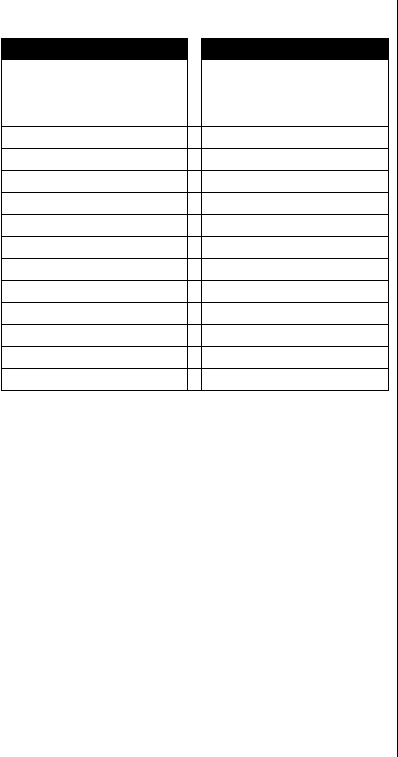
Initial Setup 187
Menu Features
Changing the Time and Date
You can change the actual time, the format in which the
time is displayed, and the date displayed on your phone.
Changing the Time
To change the time:
Initial Setup Menu
Time and Date
Time
1 Touch Dial
Auto Redial
Backlight
Status Light
Zoom Setting
Scroll
Animation
Language
Preferred Card
Battery Save
DTMF
Master Reset
Master Clear
Find the
feature
1. Press
M
and navigate to the
feature
Initial Setup
.
2. Press
+
to open the
Initial
Setup
Menu
.

188 Initial Setup
3. Press
S
to scroll to
Time and Date
.
4. Press
+
to open the
Time and
Date
display.
Change
time
5. Press
S
to scroll to the time display.
6. Press
+
to
CHANGE
the time.
The hour display is highlighted.
Change
hour
7. Press
S
to scroll to the hour you want
to select.
or
Enter the hour using the keypad
numbers.
8. Press
+
to accept the change and
move to the minute display.
Change
minutes
9. Press
S
to scroll to the minutes you
want to select.
or
Enter the minutes using the keypad
numbers.
10. Press
+
to accept the change and
move to the format display.
Change
format
11. Press
S
to select
pm
or
24 hr
.
12. Press
+
.

Initial Setup 189
Changing the Date
To change the date:
Note:
•If you change the display from
am
or
pm
to
24 hr
, the phone immediately
displays time in the 24 hour format.
•If you change from
24 hr
format to
am
or
pm
, the phone immediately displays
time in the 12 hour format.
Exit
13. Press
-
to exit.
The phone displays the changed time
message for a few seconds, then
returns to the
Time and Date
menu
line.
If you want to set the date next, remain
in the
Time and Date
menu.
Display
the date
1. While you are in the
Time and Date
menu, press
S
to highlight the date
display.
2. Press
+
.
The month is highlighted.

190 Initial Setup
Change
the
month
3. Press
S
to scroll to the month you
want to select.
or
Use the keypad numbers to enter the
month.
Press
+
to accept the change and
move to the day display.
Change
the day
4. Press
S
to scroll to the day you want
to select.
or
Use the keypad numbers to enter the
day.
Press
+
to accept the change and
move to the year display.
Change
the year
5. Press
S
to scroll to the year you want
to select.
or
Use the keypad numbers to enter the
year.
Press
+
to accept the change.
The phone displays the new date.

Initial Setup 191
Setting the Phonebook for
One-Touch Dialing
You can change the setting for one-touch dialing so that the
turbo dial keys are synchronized with the first nine speed
dial locations in your phonebook.
To set up one touch dialing:
Change
the
format
6. Highlight the date.
7. Press
+
.
8. Press
S
to scroll through the date
format menu. Select month first, day
first, or month abbreviation.
9. Press
+
.
Exit
10. Press
-
to exit.
Find the
feature
1. Press
M
and navigate to the
feature
Touch Dial
under the
Initial
Setup
menu.
2. Press
+
.
Select a
setting
3. Press
S
to scroll to
Phone
to
synchronize one-touch dialing with
your phonebook.
or
Press
S
to scroll to
SIM
to synchronize
one touch dialing with the SIM’s
phonebook.

192 Initial Setup
Adjusting Automatic Redial
Sometimes you may not be able to complete a call because
the wireless system is busy. When this happens, you hear a
fast busy signal.
With Automatic Redial, your phone automatically redials a
call that originally fails due to network conditions. To turn
Auto Redial on or off:
or
Press
S
to scroll to
Fixed Dial
to
synchronize one-touch dialing with the
SIM.
4. Press
+
.
Exit
5. Press
-
to exit.
Find the
feature
1. Press
M
and navigate to the
feature
Automatic Redial
under the
Initial Setup
menu.
2. Press
+
.
The
Auto Redial
menu is displayed.
Change
the
setting
3. Press
S
to toggle between
Auto
Redial
On
or
Off
.
4. Press
+
.
The phone briefly displays the new
setting.
Exit
5. Press
-
to exit.

Initial Setup 193
Adjusting the Display
Backlight
Most phones can sense the amount of ambient light.
•If there is enough light for you to see the display, the
backlight is turned off.
•If there is
not
enough light, the backlight automatically
turns on to illuminate the display.
You can, however, adjust the backlight display at any time.
To adjust the backlight display:
Find the
feature
1. Press
M
and navigate to the
feature
Backlight Display
under the
Initial Setup
menu.
2. Press
+
.
The
Backlight
menu is displayed.
Change
the
setting
3. Press
S
to scroll through the menu to
select
Off
or the length of time the
backlight remains on, ranging from five
seconds to continuous.
4. Press
+
.
The phone briefly displays the new
setting.
Exit
5. Press
-
to exit.

194 Initial Setup
Adjusting the Status Light
A status light is available on top of the phone to provide
status information on your current type of service and
message status. See “Status Light” for more details.
You may want to turn the Status Light off to conserve
battery power or turn it back on to display status. Follow
these steps:
Changing the Zoom Setting
Your phone can display either three or four lines of display.
In both cases, the bottom line displays the Soft Key
information. The Zoom setting allows you to switch between
the three or four line-display.
To change the zoom setting:
Find the
feature
1. Press
M
and navigate to the
feature
Status Light
under the
Initial Setup
menu.
2. Press
+
.
Change
the
setting
3. Press
S
to toggle the setting
ON
or
OFF
.
4. Press
+
.
Exit
5. Press
-
to exit.
Find the
feature
1. Press
M
and navigate to the
feature
Zoom
under the
Initial Setup
menu.
2. Press
+
.

Initial Setup 195
Changing Scrolling Behavior
You can select one of two scrolling behaviors for navigating
up and down a menu list with the
S
key:
To change the scrolling behavior:
Change
the
setting
3. Press
S
to toggle the settings
between
3-Line
and
2-Line
.
4. Press
+
.
The phone briefly displays the new
setting.
Exit
5. Press
-
to exit.
Up/Down
The cursor stops when it reaches the top or
bottom of the items displayed on the screen.
Wrap
Around
The cursor
wraps
around when it appears at
the top. It then appears at the bottom of the
display.
The cursor
wraps
around when it appears at
the bottom. It then appears at the top of the
display.
Find the
feature
1. Press
M
and navigate to the
feature
Scroll
under the
Initial
Setup
menu.
2. Press
+
.

196 Initial Setup
Turning Animation On and
Off
Animation helps give context to menu items. It provides
smooth scrolling within and between text fields and
highlights menu selections and soft key choices. When
animation is turned off, the cursor jumps from field to field,
rather than moving between them.
You can conserve battery life by turning the animation
feature off.
To change the animation setting:
Change
setting
3. Press
S
to scroll to
Up/Down
or
Wrap
Around
.
4. Press
+
.
The phone briefly displays the new
setting.
Exit
5. Press
-
to exit.
Find the
feature
1. Press
M
and navigate to the
feature
Animation
under the
Initial
Setup
menu.
2. Press
+
.
Change
the
Setting
3. Press
S
to toggle the setting between
ON
and
OFF
.
4. Press
+
.
The phone briefly displays the new
setting.

Initial Setup 197
Setting a Language
Preference
Some phones support multiple languages and include a
language setting. By default, your phone is set to the
language of the country where it is sold.
To change the language setting:
Exit
5. Press
-
to exit.
Find the
feature
1. Press
M
and navigate to the
feature
Language
under the
Initial
Setup
menu.
2. Press
+
.
The phone displays a list of all
available language settings.
Change
the
setting
3. Press
S
to scroll to the preferred
language setting.
If your phone contains a SIM chip and
you want to use the language identified
on the SIM, you can select
Automatic
.
All languages are listed with spelling
and characters that are unique to the
language. For example, Spanish is
listed as Español and Turkish is listed
as Türkçe.
4. Press
+
.
Exit
5. Press
-
to exit.

198 Initial Setup
Setting Battery Charge
Conservation Preferences
Some networks and phones include a battery save setting
to conserve battery power.
To change the battery save setting:
Adjusting the DTMF Setting
You can enter digits and send them as Dual Time Multi-
Frequency tones (DTMF) tones. Your phone transmits
DTMF tones when you press a key on the keypad. These
tones are used to access automated calling systems, such
as credit card entry, password entry, or number linking.
Refer to “Sending Tones” on page XX for more information
on using DTMF tones.
Your phone can send the DTMF transmission to the
network in long or short form.
Find the
feature
1. Press
M
and navigate to the
feature
Battery Save
under the
Initial Setup
menu.
2. Press
+
.
Change
setting
3. Press
S
to toggle between
ON
and
OFF
.
4. Press
+
.
The phone briefly displays the
changed setting.
Exit
5. Press
-
to exit.

Initial Setup 199
To change the DTMF setting:
Master Reset
Use the master reset feature to reset all user-selectable
options back to their original factory settings. All of the
original settings are restored except for the unlock code and
security code.
Note: The wireless network controls and takes priority over
some of your phone’s settings. For example, call forwarding
settings are controlled by the network. If your phone is reset
to the factory default
Call Forwarding: Off
, but if the
network setting is
On
, the network setting takes precedence
over the phone’s new setting. To use the master reset:
Find the
feature
1. Press
M
and navigate to the
feature
DTMF
under the
Initial Setup
menu.
2. Press
+
.
Change
the
setting
3. Press
S
to toggle between
Short
or
Long
.
4. Press
+
.
The phone briefly displays the new
setting.
Exit
5. Press
-
to exit.
Find the
feature
1. Press
M
and navigate to the
feature
Master Reset
under the
Initial Setup
menu.
1. Press
+
.

200 Initial Setup
Master Clear
If you want to start over, use Master Clear to reset all user-
selectable options, clear the resettable timer and recent call
lists, and erase all Phonebook information. The master
clear feature also resets the phone, except for the unlock
and security codes, to the factory defaults.
Note: The wireless network controls and takes priority over
some of your phone’s settings. For example, call forwarding
settings are controlled by the network. If your phone is reset
to the factory default
Call Forwarding: Off
, but if the
network setting is
On
, the network setting takes precedence
over the phone’s new setting.
Note: The master clear feature does
not
delete information
stored on a SIM card, such as phonebook entries, fixed dial
Security
Code
2. Enter your security code.
3. Press
+
to accept the code.
Reset
the
phone
4. The phone displays a confirmation
message:
Reset All Phone
Settings?
5. Press
-
to change all settings.
or
Press
+
to cancel the request.
The phone briefly displays a
Completed: Phone Settings
message and returns you to the
Initial Settings
menu.
Exit
6. Press
-
to exit.

Initial Setup 201
entries, messages, language preferences, network lists,
and call cost information.
To use the master clear feature:
Find the
feature
1. Press
M
and navigate to the
feature
Master Clear
under the
Initial Setup
menu.
1. Press
+
.
Security
Code
2. Enter your security code.
3. Press
+
.
Clear
the data
4. The phone displays a message:
Clear
All Phone Data?
5. Press
-
to clear the data.
or
Press
+
to cancel the request.
The phone briefly displays a
Competed: Phone Settings
message and returns you to the Initial
Settings menu.
Exit
6. Press
-
to exit.

202
In-Call Settings
You can use your phone’s timer to view the length and cost
of your calls, you can switch between a current call and an
incoming call, and you can answer a call by pressing any
key (or just opening the phone).
Use the in-call settings to customize your preferences for
these options, or to just turn them on and off.
In this chapter you will learn how to:
•set up your call timer display and alert
•turn answering options on or off
•turn call waiting on or off
Menu Features
Setting Up In-Call Timers
Your phone can keep track of the length and cost of your
calls. If you want, it can show you a running timer whenever
you are on the phone. It can also notify you when a call
reaches a specified time limit.
In-Call Setup
In Call Timer
Answer Options
Call Waiting

In-Call Settings 203
This feature lets you indicate which timer you would like to
see during your calls, if any. The following timers are
available:
Timer Description
Time
shows the time elapsed for the current call
Cost
shows the cost of the current call
This feature is only available if you
subscribe to call cost features or advice of
charge. For information about setting call
cost, refer to “Call Cost” on page xx.
Total
Cost
shows the cost of all calls since the last
time you reset the timer
This feature is only available if you
subscribe to call cost features or advice of
charge. For information about setting call
cost, refer to “Call Cost” on page xx.
Credit
Available
shows how much credit you have left
This feature is only available if you
subscribe to call cost features or advice of
charge.
Off
no in-call display for the timer

204 In-Call Settings
To set up your in-call timer
Find the
feature
1. Press
M
and navigate to:
Settings B In-Call Setup B
In-Call Timer
Note: On some systems,
In-Call
Timer
may be called
In-Call Setup
.
The phone shows the in-call timer
form.
Select
timer
display
2. Press
S
to scroll to
Display
.
3. Press
+
to see the
Display
field
list. Press
S
to scroll to the item you
want and press
+
.
or
Press
#*
to scroll through
Display
field entries without opening
the field list.

In-Call Settings 205
Turning Answer Options On
or Off
When your phone rings, you can answer it by pressing
N
.
You can also answer a call by pressing any key (the
Select
timer
alert
4. Press
S
to scroll to
Beep
.
Note: On some systems,
Beep
may be
called
Beep Timer
.
5. Press
+
to see the
Beep
field list.
6. Press
S
to scroll to the item you want.
If you select a beep interval from this
list, your phone beeps once when a
call reaches that interval.
7. Press
+
to select the option.
•If you selected a beep interval, the
phone displays the field editor.
Enter any number of seconds (1-999)
to change your beep interval. Use
-
to delete digits, and
+
to
store them and return to the in-call
timer form.
•If you selected
Off
, the phone does
not beep to indicate an interval during
your calls. You return to the In-call
timer form.
Exit
8. Press
-
to return to the in-call
setup menu.

206 In-Call Settings
Multikey
option) or by opening the flip when it is closed
(the
Open to Answer
option).
To set up your answer options:
Find the
feature
1. Press
M
and navigate to:
Settings B In-Call Setup B
Answer Options
The phone displays the answer options
form.
Toggle
multi-
key
answer
2. Press
S
to scroll to
Multi-key
.
3. Press
+
to see the
Multi-key
field list (
On
and
Off
). Press
S
to
scroll to the item you want and press
+
.
or
Press
#*
to scroll through
Multi-key
field entries without
opening the field list.
Toggle
open to
answer
4. Press
S
to scroll to
Open to answer
.
5. Press
+
to see the
Open to
Answer
field list (
On
and
Off
).
6. Press
S
to scroll to the item you want.
7. Press
+
.
Exit
8. Press
-
to return to the in-call
setup menu.

In-Call Settings 207
Turning Call Waiting On or
Off
Your phone can notify you when another call arrives while
you are already on a call. You can turn this feature on or off.
Note: Call waiting is an optional network and subscription-
dependent feature that is not available in all areas. Contact
your service provider for availability.
To switch call waiting on or off:
Find the
feature
1. Press
M
and navigate to:
Settings B In-Call Setup
The phone displays the in-call setup
menu.
Switch
multi-
key
answer
on or off
2. Press
S
to scroll to
Call Waiting
.
3. Press
+
to see the
Call Waiting
field list (
On
and
Off
). Press
S
to
scroll to the item you want and press
+
.
or
Press
#*
to scroll through
Call
Waiting
field entries without opening
the field list.
Exit
4. Press
-
to return to the Settings
menu.

208
Using Lock/Security Features
While you probably should not leave your phone
unattended, your phone has a number of built-in security
features to prevent unauthorized use.
In this chapter you will learn how to:
•lock and unlock your phone
•lock and unlock your phone’s keypad
•restrict access to phone applications
•restrict incoming and outgoing calls
•change your lock code and security code

Using Lock/Security Features 209
Menu Features
Locking and Unlocking Your
Phone
Locking Your Phone
You can manually lock your phone or set it to lock
automatically.
Settings
Security
Phone Lock
Lock Now
Auto Lock
Unlock Code
Lock Keypad
Lock Application
Recent Calls
Fixed Dial
Phonebook
Datebook
Radio
Messages
Shortcuts
SIM Apps
Browser
Restrict Calls
Outgoing Calls
Allow
Incoming Calls
Allow
Settings
Security (continued)
Passwords
Unlock Code
Security Code

210 Using Lock/Security Features
Notes:
•The phone prompts you to enter your unlock code
before locking. This prevents you from locking the
phone without knowing the unlock code.
•Once you unlock your phone, it remains unlocked
until you lock it again.
•You do not have to enter the unlock code when you
turn off the automatic lock feature.
Locking Your Phone Manually
You can lock your phone manually at any time to prevent
unwanted use. Once you lock the phone, it remains locked
whether it is powered on or off.
Find the
feature
1. Press
M
and navigate to the
feature:
Settings
B
Security
B
Phone Lock
B
Lock Now
Verify
code
2. Enter your four-digit unlock code and
then press
+
.
Exit
3. Press
-
to return to the previous
dialog.
or
Press
O
return to the main dialog.

Using Lock/Security Features 211
Locking Your Phone Automatically
When you turn this feature on, your phone automatically
locks itself each time you turn it off.
Unlocking Your Phone
Tip:
If you
forget your lock
code, try
entering 1234
or the last four
digits of your
wireless phone
number.
The factory-programmed lock code for unlocking the phone
is 1234. If you have changed this code and cannot
remember it, see “If You Forget Your Unlock Code” on
page 214.
To unlock your phone:
Find the
feature
1. Press
M
and navigate to the
feature:
Settings
B
Security
B
Phone Lock
B
Automatic Lock
Select
setting
2. Press
S
to scroll to
On
or
Off
, and
then press
+
to select.
Verify
code
3. If you selected
On
, enter your four-digit
unlock code and then press
+
to
lock the phone.
Exit
4. Press
-
to return to the previous
dialog.
or
Press
O
return to the main dialog.
Enter
unlock
code
Enter your four-digit unlock code and
then press
+
.

212 Using Lock/Security Features
Changing the Unlock Code
The unlock code is originally set to 1234. You should
change it as soon as possible.
Find the
feature
1. Press
M
and navigate to the
feature:
Settings
B
Security
B
Phone Lock
B
Unlock Code
Enter
old code
2. Enter your old four-digit unlock code
and then press
+
.
or
If you don’t know your unlock code,
press
M
to go to the security code
editor. (See “If You Forget Your Unlock
Code” on page 214.)
Enter
new
code
3. Enter a new four-digit unlock code and
then press
+
.
4. Enter the new four-digit unlock code
again to confirm, and then press
+
.
Exit
5. Press
-
to return to the previous
dialog.
or
Press
O
return to the main dialog.

Using Lock/Security Features 213
Answering Calls and Reading
Messages When the Phone Is Locked
You can still receive calls and messages when the phone is
locked.
Your phone rings or vibrate to indicate an incoming call or
message, but you do not see any visual indication in the
display. When you receive an incoming message, the
P
(message) icon is displayed in the status area.
You must unlock the phone in order to answer a call or read
an incoming message. See“Unlocking Your Phone” on
page 211.
Placing Emergency Calls When the
Phone is Locked
When the phone is locked, you cannot place any outgoing
calls, except for emergency calls. To place an emergency
call:
Note: See “Storing an Emergency Number” on page XX for
instructions on how to store your emergency phone
number.
Enter
emergency
number
1. When the phone prompts you to
Enter Unlock Code ____
, enter
the digits of your emergency phone
number (for example, 911).
Place call
2. Press
N
to place the call.

214 Using Lock/Security Features
If You Forget Your Unlock Code
If you forget or don’t know your unlock code, use the
following procedure to bypass the unlock code editor.
Locking and Unlocking the
Keypad
You can lock your phone’s keypad to prevent accidental
usage of the phone. All keys are disabled except for the
volume keys and the
M
and
*
keys.
Locking and Unlocking the Keypad
Shortcut:
You can also
press
M
*
to lock or
unlock the
keypad.
To access the keypad lock feature from the Security menu:
Bypass
unlock
code
1. When the phone prompts you to
Enter Unlock Code ____
, press
M
to go to the security code
editor.
Enter
security
code
2. Enter your six-digit security code and
then press
+
to unlock the phone.
Find the
feature
1. Press
M
and navigate to the
feature:
Settings
B
Security
B
Lock Keypad
Lock
keypad
2. The phone describes which keys
you use to lock/unlock the keypad.
Press
M
then
*
to lock the
keypad.

Using Lock/Security Features 215
Answering Calls and Reading
Messages When the Keypad is Locked
Your phone notifies you of an incoming call or message in
the usual way, and temporarily unlocks the keypad so you
can acknowledge the notification message.
If you choose to answer the call or read the message, the
keypad lock is disabled, and the phone functions normally
until you finish the call or message and return to the idle
display.
If you choose to ignore the call or message, the phone
returns to the idle display and the keypad is relocked.
Placing Emergency Calls When the
Keypad is Locked
When the keypad is locked, you cannot place any outgoing
calls except for emergency calls. To place an emergency
call:
Note: See “Storing an Emergency Number” on page XX for
instructions on how to store your emergency phone
number.
Enter
emergency
number
1. When the phone display shows
Keypad Locked
, enter the digits of
your emergency phone number (for
example, 911).
Place call
2. Press
N
to place the call.

216 Using Lock/Security Features
Restricting Access to
Applications
You can lock specific phone applications to prevent others
from using these applications when they borrow your
phone.
The following applications may be locked from the Security
menu:
You can also set the Phonebook application to View Only
mode, so that phonebook information may be read but not
written, edited, or copied. See “Phonebook XXX” on
page XX for information about the functionality that is
unavailable in view only mode.
Locking and Unlocking Applications
To lock or unlock an application:
Recent Calls Datebook Shortcuts
Fixed Dial Radio SIM Apps
Phonebook Messages Browser
Find the
feature
1. Press
M
and navigate to the
feature:
Settings
B
Security
B
Lock Application
Select
application
2. Press
S
to scroll to the desired
application, and then press
+
.

Using Lock/Security Features 217
Using Locked Applications
When an application is locked, you must enter the unlock
code to access the application.
Select
setting
3. Press
S
to scroll to
Locked
or
Unlocked
, and then press
+
to
select.
or
If you selected the Phonebook
application, press
S
to scroll to
Locked
,
Unlocked
, or
View Only
,
and then press
+
to select.
Note: A check mark identifies the
current selection.
Exit
4. Press
-
to return to the
previous dialog.
or
Press
O
to return to the main
dialog.
Select
application
1. Select the locked application you
want to use.
The phone prompts you to
Enter Unlock Code ____
.
Enter code
2. Enter your four-digit unlock code.
3. Press
+
to access the
application.

218 Using Lock/Security Features
Restricting Calls
You can restrict both outgoing and incoming calls. This
feature is useful if you are loaning your phone to others or
when you wish to control incoming calls.
Restricting Outgoing Calls
This feature enables you to receive incoming calls but
prevents outgoing calls. You can restrict all outgoing calls,
or allow calls only to the numbers stored in your
phonebook.
Note: You can still place calls to the emergency phone
number when outgoing calls are restricted.
Find the
feature
1. Press
M
and navigate to the
feature:
Settings
B
Security
B
Restrict Calls
B
Outgoing Calls
Select
setting
2. Press
S
to scroll to
All
,
None
, or
Phonebook
, and then press
+
to
select.
Note: A check mark identifies the
current selection.
Exit
3. Press
-
to return to the previous
dialog.
or
Press
O
return to the main dialog.

Using Lock/Security Features 219
Restricting Incoming Calls
This feature allows you to place calls but refuses incoming
calls. You can restrict all incoming calls or allow incoming
calls only from phone numbers that match an entry in your
phonebook.
Changing Passwords
The
New Passwords
menu groups together the codes and
passwords required to unlock or change phone settings.
This feature is only available on phones with multiple
user-settable passwords. If the unlock code is the only
password you can change, then the Unlock Code option is
available on the Phone Lock menu, and the New
Passwords menu is not available.
Find the
feature
1. Press
M
and navigate to the
feature:
Settings
B
Security
B
Restrict Calls
B
Incoming Calls
Select
setting
2. Press
S
to scroll to
All
or
None
, or
Phonebook
, and then press
+
to
select.
Note: A check mark identifies the
current selection.
Exit
3. Press
-
to return to the previous
dialog.
or
Press
O
return to the main dialog.

220 Using Lock/Security Features
Changing the Unlock Code
The unlock code is originally set to 1234. You should
change it as soon as possible.
Changing the Security Code
The security code is your phone’s primary security number.
It is originally set to 000000.
Find the
feature
1. Press
M
and navigate to the
feature:
Settings
B
Security
B
New Passwords
B
Unlock Code
Enter
old code
2. Enter your old four-digit unlock code
and then press
+
.
or
If you don’t know your unlock code,
press
M
to go to the security code
editor. (See “If You Forget Your Unlock
Code” on page 214.)
Enter
new
code
3. Enter a new four-digit unlock code and
then press
+
.
4. Enter the new four-digit unlock code
again to confirm, and then press
+
.
Exit
5. Press
-
to return to the previous
dialog.
or
Press
O
return to the main dialog.

Using Lock/Security Features 221
To change your security code:
Note: Your phone’s security code may be retained by your
service provider for customer service purposes. In this case
the Security Code option will not appear on the New
Passwords menu.
Find the
feature
1. Press
M
and navigate to the
feature:
Settings
B
Security
B
New Passwords
B
Security Code
Enter
old code
2. Enter your old six-digit security code
and then press
+
.
Enter
new
code
3. Enter a new six-digit security code and
then press
+
.
4. Enter the new six-digit security code
again to confirm, and then press
+
.
Exit
5. Press
-
to return to the previous
dialog.
or
Press
O
return to the main dialog.

222 Ring and Vibrate Features
Ring and Vibrate Features
You can customize your phone’s ring and vibration alerts for
incoming calls or other events, such as incoming text
messages, voicemail messages, information service
notifications, answering machine messages, alarms, data
calls, and fax calls. You can also customize your keypad
sounds.
In this chapter you will learn how to:
•choose a type of ring/vibration
•change the ring volume
•specify different rings for different events
•change the ring for your reminders
•change the volume for your keypad sounds
Note: To adjust the voice volume on your phone, see
“Controlling Volume” on page XX.

Ring and Vibrate Features 223
Menu Features
Selecting a Ring/Vibration
Type
Your phone can vibrate and ring for incoming calls or other
events. Use this feature to select a ring type, a vibration
type, or both ring and vibration for
all
events.
Note: You can also customize your ring or vibration for a
specific event. Refer to “Selecting a Ring/Vibration for a
Specific Event” on page 225.
Ring/Vibrate
Alert
Detail
Ring Volume
Calls
Line 1
Line 2
Text Msgs
VoiceMail
Info Svcs
Ans Machine
Alarms
Data Calls
Fax Calls
Key Volume
Reminders

224 Ring and Vibrate Features
Shortcut:
After you
highlight
Alert
, you
can use
*#
to
show each
option next to
the
Alert:
prompt without
opening the
Alert menu.
To select a ring/vibration type:
Changing the Ring Volume
This feature allows you to adjust the volume level of your
phone’s ring for
all
events.
Note: You cannot select a different volume setting for
different events.
Shortcut:
After you
highlight
Ring
Volume
, you
can enter a
new value (0-
6) on the
number
keypad.
To change the ring volume:
Find the
feature
1. Press
M
and navigate to the
feature
Ring/Vibrate
.
Select
ring or
vibrate
type
2. Scroll
S
through the various ring and
vibration types.
3. Press
+
to select a type. The
phone displays:
Changed: Alert
alert type
where
alert type
is the ring or vibration
type that you selected
.
Exit
4. Press
O
to exit.
Find
the
feature
1. Press
M
and navigate to the feature
Ring Volume
.
The volume meter appears.

Ring and Vibrate Features 225
Selecting a Ring/Vibration
for a Specific Event
In “Selecting a Ring/Vibration Type” on page 223 you
learned how to select a ring or vibration type that applies to
all
events. You can also select a
different
ring/vibration type
for a specific phone event. The type specified for the
particular event overrides the type for all events.
Note: You can select vibrate (rather than ring) for an event,
even if you chose ring for your ring/vibration type.
Shortcut:
After you
highlight the
event, you can
use
*#
to show each
option next to
the event
prompt.
To change the ring for a specific event:
Adjust
volume
2. Scroll
S
or type 0-6 on the number
keypad to adjust the volume. The phone
displays:
Changed: Ring Volume
setting
where
setting
is the selected volume.
Exit
3. Press
O
to exit.
Find the
feature
1. Press
M
and navigate to the
feature
Ring/Vibrate
--->
alert type
Detail
.
Select
an event
2. Scroll
S
to scroll through the various
events.
3. Press
+
to select an event. The
event’s menu is displayed.

226 Ring and Vibrate Features
Selecting a Reminder
Reminders periodically notify you of missed events, such as
calls or messages. This feature lets you switch these
reminders to beep, vibrate, or off.
Shortcut:
After you
highlight
Reminder
, you
can enter a
new value on
the number
keypad.
To select a reminder:
Changing Keypad Volume
Your keys make a sound when you press them. This feature
allows you to adjust the volume level for this sound.
Change
ring or
vibrate
type
4. Scroll
S
to scroll to the ring sound you
want to change.
5. Press
+
to select a ring. The
phone displays:
Changed:
event
ring_sound
Exit
6. Press
O
to exit.
Find the
feature
1. Press
M
to navigate to the feature
alert type
Detail
--->
Reminder
.
2. Press
+
. The reminder menu
appears.
3. Scroll
S
to the reminder option you
want and press
+
.
4. You will see
Changed: Reminders
(option)
Exit
5. Press
O
to exit.

Ring and Vibrate Features 227
Shortcut:
After you
highlight
Key
Volume
, you
can enter a
new value
(0-6) on the
number
keypad.
To change the keypad volume:
Find the
feature
1. Press
M
to navigate to the feature
alert type
Detail
--->
Key Volume
.
Select
number
2. Press
+
. The volume meter
appears.
3. Adjust the volume (
S
or type 0-6 on
the number keypad) and press
+
.
4. You will see
Changed: Key Volume
(setting)
Exit
5. Press
O
to exit.

228
Phonebook
You can store a list of names and numbers in your
phonebook. Afterwards, you can look up a number and dial
it directly from your phone. Your phonebook can hold 99
entries, and a SIM card can hold additional entries.
In this chapter you will learn how to:
•store phonebook entries
•call phonebook entries
•edit/delete phonebook entries
•copy phonebook entries to a SIM card
•check your phonebook capacity
•change your phonebook setup

Phonebook 229
Menu Features
Making the Most of Memory
You can create a phonebook with names and numbers
stored in memory locations. Numbered 01-99, each
memory location lets you store a name and up to four
phone numbers. In one location you can store the home,
mobile, work, and fax numbers of a single contact. To help
you find the right number, you can assign an icon to each
number.
When you view memory locations with stored information,
the phone displays the name, location, and one icon for
each number stored.
To organize your phonebook for convenient recall, try
storing related numbers in groups of ten. For example,
Phonebook
New
Edit
Delete
Send Message
Add Digits
Attach Number
Copy Entry
Copy Entries
Phone Capacity
SIM Capacity
Send Tones
Talk then Fax
Talk then Data
Setup

230 Phonebook
store your nine most frequently called numbers in locations
01-09, and then use the Turbo Dial keys to call them with
the push of a key. (See “Dialing with Turbo Dial®” on
page 6.) You could store business contacts in locations 10-
19, family in 20-29, friends in 30-39, and so on.
You can also store names to identify phone numbers. Later,
you can recall a number by the name that corresponds to it.
Fields in Phonebook Entry
Forms
Each phonebook entry contains a form that holds its details,
such as name and type of number. The phonebook entry
form contains the following fields:
Name
the name of the person or group for the
phone number
No.
the phone number for the entry
Type
the type of number stored in the entry’s
No.
field (work, home, main, mobile, fax, or
pager)
Voice
Name
a recording of you saying the entry’s name
If you record a voice name for an entry, you
can call the entry just by saying the name
from your phone’s idle state.

Phonebook 231
Note: Numbers stored in the SIM card do not have a Type
or Voice Name field.
Storing Phonebook Entries
To create a new phonebook entry, you start by opening a
new phonebook entry form. You can open a new
phonebook entry form in several ways:
•Press
+
whenever the phone displays
Store
above the key.
•Select
Store
whenever it is available in a menu.
•Select
New Entry
from the phonebook list.
•Select
New
from the phonebook menu.
•Use a shortcut for
Store
, if you have one.Refer to
“Creating Shortcuts” on page XX.
The following procedure shows how to open a new form by
selecting
New
from the phonebook menu. If you already
Speed
No.
the number that you can enter from idle if you
want to “speed dial” this entry
In choosing a speed dial number, refer to
“Making the Most of Memory” on page 47.
The speed number also determines if the
entry is stored in the phone’s memory
(numbers 01-99) or in the SIM card’s memory
(numbers 100 plus).

232 Phonebook
have a form open, skip the Open a new form steps. To
create and store a new phonebook entry:
Find the
feature
1. Press
M
.
2. Press
S
to scroll to
Phonebook
.
3. Press
+
.
The phone displays the phonebook
list.
4. Press
M
.
5. Press
S
to scroll to
New
.
6. Press
+
.
The phone displays a blank
phonebook entry form.
Enter
name
7. Press
S
to scroll to
Name
.
8. Press
+
to open the
Name
field
editor.
or
Enter the name you want. The
Name
editor opens automatically.

Phonebook 233
9. Press
+
to browse through a list
of the names that are already in your
phonebook, if you want to choose a
name that is used for another entry.
Browse
is only available before you
enter any characters in this field.
or
Use your number keys to enter a
name for the phonebook entry (refer to
“Using the Keypad to Enter Text” on
page 2).
or
Press
-
to cancel.
10. After you enter text, you can:
•Press
-
to delete characters.
•Press
-
(with all characters
deleted) to cancel.
•Press
+
to store the text and
return to the entry form.
Enter
number
11. Press
S
to scroll to
No.
12. Press
+
to open the
No.
field
editor.
or
Enter the number you want. The
No.
editor opens automatically.

234 Phonebook
13. Press
+
to browse through the
numbers in your phonebook or recent
calls. The phone displays a browse
menu, containing
Received Calls
,
Dialed Calls
, and
Phonebook
.
Press
S
to scroll to the list you want
and press
+
to see the list. Then
Press
S
to scroll to the number you
want and press
+
to select it.
Browse is only available before you
enter any characters in this field.
or
Enter the number from your number
keys.
or
Press
-
to cancel.
14. After you have entered digits, you can:
•Press
-
to delete digits
•Press
-
(with all digits deleted)
to cancel
15. Press
+
to store the number and
return to the entry form.

Phonebook 235
Enter
type
16. Press
S
to scroll to
Type
.
Note: Entries do not have Type fields if
they are stored on a SIM card.
17. Press
+
to display the
Type
field
list. Press
S
to scroll to the item you
want and press
+
.
or
Press
#*
to scroll through
Type
field entries without opening the field
list.
Enter
Voice
Name
18. Press
S
to scroll to
Voice Name
.
Note: Entries do not have Voice Name
fields if they are stored on a SIM card.
19. Press
+
to record the voice name.
The phone displays
Press Voice Key
then say name
.
20. Press the voice key on the right side of
the phone and say the entry’s name
(within two seconds).
The phone displays
Press Voice Key
then REPEAT name
.
21. Press the voice key again and repeat
the name for confirmation. The phone
displays
Trained: Voice Name
and
returns you to the phonebook entry
form. An icon in the voice name field
indicates that the phone stored a voice
name.

236 Phonebook
Enter
speed
number
22. Press
S
to scroll to
SpeedNo.
The phone automatically fills in the
first available number when you open
a new form.
23. If you want to change the speed
number:
a. Press
+
to display the
SpeedNo.
editor and enter the
number you want.
or
Enter the number you want. The
SpeedNo.
editor opens
automatically.
b. Press
-
to delete numbers if
you want to (press
-
with all
numbers deleted to cancel).
c. Press
+
to save the new speed
number and return to the
phonebook entry form.
An indicator tells you if the entry is
in the phone’s memory (numbers
01-99) or the SIM card’s memory.
The entry is only saved in the SIM
card’s memory if you assign a
speed dial number from the SIM
card.
If your chosen speed number is
already assigned to another entry,
your phone will ask you if you want
to replace that entry.

Phonebook 237
Calling Phonebook Entries
You can call the numbers stored in your phonebook from:
•SpeedDial (refer to “Dialing with Speed Dial” on
page 49)
•TurboDial (refer to “Dialing with Turbo Dial®” on
page 50)
•the phonebook list view
•the phonebook details view
•VoiceDial
Enter
more
numbers
24. If you want to store another number for
the same
Name
(for example, a fax
number or other type of number) then
press
S
to scroll to
More
and press
+
.
The phone displays another set of
number fields and creates another
phonebook entry for this new number,
copying the
Name
from the original
entry.
Exit
25. Press
-
to return to the
phonebook list.
or
Press
O
to return to the main dialog.

238 Phonebook
Calling Entries from the List or Details
View
If you do not know an entry’s SpeedDial number, you can
search your phonebook for the entry and dial it from there.
To call from the list or details view:
Calling Entries Using Voice Dial
You can use your phone’s voice recognition capabilities to
call an entry just by speaking the name into the phone.
Note: You must store a voice name for a phonebook entry
before you can call it with Voice Dial. Refer to “Storing
Phonebook Entries” on page 135.
Find the
feature
1. Press
M
.
2. Press
S
to scroll to
Phonebook
.
3. Press
+
.
The phone displays the phonebook list.
Call an
entry
4. Press
S
to scroll to the entry you want
to call and press
N
.
or
Press
S
to scroll to an entry and press
+
to see its details. If you choose
to call it, press
N
from the details view.

Phonebook 239
To call an entry with Voice Dial:
Editing/Deleting Phonebook
Entries
Each phonebook entry has a form that holds its details,
such as name and other numbers. To edit an entry’s details,
open the entry’s form and edit the fields within it. Refer to
“Fields in Phonebook Entry Forms” on page 134 for a
description of the form’s fields.
Press
key and
say
name
1. Press the voice key on the right side of
the phone.
2. Say the entry’s voice name (within two
seconds).
The phone displays the entry that
matches the name you said, and plays
back the voice name. Check to make
sure the phone chose the correct entry.
Phone
dials
entry
3. The phone dials the entry after
displaying it for two seconds.
Press any key other than the voice key
or
N
to cancel the call.

240 Phonebook
To edit a phonebook entry:
Find the
feature
1. Press
M
.
2. Press
S
to scroll to
Phonebook
.
3. Press
+
.
The phone displays the phonebook list.
4. Press
S
to scroll to the entry you want
to edit.
5. Press
+
.
The phone displays the entry’s details.
6. Press
+
.
The phone displays the entry’s form.
Edit
name
7. Press
S
to scroll to
Name
.
8. Press
+
to display the
Name
field
editor.
or
Enter the name you want. The
Name
editor overwrites the old entry and
opens automatically.
9. Press
-
to delete characters, if
you want to. Press
-
(with all
characters deleted) to cancel.
10. Use your number keys to enter
characters (refer to “Using the Keypad
to Enter Text” on page xx).
11. Press
+
to store the text and
return to the entry form.

Phonebook 241
Edit
number
12. Press
S
to scroll to
No.
.
13. Press
+
to display the
No.
field
editor.
or
Enter the number you want. The
No.
editor overwrites the old entry and
opens automatically.
14. Press
-
to delete digits, if you
want to. Press
-
(with all digits
deleted) to cancel.
15. Enter the new digits that you want.
16. Press
+
to store the number and
return to the entry form.
Edit
type
17. Press
S
to scroll to
Type
.
Note: Entries do not have Type fields if
they are stored on a SIM card.
18. Press
+
to display the
Type
field
list. Press
S
to scroll to the item you
want and press
+
to select it and
return to the entry form.
or
Press
#*
to scroll through
Type
field entries without opening the field
list.

242 Phonebook
Edit
Voice
Name
19. Press
S
to scroll to
Voice Name
.
If a voice name exists for an entry, the
phone displays an icon
T
in the voice
name field and next to the name field.
Note: Entries do not have Voice Name
fields if they are stored on a SIM card.
20. Press
+
. The phone displays
Press Voice Key then say name
.
21. Press the voice key on the right side of
the phone and say the entry’s name
(within two seconds).
The phone displays
Press Voice Key
then REPEAT name
.
22. Press the voice key again and repeat
the name for confirmation. The phone
displays
Trained: Voice Name
and
returns you to the phonebook entry
form.

Phonebook 243
Edit
speed
number
23. Press
S
to scroll to
SpeedNo.
.
24. Press
+
to display the
SpeedNo.
editor and enter the number you want.
or
Enter the number you want. The
SpeedNo.
editor overwrites the old
entry and opens automatically.
25. Press
-
to delete digits, if you
want to. Press
-
(with all digits
deleted) to cancel.
26. Press
+
to save the new speed
number and return to the phonebook
entry form.
An indicator tells you if the entry is in
the phone’s memory (numbers 01-99)
or the SIM card’s memory. The entry is
only saved in the SIM card’s memory if
you assign a speed dial number from
the SIM card (100+).
If your chosen speed number is
already assigned to another entry, your
phone will ask you if you want to
replace that entry.

244 Phonebook
Adding or Attaching
Numbers Before Calling
You can add digits to the end of a phonebook entry’s
number (or attach multiple phonebook numbers together)
before you dial. To do so, refer to “Adding or Attaching
Numbers” on page 67.
Copying Phonebook Entries
to a SIM Card
You can copy one or several entries from your phonebook
list to a SIM card. This lets you free up speed dial numbers,
or archive entries that you do not use very often.
Enter
more
phone
#s if
desired
27. If you want to store another number for
the same
Name
(for example, a fax
number or other type of number) then
Press
S
to scroll to
More
and press
+
.
The phone displays another set of
number fields (
No.
,
Type
,
Voice
Name
,
Speed No.
). The phone
creates another phonebook entry for
this new number, copying the
Name
from the original entry.
Exit
28. Press
-
to return to the
phonebook list.
or
Press
O
to return to the main dialog.

Phonebook 245
Note: The SIM card cannot store
Type
and
Voice Name
data for entries. If you try to copy an entry with a type or
voice name to the SIM card, the phone asks you for
confirmation before dropping those fields and copying the
entry.
Copy Single Entries
To copy a single phonebook entry from your phone to your
SIM card:
Find the
feature
1. Press
M
.
2. Press
S
to scroll to
Phonebook
.
3. Press
+
.
The phone displays the phonebook list.
Select
entry
4. Press
S
to scroll to the entry you want
to copy.
or
Press
S
to scroll to an entry and press
+
to see its details. If you choose
to copy it, proceed to the next step.

246 Phonebook
Enter
new
location
5. Press
M
.
6. Press
S
to scroll to
Copy Entry
.
7. Press
+
.
The phone displays the
Copy To
dialog, with the next available speed
dial number loaded by default.
8. Enter a speed dial number for a
location in your SIM Card memory, if
necessary.
Copy
entry
9. Press
+
to approve the copy.
The phone displays the
Stored
message and returns to your
phonebook list. You can now delete the
old entry if you want to.
If you specify a location that is already
taken, the phone asks you if you want
to overwrite the old entry.
Exit
10. Press
-
to return to the main
menu.
or
Press
O
to return to the main dialog.

Phonebook 247
Copy Multiple Entries
To copy multiple phonebook entries from your phone to
your SIM card:
Find the
feature
1. Press
M
.
2. Press
S
to scroll to
Phonebook
.
3. Press
+
.
The phone displays the phonebook list.
Select
entries
to copy
4. Press
M
.
5. Press
S
to scroll to
Copy Entries
.
6. Press
+
.
The phone displays the
Copy Entries
dialog.
Enter
current
location
7. Enter the
From (start)
speed dial
number. This is first (lowest) speed dial
number of the entries you want to copy.
You can type the number while the field
is selected, or press
+
to open the
field editor and type the number.
8. Press
+
to close the field editor
and return to the
Copy Entries
dialog.
9. Press
S
to scroll to
From (end)

248 Phonebook
10. Enter the
From (end)
speed dial
number. This is last (highest) speed
dial number of the entries you want to
copy. If this is empty, the phone copies
all entries from the From (start) field to
the end of the phonebook (entries in
both phone and SIM card memory).
You can type the number while the field
is selected, or press
+
to open the
field editor and type the number.
11. Press
+
to close the field editor
and return to the
Copy Entries
dialog.
Enter
new
location
12. Press
S
to scroll to
To
.
13. Enter the
To
speed dial number. This is
the first (lowest) speed dial number for
the entries’ new location.
You can type the number while the field
is selected, or press
+
to open the
field editor and type the number.
14. Press
+
to close the field editor
and return to the
Copy Entries
dialog.

Phonebook 249
Checking Phonebook
Capacity
You can check your phonebook’s capacity to see how many
entries are used and how many more are available. Since
you can store phonebook entries on both your phone and
your SIM card, you can check either your phone’s capacity
or your SIM card’s capacity.
Copy
entries
15. Press
-
to copy the entries.
The phone displays the
Copied
Entries
message and returns to your
phonebook list. You can now delete the
old entries if you want to.
If you specify a location that will
overwrite existing entries, the phone
asks you if you want to overwrite the
old entries when you try to approve the
copy.If you specify locations that do not
have memory available, the phone
displays an
Invalid Range
message.
Exit
16. Press
-
to return to the main
menu.
or
Press
O
to return to the main dialog.

250 Phonebook
To check your phonebook capacity for your phone or SIM
card:
Synchronization with PIM
Software
You can synchronize your phone with PIM (Personal
Information Management) software, which allows you to
edit your phonebook without your phone.
Using PIM software, you can change your phonebook list
both on your phone and on a separate computer. Then you
Find the
feature
1. Press
M
.
2. Press
S
to scroll to
Phonebook
.
3. Press
+
.
The phone displays the phonebook list.
Check
capacity
4. Press
M
.
5. Press
S
to scroll to
Phone Capacity
or
SIM Capacity
, depending on which
you want to check.
6. Press
+
.
The phone displays the
Capacity
display, listing the number of entries in
use and the number that are empty.
Exit
7. Press
-
to return to the
phonebook list.
or
Press
O
to return to the main dialog.

Phonebook 251
can connect the two and update them both with the most
current entries.
The Motorola Accessories (refer to page XX) group defines
the correct PIM software for your phone.
Phonebook Setup
You can specify the sort order for your phonebook entries
and the locations for your TurboDial® entries.
Phonebook List Sort Preference
You can tell your phone to sort your phonebook list by
speed dial number (the default), name, or voice dial.
Note: The voice dial sort is identical to the name sort,
except that the entries with voice tags are displayed before
those without voice tags.
To change your phonebook list’s sort order:
Find the
feature
1. Press
M
and navigate to
Phonebook
.
The phone displays the phonebook list.

252 Phonebook
TurboDial Preference
Your phone lets you specify whether your TurboDial entries
are located in your phone memory or your SIM card.
To specify your TurboDial entry locations:
Select
sort
order
2. Press
M
.
3. Press
S
to scroll to
Setup
.
4. The phone displays the
Phonebook
Setup
form.
5. Press
S
to scroll to
Sort by
.
6. Press
+
to open the
Sort by
list.
Press
S
to scroll to the entry you
want, and press
+
to select it and
return to the
Setup
form.
or
Press
#*
to scroll through the
sort list options while the
Sort by
field
is selected.
Exit
7. Press
-
to return to the
phonebook list.
or
Press
O
to return to the main dialog.
Find the
feature
1. Press
M
.
2. Press
S
to scroll to
Phonebook
.
3. Press
+
.
The phone displays the phonebook list.
253 Phonebook
Select
Turbo-
Dial
location
4. Press
M
.
5. Press
S
to scroll to
Setup
.
6. The phone displays the
Phonebook
Setup
form.
7. Press
S
to scroll to
Turbo Dial
.
8. Press
+
to open the
Turbo Dial
list. Press
S
to scroll to the entry you
want, and press
+
to select it and
return to the
Setup
form.
or
Press
#*
to scroll through the
sort list options while the
Turbo Dial
field is selected.
Exit
9. Press
-
to return to the
phonebook menu.
or
Press
O
to return to the main dialog.

254 Phonebook
Troubleshooting
You may encounter some errors while working with your
phonebook. This section describes some common
problems and their resolutions.
Problem Resolution
Phonebook Full
If you try to store a new entry when
the entire phonebook memory is full,
the phone displays a
Phonebook
Full
error before the phonebook
entry form.
You cannot save any more
phonebook entries unless you
delete some existing entries. If your
phone uses a SIM card, it will
automatically switch to the SIM
card’s memory when the phone’s
memory is full.
Voice Dial Full
Your phone has a section of its
memory where it stores voice dial
names. If it runs out of space in this
section, it shows you an error (
Voice
Dial memory is full
) when you
try to store another voice name.
You must delete some of the existing
voice dial names.
Unacceptable Voice Sample
When you record a voice name for a
phonebook entry, the phone
prompts you if it does not capture an
adequate voice sample
After the phone displays this error, it
gives you a second chance to record
the name. If it still cannot capture a
sample on the second try, it cancels
the recording and returns to the
phonebook entry form. From the
form, you can try to record the name
again.

255 Phonebook
Similar Name
When you record a voice name for a
phonebook entry, the phone
prompts you if the name is too
similar to another voice name
already stored in the phone.
The phone returns you to the
phonebook entry form. From these,
you can try to record the name
again.
Voice Name Not Found
When you try to dial an entry using
the voice name, the phone tells you
if it cannot find any entries that
match what you said (or if the phone
did not understand what you said).
Repeat the voice name to try to call
it again.
Problem Resolution
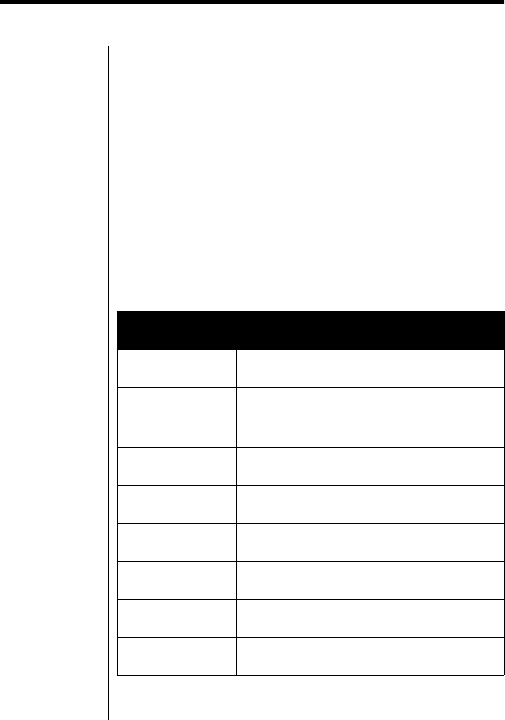
256
Shortcuts
You can create shortcuts to mark frequently used menu
items. If, for example, you change your ringer style often,
you can set up a shortcut to navigate to the alert setting and
bypass the steps to go to the alert menu.
Shortcuts are entirely personal! There are no default
shortcuts.
Menu Features
Use the shortcut menu to navigate to any of the shortcut
features.
Shortcuts
New Help file for setting up shortcuts
Edit Opens Shortcut forms for editing data
on phones with voice recognition
-Shortcut Shortcut form title
-Key Shortcut key editor
-Voice Voice shortcut field
-Record Records a voice shortcut
--Delete Deletes a recorded voice shortcut
Reorder Changes the order of shortcuts

Shortcuts 257
Help for Setting Shortcuts
To obtain help on shortcuts:
•Select
New Entry
from the Shortcut list.
•Select
New
from the Shortcut menu.
Selecting New Entry from the
Shortcut List
To get help by selecting the
New Entry
menu item:
Delete Erases the highlighted shortcut
Delete All Erases all assigned shortcuts
Find the
feature
to get
help
1. Press
M
and navigate to the
Shortcuts
feature.
2. Press
S
to
New Entry
.
3. Press
+
to select
New Entry
.
The phone displays help information
for setting up a new shortcut.
Press
+
to display more
information.
Press
-
to return to the
Shortcuts
menu.

258 Shortcuts
Selecting New from the Shortcut
Menu
To get help by selecting
New
from the Shortcut menu:
Setting Navigation
Shortcuts
You can set up a shortcut from any highlighted item on the
phone except for items:
•in a context-sensitive menu
•that are grouped together in a form
•in a SIM Toolkit or SmartCard application
Find the
feature
1. Press
M
and navigate to the
Shortcuts
feature.
2. Press
M
to display the context-
sensitive Shortcuts menu.
3. Press
S
to navigate to
New
.
Display
help
4. Press
+
to display the help
information.
The phone displays help information
for setting up a new shortcut.
Press
+
to display more
information.
Press
-
to return to the
Shortcuts
menu.

Shortcuts 259
If your phone has voice recognition and you want to set up
a voice shortcut, refer to “Setting Voice Shortcuts” on
page 262.
Setting Up a Shortcut
To set up a shortcut:
Find the
feature
1. Press
M
and navigate to the item
to which you want to assign a shortcut.
2. Press
S
to highlight the item.
Set
shortcut
3. Press and hold
M
.
The phone displays :
Assign Shortcut ÒItemÓ to key
no: #
where
Item
is the name of the item you
selected, and
#
is the number of the
next available shortcut.
4. Optionally, if you want to change the
shortcut number to something other
than the next available number,
complete the following:
a. Press
-
to delete the assigned
number.
b. Use the keypad numbers to enter a
new number.
5. Press
+
to accept the shortcut.

260 Shortcuts
Types of Shortcuts
You can set up shortcuts to a variety of elements in the
menu structure. Following are descriptions and tips for
types of shortcuts that are available.
Data Objects
You can set up a shortcut to a data object, such as a
phonebook entry or a text message.
Note: If you delete a data object, the corresponding
shortcut is also automatically deleted.
Lists
When you create a shortcut to an item in a list, the phone
displays not only the item, but the entire page marked by
the shortcut. For example, if you create a shortcut to the
phone’s backlight setting, when you use the shortcut, the
phone displays the backlight option page.
Highlighted Items
When you set up a shortcut to a highlighted item, the
+
action is performed as soon as you access the shortcut.
For example, if you used a shortcut to
Voicemail
, your
phone dials
Voicemail
as soon as you press the shortcut
key.
The phone briefly displays a message:
Assigned: Shortcut MENU + #
where
#
is the number of the new
shortcut.

Shortcuts 261
Dialogs or Meters
You can only access shortcuts to meters if they are set up
from menu items. For example, you would press
M
and
navigate to the
Battery Meter
menu item to set up a
shortcut to display the battery level
M
.
Editors or Time Pickers
You can only set up shortcuts to date or time editors if they
can be accessed from a menu.
Forms
You can only set up
blank
forms as shortcuts. For example,
you can mark the phonebook new entry form or the new
text message form as a shortcut.
Setting Values
When you set up a shortcut to a value, such as the time
setting for the backlight, the setting is changed to the
marked value each time you access the shortcut.
For example, you set up a shortcut to the
5 seconds
backlight value. If you changed the value to
20 seconds
,
then later accessed the shortcut, the value would be
immediately changed to
5 seconds
.
Browser Applications
If your phone is set up for browser services, you can set up
shortcuts to web pages available from your wireless
provider. The URL of each highlighted item in a web page
or service card is stored as a shortcut.

262 Shortcuts
SIM Toolkit Applications
You can set up the first screen of a SIM Toolkit or
SmartCard application as a shortcut. If you try to set up a
shortcut deeper in the SIM Toolkit or SmartCard
application, though, the phone displays an error message
and does not create the shortcut.
Accessing a shortcut that you have assigned to a SIM
Toolkit or SmartCard application launches the SIM session.
Items Requiring a Security Code
If you set up a shortcut to an item that requires a security
code, the phone prompts you for the security code as soon
as you access the shortcut.
Setting Voice Shortcuts
Phones that have voice recognition also have the ability to
store voice shortcuts.
Voice Recording Shortcuts
To set up a shortcut with a voice recording:
Find the
feature
1. Press
M
and navigate to the menu
item you want to set up with a voice
shortcut.
2. Press
S
to highlight the item.

Shortcuts 263
3. Press and hold
M
.
The phone displays :
Assign Shortcut for Item
where
Item
is the highlighted menu
item. The phone displays the
Shortcut
form.
Set type
4. Press
S
to scroll to
Voice:___
5. Press
+
to accept the selection.
The phone displays the
Say Shortcut
Now
message.
Record
shortcut
6. Press the Voice key.
7. Speak the voice shortcut within two
seconds after pressing the Voice key.
8. Press the Voice key again.
9. Repeat the voice shortcut to train the
phone to recognize the shortcut
The phone displays the message:
Trained: Voice Shortcut
and returns you to the original shortcut
item.

264 Shortcuts
Re-recording Voice Shortcuts
You can record over an existing voice shortcut. To re-record
a voice shortcut:
Find the
feature
1. Press
M
and navigate to the
Shortcut
form.
2. Press
S
to scroll to
Voice
.
The phone plays the recorded voice
shortcut.
3. Press
+
to change the recording.
The phone displays the
Voice
menu.
Select
voice
option
4. Press
S
to move to
Record
.
5. Press
+
to select
Record
.
The phone displays the
Say Shortcut
Now
message.
Re-
record
shortcut
6. Press the Voice key.
7. Speak the voice shortcut.
8. Press the Voice key again.
9. Repeat the voice shortcut.
The phone displays the message:
Assigned: Shortcut
Menu + #
and returns you to the original shortcut
item.

Shortcuts 265
Keypad Shortcuts with Voice
Recording
You can also set up keypad shortcuts on phones with voice
recognition:
Find the
feature
1. Press
M
and navigate to the menu
item you want to set up as a shortcut.
2. Press
S
to highlight the item.
3. Press and hold
M
.
The phone displays the message:
Assign Shortcut for:item
where the item is the menu item you
have highlighted.
The phone displays the
Shortcut
form.
Change
type
4. Press
S
to scroll to
Key:___
5. Press
+
to accept the selection.
The phone displays the
Key:
editor.
Enter
shortcut
number
6. Press
+
to accept the assigned
key.
or
Press
-
to erase the digits and
enter a keypad number.

266 Shortcuts
Shortcut Setup Errors
Errors sometimes occur in the shortcut set up process. The
messages below illustrate some of the problems that may
occur.
Invalid Shortcuts
If you try to set up a shortcut to an item that cannot be
marked, the phone displays the message:
Shortcut not allowed for this item
and returns you to the previous screen.
Entering a Previously Assigned Position
If you try to set up a shortcut with a key number that has
already been assigned, the phone displays the message:
Replace Item Name?
Press
-
to assign the shortcut key to the new item or
press
+
to return to the previous screen.
7. Press
+
when you have completed
the shortcut number entry.
The phone briefly displays the
message:
Assigned: Shortcut Menu + #
where
#
is the shortcut number, and
returns you to the menu from which
you selected the shortcut item.

Shortcuts 267
Shortcuts Full
If you try to store a new shortcut when the shortcut
positions have all been filled, the phone displays the
message:
Shortcuts Full
You must delete a shortcut before creating a new one.
Voice Shortcuts Full
Because of memory constraints, phones that support voice
recognition have a limited number of available voice entries.
If you try to assign a voice shortcut when there are no more
available entries, the phone displays the message:
Voice shortcut memory is full
and returns you to the Shortcut menu. When the Shortcut
menu appears, it displays only the
Key
option for a keypad
shortcut.
Storing a Shortcut Without a Position
Number
If you try to store a shortcut without a position number, the
phone displays the message:
Shortcut Key No. Required
and returns you to the Shortcut menu. The
Shortcut
Number
form is re-displayed and contains the next
available key number.
Unacceptable Voice Sample
If the phone was not able to collect an adequate voice
sample or if it did not detect a signal for either the first or
second training attempt, the phone asks you to repeat the

268 Shortcuts
shortcut. If the voice sample is still inadequate, the phone
displays the message:
Unable to Store Voice Shortcut
and returns you to the Shortcut form. A second voice
training window may provide tips for more successful
recordings, such as
Say Shortct Louder
, if it detects
your voice, but it is too soft.
Try to record the shortcut again, following the screen
directions.
Similar Voice Shortcut
When a voice shortcut is recorded, the phone compares it
to others already in memory. If the voice shortcut is similar
to other entries, and creates a chance of recognition errors,
the phone displays the message:
Similar voice s-cut stored. Try again.
Try the voice shortcut again, but with a different recording.
Editing Shortcuts
You can change existing shortcuts or reorder the numbering
of shortcuts.
Changing Shortcuts
You can edit or change shortcuts. To edit a shortcut:
Find the
feature
1. Press
M
and navigate to the
Shortcuts
menu.
2. Press
S
to scroll down to
Edit
.

Shortcuts 269
Reordering Shortcuts
Once you have added some shortcuts, you can change the
order in which they are listed. To reorder a shortcut list:
3. Press
+
to select
Edit
.
The phone displays the
Shortcut
form.
Edit
shortcut
4. Press
S
to move to
Key
: or
Voice:
.
5. Change the assigned key or the voice
recording.
6. Press
+
to make the change.
Confirm
change
7. Press
-
to signal that you have
finished making changes.
Find the
feature
1. Press
M
and navigate to the
Shortcut
menu.
2. Press
S
and scroll down to
Reorder
List
.
3. Press
+
to select
Reorder List
.
Grab
shortcut
4. Press
S
to find the shortcut you want
to move.
5. Press
+
to grab the shortcut.

270 Shortcuts
Deleting Shortcuts
You can delete any or all shortcut.
Deleting Navigation Shortcuts
To delete a shortcut:
Move
shortcut
6. Press
S
to move the shortcut up or
down in the list.
7. When you’ve placed the shortcut
correctly in its new position, press
+
to insert it.
8. Press
-
when you are done
moving shortcuts.
Find the
feature
1. Press
M
and navigate to the
Shortcut
menu.
2. Press
S
to scroll down to the shortcut
you want to delete.
3. Press
M
to display the context-
sensitive menu.
Delete
shortcut
4. Press
S
to scroll to
Delete
.
Press
+
to delete the shortcut.
The phone displays:
Delete ÒitemÓ Shortcut?
where “item” is the name of the
shortcut.

Shortcuts 271
Deleting a Voice Shortcut
To delete a voice shortcut:
5. Press
-
to delete the shortcut.
or
Press
+
to cancel the delete
process.
The phone displays:
Deleted: Shortcut Menu + #
where
#
is the number of the deleted
shortcut, and returns you to the
Shortcuts
menu.
Find the
feature
1. Press
M
and navigate to the
Shortcut
menu.
2. Press
S
to scroll to
Edit.
3. Press
+
to select
Edit
.
The phone displays the
Shortcut
form and plays the recorded voice
shortcut.
Delete
shortcut
4. Press
+
to change the shortcut.
5. Press
S
to
Delete
.
6. Press
+
to select
Delete
.
The phone displays a
Delete Voice
Shortcut?
message.

272 Shortcuts
Deleting All Shortcuts
To delete all shortcuts:
7. Press
-
to delete the shortcut
or
Press
+
to cancel the deletion and
return to the
Shortcut
menu.
Confirm
delete
If you press
-
, the phone displays
the message:
Deleted: Voice Shortcut
and returns you to the Shortcut form.
Find the
feature
1. Press
M
and navigate to the
Shortcuts
menu.
2. Press
S
to scroll to
Delete All
.
3. Press
+
to select
Delete All
.
Delete
shortcuts
The phone displays the message:
Delete All Shortcuts?
4. Press
-
to delete all shortcuts.
The phone displays the message:
Deleted: All Shortcuts
and returns you to the empty
Shortcuts list.

Shortcuts 273
Using Shortcuts
You can use a shortcut at any time, whether you are on a
call or in a menu.
Notes:
•Entries that include a voice shortcut are marked with
a voice icon.
•Voice shortcuts play back the recorded shortcut when
they are highlighted in the
Shortcuts
list.
Using Shortcuts by Number or Name
Use the following procedure if you know the shortcut
number or name:
Use
shortcut
1. Press
M
.
2. Press the number on the keypad that
corresponds to the shortcut number.
or
Press the Voice key and speak the
shortcut name.
View
display
The phone displays the detail view of
the shortcut result.
For example, if you marked a
phonebook entry as a shortcut, then
when you use the shortcut, the phone
displays the name and telephone
contained in the phonebook entry.

274 Shortcuts
Selecting Shortcuts From the List
You can select and access shortcuts directly from the
shortcut list. To select a shortcut:
Using Voice Shortcuts
To use a voice shortcut:
Find the
feature
1. Press
M
and navigate to the
Shortcuts
feature.
2. Press
+
to open the
Shortcuts
menu
Find and
select
shortcut
3. Press
S
to scroll up or down the list of
shortcuts.
Note: If the shortcut list is empty, the
only item in the list is
New Shortcut
.
Select the
New Shortcut
item to
display a help file for setting shortcuts.
4. Press
+
to
Go To
a specific
shortcut.
Exit
5. Press
-
to return to the Shortcut
list.
Use
voice
shortcut
1. Press
M
.
2. Press the Voice key.
3. Speak the shortcut name into the
phone.

Shortcuts 275
Errors in Using Shortcuts
Voice Shortcut Errors
Sometimes the phone cannot resolve a voice shortcut
because:
•The voice shortcut is not stored.
•The system recognizes the wrong voice shortcut.
•The system doesn’t recognizes the voice shortcut at
all.
No Voice Shortcuts Stored
When you press
M
and the Voice Key and no voice
shortcuts are stored, the phone displaysthe message:
No Voice Shortcuts are stored
Press
+
to go to the shortcut feature, or press
-
to
go back to the previous screen.
Wrong Voice Shortcut Recognized
If you use a voice shortcut and the wrong shortcut is played
back, you can press
-
to cancel the shortcut or press
the voice key to find the next match.
Voice Shortcut Not Recognized
If you use a voice shortcut and the phone does not find a
match, the phone displays the message:
Repeat Shortcut
Repeat the shortcut. If the phone does not recognize the
shortcut after the second attempt, it displays the message:
Voice Shortcut not found

276 Shortcuts
and returns you to the previous screen.
Some phones display a second recognition tip for more
successful recordings, such as
Say Shortct Louder
, if it
detects your voice, but it is too soft. Try the shortcut again,
following the screen directions.

277
Personal Options
You can personalize some of your phone’s features, such
as reordering the phone’s main menu items, changing the
text that the phone displays when it is idle, and changing
the phone’s Quick Dial number.
In this chapter you will learn how to:
•reorder the items in the main menu
•change the functions that your smart key and soft
keys activate when your phone is idle
•change your wake-up greeting and banner text
•change the number your phone dials when you
choose QuickDial
Menu Features
Reordering the Main Menu
You can change the order of the items in your phone’s main
menu. For instance, if you use your
Messages
more often
than your
Phonebook
, you can move the
Messages
option
up to the top of the menu.
Personalize
Main Menu
Keys
Greeting
Banner
QuickDial

278 Personal Options
To reorder your main menu:
Changing the Idle Functions
of the Smart and Soft Keys
When your phone is idle, you can use *S* ,
-
, and
+
to instantly access three main menu items, such as
Messages
,
Recent Calls
, or
Phonebook
. For example,
you can set up
-
to open
Recent
Calls
and
+
to
open
Datebook
.
Find the
feature
1. Press
M
and navigate to:
Settings B Other Settings B
Personalize B Main Menu
The phone displays the menu
reordering list.
Reorder
menu
items
2. Press
S
to scroll to the menu item you
want to move.
3. Press
+
to grab the menu item
(indicating that this item is the one you
want to move).
4. Press
S
to move the item up and
down the menu.
5. Press
+
to position the item in the
right location.
Repeat these steps for other menu
items, if you want.
Exit
6. Press
-
to return to the
personalize menu.

Personal Options 279
To change your smart and soft key idle functions:
Find the
feature
1. Press
M
and navigate to:
Settings B Other Settings B
Personalize B Keys
The phone displays the keys form.
Set a
key
function
2. Press
S
to scroll to
Left
,
Right
, or
*S* (the key you want to change).
3. Complete one of the following steps:
c. Press
+
to open the field editor.
d. Press
S
to scroll to the function
you want to set for the button.
e. Press
+
to select the function
and return to the keys form.
or
Press
*#
to scroll through the
field’s entries without opening the
field editor.
4. You may repeat this process for the
other keys.
Exit
5. Press
-
to return to the
personalize menu.

280 Personal Options
Changing the Wake-up
Greeting
When you turn on your phone, you phone greets you with a
text message. You can personalize this wake-up greeting to
say whatever you like.
Note: This feature may not be available from your network
provider. If it is unavailable, it does not appear in the
personalize menu.
To change your wake-up greeting:
Find the
feature
1. Press
M
and navigate to:
Settings B Other Settings B
Personalize B Greeting
The phone displays the greeting field
editor.
Enter
the
wake-up
greeting
text
2. Enter the text you want to see for your
wake-up greeting. For instructions on
how to use your keypad to enter text,
refer to “Using the Keypad to Enter
Text” on page 45.
Note: The greeting field is two lines
long, with 16 characters per line.
You can press
-
to delete
characters.
3. Press
+
to store the message and
return to the personalize menu.
Exit
4. Press
-
to return to the other
settings menu.

Personal Options 281
Changing the Phone’s Idle
Banner
When your phone is in idle state, it displays a brief text
message (such as
Ready
). You can personalize this
message to say whatever you like.
Note: This feature may not be available from your network
provider. If it is unavailable, it does not appear in the
personalize menu.
To change your idle banner:
Find the
feature
1. Press
M
and navigate to:
Settings B Other Settings B
Personalize B Banner
The phone displays the Banner field
editor.
Enter
the
banner
text
2. Enter the text you want to see for your
idle banner. For instructions on how to
use your keypad to enter text, refer to
“Using the Keypad to Enter Text” on
page 45.
Note: The banner field holds one line
with 12 characters.
You can press
-
to delete
characters.
3. Press
+
to store the message and
return to the personalize menu.
Exit
4. Press
-
to return to the other
settings menu.

282 Personal Options
Changing Quick Dial
Numbers
You can dial numbers just by selecting QuickDial from the
main menu. The QuickDial settings let you edit numbers
that your phone dials with QuickDial. Refer to “Quick Dial”
on page 309 for details.
Note: This feature may not be available from your network
provider, or it may have a different name). If it is
unavailable, it does not appear in the personalize menu.
To change QuickDial numbers:
Find the
feature
1. Press
M
and navigate to:
Settings B Other Settings B
Personalize B Quick Dial
The phone displays one of the
following:
•If your provider allows only one
QuickDial number, your phone
displays the QuickDial field editor.
•If your provider allows two or three
QuickDial numbers, your phone
displays a list of the available
numbers. Press
S
to scroll to the
number you want to edit, and press
+
to select it.

Personal Options 283
Enter
the
Quick-
Dial
number
2. Enter the number you want your phone
to dial for the QuickDial number.
You can press
-
to delete digits.
3. Press
+
to store the number and
return to the previous display.
Exit
4. Press
-
to return to the previous
display.

284
The Datebook
The datebook lets you schedule and organize
appointments and keep track of special events like
birthdays. It can display events for the week or a day, or it
can display details for a specific event.
The datebook is not meant to be a complete organizer. It
stores basic date and time information and can be set up to
work with software such as Microsoft Outlook® and Starfish
Sidekick®. You may find, though, that the datebook gives
you all the schedule and reminder information that you
need.
In this chapter you will learn how to:
•use the datebook menu
•select a weekly, a daily, or an event view
•set up and manage events and reminders
•change the datebook setup
•synchronize your datebook with PIM software
You can also set up Shortcuts to the datebook or set up the
datebook as one of your soft application keys. See
“Shortcuts” and “Personalizing Phone Display Items” for
more information.

The Datebook 285
Menu Features
Using the Datebook Menu
You may schedule or change events on many different
days, perhaps ending up weeks away from today’s date.
You can access the datebook menu anywhere within the
datebook feature to return to today’s date or to help you
schedule a new event.
To open the datebook menu:.
Datebook Menu
Go To Today Displays the week view and highlights
today’s date
New Allows you to add a new event to the
selected day
Setup
Allows you to:
•change the start time for the week
view display boxes
•set the phone to power up and
display reminders when they occur
•change the length of time an event is
stored before it its deleted
Find the
feature
1. Press
M
and navigate to the
feature
Datebook
.
The phone displays the datebook week
view and highlights today’s date.
Access
item
2. Press
S
to scroll to a menu item, such
as
Go to Today
. Press
+
.

286 The Datebook
Datebook Views
When you enter the datebook, the phone displays the
current week view. The week view lists all seven days,
Sunday through Saturday, for the week.
The week, day, and event views are tied together. Views
move from broad to specific, beginning with a week view,
then a day view, and finally, an event view.
Week View
The week view displays all the scheduled activities for a
Sunday through Saturday time span. It provides the feel of
your schedule without the details of each day or event.
The week display is interactive:
The top line indicates the dates for the first and last days of
the week. Boxes displayed below the days indicate events
scheduled for that day.
Exit
3. Press
-
to exit.
Navigate
To move to the item you want to display or
change:
•Press
*
#
to scroll left and right.
•Press
S
to scroll up and down
Zoom
Once you have selected an item, press
+
to view it in more detail.
Previous
screen
Press
-
to go back to the previous
screen.

The Datebook 287
1. Left and right arrows are displayed at the beginning
and end of the week. Press
S
up to display previous
weeks. Press
S
down to display future weeks.
If you press
S
to scroll up and down through the
week view, the highlighted day remains the same, but
the week changes to the previous or following week.
2. The day and month are listed for the beginning
Sunday of the displayed week.
3. The day and month are listed for the ending Saturday
of the displayed week.
4. The first letter of each day of the week is listed.
Today’s date is highlighted. Press
*
to move to
previous days; press
#
to move to future days.
•When S (Sunday) is highlighted and you continue to
press
*
to scroll to the left, the phone displays the
previous week and highlights S (Sunday).
•When S (Saturday) is highlighted and you continue to
press
*
to scroll to the right, the phone displays
the next week and highlights S (Saturday).
5. Small bars under the day of the week indicate events
like birthdays that last the entire day.
6. Boxes under each day indicate events for that day.
The box represents a twelve hour period, beginning
at 7:00 a.m. Each line represents a specific event
and time. A one-hour meeting at 7:00 a.m. is
displayed as a single line at the top of the box. An
eight hour meeting is displayed as eight lines.
7. Press
+
to display the day view for the
highlighted day.
8. Press
M
to display the datebook menu.

288 The Datebook
9. Press
-
to exit the datebook.
Changing to Day View
To change from the week view to a day view, follow these
steps:
Day View
The day view displays all the scheduled events for a
particular day. You can store, edit, view, copy, and delete
events from the day view.
The day view display is interactive. The scroll keys
*
,
#
, and
S
and soft keys
-
+
, operate the same
as for the week view.
1. Up and down scroll arrows indicate that you can
press
S
to move within the event list.
Find the
feature
1. Press
M
and navigate to the
feature
Datebook
.
The phone displays the datebook week
view and highlights today’s date.
2. Press
*
or
#
to scroll to the day
you want to view.
Open
Day
View
3. Press
+
to open the day view.
Exit
4. Press
-
to return to the week view.

The Datebook 289
2. Left and right arrows indicate that you can press
*
to change to a previous date and
#
to change to
a future date.
3. The day view screen title shows the date for the
current display.
4. Events are listed in order by time. Events that do not
have a time are preceded by a bullet.
5. Press
+
to display details about the highlighted
event
6.
M
indicates that a sub-menu is available for the
highlighted event.
7. Press
-
to take you back to the previous screen.
Changing to Event View
To change from day view to event view:
Event View
The event view displays all the event details, including day
of the week, time, event title, event duration, alarm time,
and repeat cycle.
Find the
feature
1. Open the day view for the date you
want to review. (Refer to “Changing to
Day View” on page 288.)
Open
Event
View
2. Press
S
to scroll down to the event
you want to view.
3. Press
+
to view the event.
Exit
4. Press
-
to return to the day view.

290 The Datebook
You can edit, copy and delete events within the event view.
1. Up and down scroll arrows indicate that you can
press
S
to move within the event list.
2. The Reminder/Alarm Icon
h
is displayed when you
have set a reminder or an alarm.
3. The screen title displays the event’s day and time.
4. The beginning of the event title indicates the event.
The complete event text wraps around to the next
lines. Press
S
down to view the complete event
entry and to view the duration.
5. Press
+
to edit the event.
6.
M
indicates that a sub-menu is available for the event.
7. Press
-
to return to the previous screen.
Press
+
to obtain details for call alerts, call screens,
and call forward information.
Storing a New Event
Complete these steps to begin storing entries for a new
event:
Find the
feature
1. Press
M
and navigate to the
feature
New
within the
Datebook
menu.

The Datebook 291
Open
form
2. Press
+
to open the event entry
form.
The event entry form lets you enter
details, such as title, start time,
duration, date, repeat, and alarm.
Enter
event
title
(required)
3. Use the keypad to enter the new title.
Press
-
to clear any mistakes.
or
Press
+
open the title browser.
The title browser offers a variety of
options, such as Meeting and Dinner.
Press
S
to scroll to highlight the title,
and press
+
to select it.
4. Press
+
to confirm the new title.
Note: If you try to store an event
without a title, the phone displays a
Title Required
message and
returns you to the Title line.
Enter
other
fields
5. While you are in the event entry form,
press
S
to scroll to various fields and
enter information, as described in the
following sections.

292 The Datebook
Setting the Time
Since some events, like birthdays and anniversaries, are
not time dependent, event time is not a required field. If you
want to enter the time for an event, complete these steps:
Select
time
editor
1. While you are in the event entry form,
press
S
to scroll to the
Start
line.
Enter
editor
2. Press
+
to enter the time editor.
Enter the
hour
3. Use the keypad numbers to enter the
hour.
or
Press
S
to scroll up or down to select
the hour.
Enter the
minutes
4. Press
+
to move to the minutes
field.
5. Use the keypad to enter the minutes
or
Press
S
to scroll up or down to select
the minutes.
Enter
am/pm
6. Press
+
to move to
am/pm
.
7. Press
S
to scroll up or down to toggle
between
am
and
pm
.
Confirm
8. Press
-
to confirm the time.

The Datebook 293
Setting the Duration
Event duration is not a required field. The default duration is
one hour, but if you do not set a duration when you enter an
event, the duration is reset to
none
.
The duration menu offers a variety of options, from 30
minutes to all day. A custom setting is also available.
Complete these steps to set the duration:
Select
duration
menu
1. While you are in the event entry form,
press
S
to scroll down to
Duration
.
2. Press
+
to display the duration
menu.
Select
duration
value
3. Press
S
to scroll through the duration
menu. When you have highlighted the
preferred duration, press
+
.
Confirm
duration
4. Press
-
to accept the duration.
Specify
custom
value
(optional)
5. If you selected the
custom
value,
complete these sub-steps:
a. Enter the duration using the
keypad
or
Press
S
up or down to select the
duration time.
b. Press
+
to move to the time
measurement.
c. Press
S
up or down to select from
minutes, hours, days, or weeks.

294 The Datebook
Setting the Date
Complete these steps to set the date:
Confirm
duration
6. Press
-
to accept the duration.
Select
date
editor
1. While you are in the event entry form,
press
S
to scroll to
Date
.
2. Press
+
to display the date editor.
Change
month
3. Press
S
to scroll up or down to the
event month.
or
Use the keypad to enter the event
month.
Change
day
4. Press
+
to move to the day.
5. Press
S
to scroll up or down to the
event day.
or
Use the keypad to enter the event
day.
Change
year
6. Press
+
to move to the year.
7. Press
S
up or down to the event
year.
or
Use the keypad to enter the event
year.

The Datebook 295
Specifying Repeating Events
You can enter events, such as staff meetings, that repeat
themselves on a regular basis. Repeat events are marked
as
none
until you change the repeat value.
To mark an event as a repeating event:
Setting Alarms
You can set an alarm to notify you about events. The default
value is
Off
.
Notes:
•If you select
one day before
or
one week before
for an event alarm, the phone displays the reminder
alert as soon as you turn the phone on that day. If the
Confirm
date
8. Press
-
to accept the new date.
Select
repeat
editor
1. While you are in the event entry form,
press
S
to
Repeat
.
2. Press
+
to display the
Repeat
list.
Select
option
Press
S
to scroll through the various
values for repeating events, which range
from daily to yearly. You can also specify
multiple days during the week, or a specific
day or date per month.
3. Press
+
to select the option.
Confirm
option
4. Press
-
to accept the repeat
option.

296 The Datebook
phone is turned on at midnight, the reminders are
displayed shortly after midnight.
•If you try to set an alarm before the present time, the
phone displays a brief message telling you that the
alarm must be set to a future time and returns you to
the alarm editor. You cannot set an alarm to a time
that has already past.
To set an alarm:
Select
alarm
editor
1. While you are in the event entry form,
press
S
to scroll to
Alarm
.
2. Press
+
to display the alarm
editor.
Select an
alarm
interval
3. Press
S
to scroll to an alarm
interval.Options range from five
minutes before to 1 week before the
event.
4. Press
+
to accept the selection.
Specify
custom
value
(optional)
5. If you select a
custom
alarm,
complete these substeps:
a. Press
+
to display the custom
alarm screen.
b. Use the keypad to enter the
custom alarm time, or press
S
to
scroll to the correct time.

The Datebook 297
Editing Events
Editing or changing event information is very similar to
entering new information. To change information that has
already been entered, complete the following:
c. Press
+
to move to the date.
Use the keypad to enter the date
or press
S
to scroll to the correct
date.
d. Press
+
to move to the alarm
year. Use the keypad to enter the
alarm year, or press
S
to scroll to
the correct year.
Confirm
alarm
6. Press
-
to accept the alarm.
Find the
feature
1. Press
M
and navigate to the
Week
View
within the
Datebook
menu.
2. Press
*
or
#
to scroll to the day
on which the event is scheduled.
3. Press
+
to display the
Day View
.
Find
event
4. Press
S
to scroll to the event you want
to change.
5. Press
+
to edit the event.
or
6. Press
M
to display the datebook
menu.

298 The Datebook
See “Storing a New Event” on page 290 for information
about how to enter specific event details.
Display
event
form
7. Press
S
to scroll to
Edit
.
8. Press
+
to display the event form.
Edit the
event
9. Press
S
to scroll to the item that
needs to be changed.
10. Press
+
to open the edit form for
the item.
11. Press
-
to delete the information
on the screen.
or
Press
+
to change the information.
12. Enter the new information.
13. Press
+
to accept the new
information.
14. Press
-
when you have finished.
The phone briefly displays a
Changed:
Event
message that displays the new
information.
Exit
15. Press
-
to exit.

The Datebook 299
Copying Events
The copy feature allows you to copy event information to
use in creating a new event. To copy an event:
Find the
feature
1. Press
M
and navigate to the
Week
View
within the
Datebook
menu.
2. Press
*
or
#
to scroll to the day
on which the event is scheduled.
3. Press
+
to display the
Day View
.
Find the
event
4. Press
S
to scroll to the event you want
to copy.
5. Press
-
to display the event
Copy
event
6. Press
M
.
7. Press
S
and scroll to
Copy
.
8. Press
+
to copy the event.
The display assumes that you want to
change the date and opens the date
editor.
Set the
date
9. Use the keypad to enter the new month
or press
S
to scroll to the month.
10. Press
+
to move to the date.
11. Use the keypad to enter the new date
or press
S
to scroll to the date.
12. Press
+
to move to the year.
13. Use the keypad to enter the year or
press
S
to scroll to the year.

300 The Datebook
Deleting Events
Deleting events allows you to remove unwanted events
from the datebook. You can delete events from the day
view, or you can delete the event’s title. You can also delete
repeating events.
Deleting Events From the Day View
To delete an event from the day view:
Exit
14. Press
-
to save the changes.
The phone displays the new event
details. You can continue to edit the
event information, or press
-
to
return to the day view.
Find the
feature
1. Press
M
and navigate to the
Week
View
within the
Datebook
menu.
2. Press
*
or
#
to scroll to the day
on which the event is scheduled.
3. Press
+
to display the
Day View
.
Delete
the
event
4. Press
S
to scroll to the event you want
to delete.
5. Press
+
to display the event
The phone briefly displays a message
indicating that the event has been
deleted.
Exit
6. Press
-
to exit.

The Datebook 301
Deleting Events From the Title
To delete an event by deleting the title:
Find the
feature
1. Press
M
and navigate to the
Week
View
within the
Datebook
menu.
2. Press
*
or
#
to scroll to the day
on which the event is scheduled.
1. Press
+
to display the
Day View
.
Find the
title
2. Scroll to the event you want to delete.
3. Press
+
to display the event
details.
4. Press
S
to scroll to
Title
.
The event editor opens the title form.
Delete
title
5. Press
+
to change the title text.
6. Press
-
until all the title text is
deleted.
7. Press
+
to accept the blank title
field.
8. Press
-
to indicate that you have
completed editing the event
information.
The phone displays a message asking
whether you want to delete the event.
9. Press
-
to delete the event.
The phone briefly displays a message
confirming the deletion and returns you
to the day view.

302 The Datebook
Deleting Repeating Events
You have the option to delete one of a series of repeating
events or all related repeating events. To delete repeating
events:
Exit
10. Press
-
to exit.
Find the
feature
1. Press
M
and navigate to the
Week
View
within the
Datebook
menu.
2. Press
*
or
#
to scroll to the day
on which the event is scheduled.
1. Press
+
to display the
Day View
.
Find
event
2. Navigate to the event date. Press
+
to display the day’s events.
3. Press
S
to scroll to the repeating
event you want to delete. Press
+
.
The event details are displayed.
Delete
event
4. Press
M
.
5. Press
S
to scroll to
Delete
.
6. Press
+
.
The phone displays the
Delete Event
menu.
7. Press
S
to
This Event Only
if you
only want to delete this specific event.
8. Press
S
to
Repeat Events
if you
want to delete all related events.

The Datebook 303
Changing the Datebook
Setup
You can change the way the datebook manages:
•the start time displayed for each day in the week view
•whether your phone turns itself on to remind you
about events
•how long events are stored in your phone before they
are automatically deleted
Changing the Start Time
To change the start time for the week view display boxes:
9. Press
+
to select the delete
option.
The phone briefly displays a delete
confirmation message.
Exit
10. Press
-
to exit.
Find the
feature
1. Press
M
and navigate to the
feature
Daily Begin
within the
Datebook
menu.
2. Press
+
to open the
Daily Begin
form.

304 The Datebook
Setting Your Phone to Automatically
Power On for Reminders
To set the phone to turn itself on and display event
reminders:
Change
begin
time
3. Press
S
to scroll to the new begin
time.
4. Press
#
to highlight the time format
(
am/pm
). Press
S
to scroll to the new
format.
5. Press
+
to accept the change.
Exit
6. Press
-
to exit.
Find the
feature
1. Press
M
and navigate to the
feature
Reminder
within the
Datebook
menu.
2. Press
+
to open the
Reminder
.
Change
Reminder
Setting
3. Press
S
to scroll to the desired
setting. Press
+
to confirm the
reminder.
•If you select
Always
, the phone turns
itself on and reminds you about
scheduled events.
or

The Datebook 305
Changing the Event Storage Duration
To set or change the length of time an event is stored in the
phone:
•If you select
Delayed if Off
, the phone
does
not
turn itself on to remind you of
an event.
When you have changed and
confirmed the new setting, the phone
briefly displays a
Changed: Reminder
message.
Exit
4. Press
-
to exit.
Find the
feature
1. Press
M
and navigate to the
feature
Delete After
feature within
the
Datebook
menu.
2. Press
+
to open the
Delete
After
screen.
Set
storage
time
3. Press
S
to scroll through the possible
settings, which range from one week to
eight weeks, or never.
•If you select a specific duration, such as
1 week
, the events remain in your
phone’s memory until the specified time
period after the event date. Then, they
are automatically deleted.

306 The Datebook
Event Reminders
Tip:
See
“Managing
Phone
Sounds” and
Alerts to set up
audible
reminders.
When you set an alarm for an event, the phone displays or
sounds an event reminder. Possibilities include:
•If the phone is turned on, it displays the reminder as
soon as the event triggers the reminder.
•When you turn the phone on and an event reminder is
scheduled, the phone displays or sounds the
reminder immediately.
•If you have configured the phone to turn itself on and
display the reminder (that is, the Reminder is set to
Always
), then the phone displays the reminder until:
-you review the event or exit the screen
-the event passes
-90 minutes elapse
If you review the event or exit the screen, the phone
remains on. If the event passes or if 90 minutes
elapse from the time the phone turns itself on and
displays the reminder, the phone automatically turns
itself off.
•If the phone is turned off and you did
not
configure
events to turn the phone on to display reminders, you
•If you select
never
, events remain in
your phone’s memory until you delete
them.
Press
+
to accept the setting.
Exit
4. Press
-
to exit.

The Datebook 307
may miss reminders. If you have missed reminders,
the phone does not display expired events. An event
expires two weeks after its end date.
When you see the event reminder, you can review the event
or go back to the previous screen or state. The reminder
remains on the display until you view the event or dismiss
the reminder.
To view and dismiss an event reminder:
View
reminder
1. View the reminder when it appears on
the display.
2. If you have set a lock code to secure
your phone, enter the unlock code to
enable the keypad.
3. Press
+
to view the event.
Review
and
dismiss
event
4. Review the event details. Press
S
to
scroll down to view complete event
details.
or
•Press the smart keyto view event
information.
•Press the down volume key to scroll
through the event details.
•Press the smart key again to dismiss the
reminder.

308 The Datebook
Synchronizing with PIM
Software
Some datebook users also use Personal Information
Management (PIM) software such as Microsoft Outlook®
and Starfish Sidekick®. You can synchronize the datebook
information in your phone to the information in your PIM
using Starfish’s TrueSync® software. When you connect
your phone to your PIM device, the TrueSync software
loads current information onto both devices.
Refer to xx for information on using your PIM. Please
consult the TrueSync user guide for more information about
how to synchronize the datebook with your PIM.
If more than one event is set up for the
same time, the phone displays each event
in sequence. Events are displayed in order
of date and start time with the earliest
events displayed first. As you view and
dismiss each event reminder, the next one
is displayed.
Exit
5. Press
-
to dismiss the reminder.
or
If you have not displayed the event
details, press the up or down volume
key to dismiss the reminder.

309
Quick Dial
Quick Dial is an optional feature that provides a fast method
of dialing a specific phone number or phone numbers
programmed by your service provider. Typically, the service
provider uses this feature to program a customer service
number.
In this chapter you will learn how to dial the quick dial
number.
Menu Features
The menu configuration for Quick Dial varies depending on
whether one or multiple Quick Dial number numbers are
available. Your service provider can program up to three
individual Quick Dial numbers.
Note: Your service provider may have customized the Quick
Dial feature name and any sub-menu option names when
your phone was activated.
One Quick Dial Number Available
Quick Dial

310 Quick Dial
Multiple Quick Dial Numbers
Available
Calling the Quick Dial
Number
The Quick Dial number(s) can be accessed from the main
menu or from an application key. (See “Personalizing Your
Phone” on page XX for information on how to customize
application keys.)
The procedure for calling the Quick Dial number varies
depending on whether one Quick Dial number or multiple
Quick Dial numbers are available.
One Quick Dial Number Available
Note: A service charge may be assessed to your account
when you call the Quick Dial number. Contact your service
provider for additional information.
Find the
feature
1. Press
M
and navigate to the
feature
Quick Dial
(or the name
assigned by your service provider).
Call
number
2. Press
+
to call the Quick Dial
number.
Quick Dial
Quick Dial 1
Quick Dial 2
Quick Dial 3
Ti
p:
Y
ou can
also press
N
to
call the Quick
Dial number.

Quick Dial 311
Multiple Quick Dial Numbers
Available
Note: A service charge may be assessed to your account
when you call a Quick Dial number. Contact your service
provider for additional information.
No Quick Dial Number Stored
If no Quick Dial number is available, or if one of the multiple
Quick Dial entries does not have a number stored, you are
prompted to enter a Quick Dial number.
Find the
feature
1. Press
M
and navigate to the
feature
Quick Dial
(or the name
assigned by your service provider).
Select
number
2. Press
S
to scroll to a quick dial
number.
3. Press
+
to call the number.
Find the
feature
1. Press
M
and navigate to the
feature
Quick Dial
.
Store
number
2. The phone displays:
No Quick Dial Number Stored.
3. Press
+
to access the Quick Dial
editor.
The phone displays:
Quick Dial No: _____________
Ti
p:
Y
ou can
also press
N
to
call the
highlighted
Quick Dial
number.

312 Quick Dial
4. Enter the digits of the Quick Dial
number, and then press
+
to store
the number.
or
Press
+
to browse the phonebook
and select the number you wish to
store.
Exit
5. Press
-
to return to the previous
dialog.
or
Press
O
return to the main dialog.

313
Using VoiceNotes
The VoiceNotes application lets you record personal
messages or phone calls for playback at a later time.
In this chapter you will learn how to:
•view the VoiceNotes list
•playback a recorded VoiceNote
•use the VoiceNotes menu
•view VoiceNote recording instructions
•record a VoiceNote
•lock and unlock a VoiceNote
•delete one or all VoiceNote entries
•check VoiceNotes memory capacity
Viewing the VoiceNotes List
(To launch the VoiceNotes application from the main menu:
Note: You can also access the VoiceNotes application
through a user-defined shortcut or a customized application
key. See “Creating and Using Shortcuts” on page XX for
shortcut information. See “Personalizing Your Phone” on
page XX for information on how to customize application
keys.
Find the
feature
Press
M
and navigate to the
feature
VoiceNotes
.
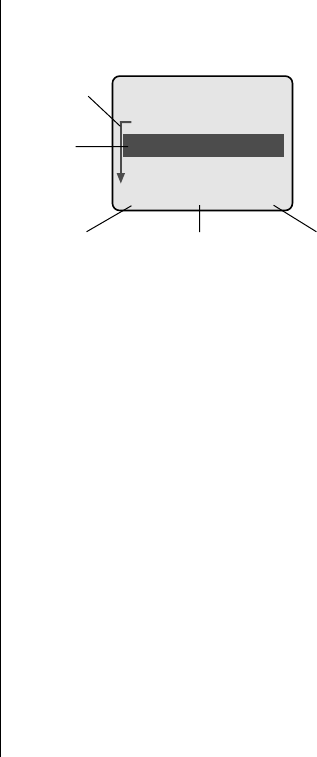
314 Using VoiceNotes
When you launch the VoiceNotes application, you are
presented with a list of recorded VoiceNotes (see following
illustration).
VoiceNote entries are numbered in the order in which they
were recorded, with the oldest entry (number 1) at the
bottom of the list. Each entry is identified by the time and
date when it was recorded.
Press
S
to scroll through the VoiceNotes list and highlight
the entry you want. Alternatively, you can enter a one- or
two-digit number to highlight that VoiceNote entry.
The item
[New VoiceNote]
appears at the end of the list,
after the oldest VoiceNote entry. Selecting this item displays
instructions on how to record a new VoiceNote. If no
VoiceNotes are stored in memory, this is the only item
listed.
A
b
(lock) icon to the left of a VoiceNote entry indicates
that the VoiceNote is locked. See “Locking/Unlocking a
VoiceNote” on page 321 for more information.
---VoiceNotes---
4) 2:20pm 23-Mar
3) 4:05pm 22-Mar
EXITMPLAY
b
Takes you to the
VoiceNotes menu Takes you to the
playback screen
for the highlighted
VoiceNote
Returns you to the
previous screen
Scroll arrow
Lock icon

Using VoiceNotes 315
Playing Back a VoiceNote
To playback a recorded VoiceNote:
Note: You can playback a VoiceNote while a call is in
progress. The VoiceNote will not be transmitted to the called
party.
The Playback Screen
The playback screen is displayed while the VoiceNote plays
in the earpiece/speaker. (see following illustration).
Notes:
•The animated playback meter shows the progression
of the VoiceNote recording.
Find the
feature
1. Press
M
and navigate to the
feature
VoiceNotes
.
Select
VoiceNote
2. Press
S
to scroll to the desired
VoiceNote, and then press
+
to
select.
VoiceNote X
SAVEMDELETE
Takes you to the
VoiceNotes menu Erases the
VoiceNote
Returns you to the
previous screen
VoiceNote
entry number
Right scroll
fast forwards
3 seconds
per keypress
Left scroll
rewinds 3
seconds per
keypress

316 Using VoiceNotes
•A
b
(lock) icon to the left of the
VoiceNote X
label
indicates that the VoiceNote is locked. When you
playback a locked VoiceNote, the right soft key option
changes to
Unlock
. See “Locking/Unlocking a
VoiceNote” on page 321 for more information.
At any time during playback, you can press the following
keys to perform the associated tasks:
Key Function
-
Stops playback and returns you to the
VoiceNotes list.
+
If VoiceNote is Unlocked: Stops
playback and displays a
Delete VoiceNote X?
confirmation
dialog prior to deleting the VoiceNote.
If VoiceNote is Locked: Stops playback
and unlocks the VoiceNote.
*
Stops playback, rewinds the recording
three seconds, and continues playing
from the new position. Press and hold
*
for one second to rewind to the
beginning of the recording.
#
Stops playback, fast forwards the
recording three seconds and continues
playing from the new position. Press and
hold
#
for one second to fast forward to
the end of the recording. If playback is
completed, press
#
to restart playback
from the beginning of the VoiceNote
recording.
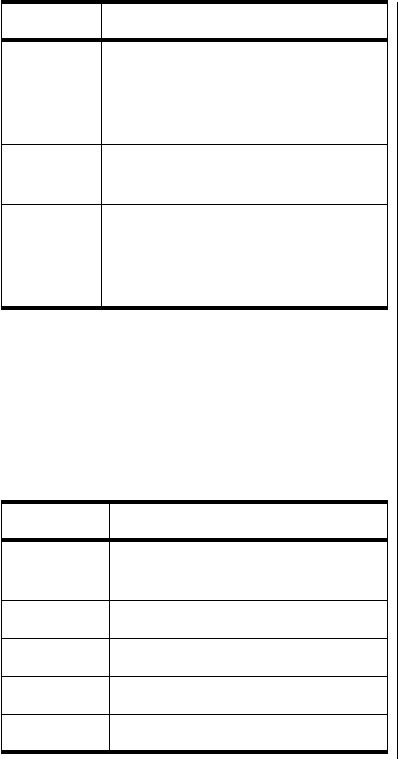
Using VoiceNotes 317
Using the VoiceNotes Menu
The following table shows the complete list of VoiceNotes
menu options accessible from the VoiceNotes list and the
playback screen. Only options that are applicable to the
highlighted/selected VoiceNote are displayed when you
access this menu.
M
Stops playback and takes you to the
context-sensitive VoiceNotes menu. (See
“Using the VoiceNotes Menu” on
page 317.)
0
-
9
Press any number key to alternately start
and stop VoiceNote playback.
S
Stops playback and proceeds to the
playback screen for the next VoiceNote
(up scroll) or the previous VoiceNote
(down scroll) in the list.
Menu Item Description
New
Displays VoiceNote recording
instructions.
Lock
Locks the VoiceNote.
Unlock
Unlocks the VoiceNote.
Delete
Deletes the VoiceNote.
Delete All
Deletes all unlocked VoiceNotes.
Key Function

318 Using VoiceNotes
Note: When you exit the VoiceNotes menu and return to the
playback screen, the playback position is stopped and
queued where it left off when the menu was accessed. You
must press
#
to restart playback.
Viewing VoiceNote
Recording Instructions
You can use several methods to display instructions for
recording a new VoiceNote.
Note: If you try to view the recording instructions when
VoiceNotes memory is full, you will see the message
VoiceNotes Memory Full
. See “Deleting a VoiceNote
Entry” on page 323 to free some memory.
From the VoiceNotes List
Memory
Displays the amount of VoiceNotes
memory in use, and gives you the option
of clearing memory.
Select
option
1. From the VoiceNotes list, press
S
to scroll to the
[New VoiceNote]
option, and then press
+
to
select.
Menu Item Description

Using VoiceNotes 319
From the VoiceNotes Menu
Read
instructions
2. Press
S
to scroll through the
VoiceNote recording instructions
one line at a time.
or
Press
+
to display the next
page of text.
Exit
3. Press
-
to return to the
previous dialog.
or
Press
O
return to the main dialog.
Select
option
1. From the VoiceNotes menu,
press
S
to scroll to the
New
menu
option, and then press
+
to
select.
Read
instructions
2. Press
S
to scroll through the
VoiceNote recording instructions
one line at a time.
or
Press
+
to display the next
page of text.
Exit
3. Press
-
to return to the
previous dialog.
or
Press
O
return to the main dialog.

320 Using VoiceNotes
From a Shortcut
You can assign a shortcut that takes you directly to the new
VoiceNote recording instructions. See “Creating and Using
Shortcuts” on page XX for shortcut information.
Recording a VoiceNote
Begin
recording
1. Press and hold the Voice key on the
right side of your phone for one
second to begin recording. A tone
sounds in the earpiece, and the
recording window displays a timer
that tracks the length of the recorded
VoiceNote.
Note: You must continue pressing
the Voice key to record a VoiceNote.
Record
VoiceNote
2. After the tone, leave your message
by speaking normally into the phone.
You can also record a phone call.
This is convenient for saving things
like phone numbers and directions.
Note: Use of this function is subject
to varying state and federal laws
regarding privacy of phone
conversations.

Using VoiceNotes 321
Locking/Unlocking a
VoiceNote
When a VoiceNote is locked, it cannot be deleted. This
prevents you from inadvertantly deleting an important
VoiceNote.
Locking a VoiceNote
Stop
recording
3. When you are finished, release the
Voice key to stop recording.
A confirmation notice is displayed
with the VoiceNotes list number and
the total recording time. The phone
then displays the VoiceNotes list with
the new entry highlighted.
If the current VoiceNote uses up the
remaining memory while recording,
the recording window is replaced
with the message
VoiceNotes Memory Full
. The
partially recorded VoiceNote is
stored in the VoiceNotes list.
Go to
VoiceNotes
menu
1. Highlight the desired entry in the
VoiceNotes list, and then press
M
to go to the VoiceNotes
menu.
Tip:
A
b
(lock) icon
beside a
VoiceNote
entry indicates
that the
VoiceNote is
locked.

322 Using VoiceNotes
Unlocking a VoiceNote
or
When the desired VoiceNote is
displayed on the playback screen,
press
M
to go to the
VoiceNotes menu.
Select
option
2. Press
S
to scroll to
Lock
, and
then press
+
to select.
Exit
3. Press
-
to return to the
previous dialog.
or
Press
O
return to the main dialog.
Go to
VoiceNotes
menu
1. Highlight the desired entry in the
VoiceNotes list, and then press
M
to go to the VoiceNotes
menu.
or
When the desired VoiceNote is
displayed on the playback screen,
press
M
to go to the
VoiceNotes menu.
Select
option
2. Press
S
to scroll to
Unlock
, and
then press
+
to select.
Tip:
A
b
(lock) icon
beside a
VoiceNote
entry indicates
that the
VoiceNote is
locked.

Using VoiceNotes 323
Alternatively, you can use the following procedure to unlock
a VoiceNote directly from the playback screen:
Deleting a VoiceNote Entry
You can remove unwanted entries from VoiceNotes
memory.
Exit
3. Press
-
to return to the
previous dialog.
or
Press
O
return to the main dialog.
Unlock
VoiceNote
1. When the desired VoiceNote is
displayed on the playback screen,
press
+
to unlock it.
Exit
2. Press
-
to return to the
previous dialog.
or
Press
O
return to the main dialog.

324 Using VoiceNotes
Tip:
A
b
(lock) icon
beside a
VoiceNote
entry indicates
that the
VoiceNote is
locked.
Note: You cannot delete a locked VoiceNote. See “Locking/
Unlocking a VoiceNote” on page 321 for instructions on how
to unlock a locked VoiceNote.
Go to
VoiceNotes
menu
1. Highlight the desired entry in the
VoiceNotes list, and then press
M
to go to the VoiceNotes
menu.
or
When the desired VoiceNote is
displayed on the playback screen,
press
M
to go to the
VoiceNotes menu.
Select
option
2. Press
S
to scroll to
Delete
, and
then press
+
to select.
The phone display asks if you
want to
Delete VoiceNote X?
Confirm
deletion
3. Press
-
to delete the
VoiceNote.
or
Press
+
to return to the
VoiceNotes list or playback screen
without deleting the VoiceNote.
Exit
4. Press
-
to return to the
previous dialog.
or
Press
O
return to the main dialog.

Using VoiceNotes 325
Alternatively, you can use the following procedure to delete
a VoiceNote directly from the playback screen:
Deleting All VoiceNotes
You can save time by deleting all VoiceNote entries at one
time instead of deleting multiple individual entries.
Delete
VoiceNote
1. When the desired VoiceNote is
displayed on the playback screen,
press
+
to delete it.
The phone display asks if you
want to
Delete VoiceNote X?
Confirm
deletion
2. Press
-
to delete the
VoiceNote.
or
Press
+
to return to the
VoiceNotes list or playback screen
without deleting the VoiceNote.
Exit
3. Press
-
to return to the
previous dialog.
or
Press
O
return to the main dialog.

326 Using VoiceNotes
Tip:
A
b
(lock) icon
beside a
VoiceNote
entry indicates
that the
VoiceNote is
locked.
Note: You cannot delete a locked VoiceNote. See “Locking/
Unlocking a VoiceNote” on page 321 for instructions on how
to unlock a locked VoiceNote.
Checking VoiceNotes
Memory Capacity
Use this option to view the amount of memory used and
remaining in VoiceNotes memory. When viewing the
Go to
VoiceNotes
menu
1. When the VoiceNotes list or the
playback screen is displayed,
press
M
to go to the
VoiceNotes menu.
Select
option
2. Press
S
to scroll to
Delete All
,
and then press
+
to select.
The phone display asks if you
want to
Delete All VoiceNotes?
Confirm
deletion
3. Press
-
to delete all unlocked
VoiceNotes.
or
Press
+
to return to the
VoiceNotes list or playback screen
without deleting any VoiceNotes.
Exit
4. Press
-
to return to the
previous dialog.
or
Press
O
return to the main dialog.

Using VoiceNotes 327
remaining memory, you have the option of deleting all
unlocked VoiceNotes to clear more memory.
Go to
VoiceNotes
menu
1. When the VoiceNotes list or the
playback screen is displayed,
press
M
to go to the
VoiceNotes menu.
Select
option
2. Press
S
to scroll to
Memory
, and
then press
+
to select.
The phone displays a completion
meter that shows the approximate
percentage of VoiceNotes memory
in use.
Select
option
3. Press
+
to delete all unlocked
VoiceNotes.
or
Press
-
to return to the
VoiceNotes list or playback screen
without deleting any VoiceNotes.
Exit
4. Press
-
to return to the
previous dialog.
or
Press
O
return to the main dialog.

328
Hands-Free Use
The hands-free car kit provides the convenience of
hands-free speaker-phone operation while you are driving
your vehicle. (Refer to “Accessory Limited Warranty
Information” on page 380 for details.) The Car Settings
menu lets you adjust features related to using your phone
with the hands-free car kit or other hands-free accessories.
In this chapter you will learn how to:
•set your phone to automatically answer after two
rings
•route your phone’s audio to an attached car kit
•power down your phone at a set time after you turn
off the ignition
•control how long the phone battery continues to
charge after you turn off the ignition
Menu Features
Settings
Other Settings
Car Settings
Auto Answer
Auto Handsfree
Power-off Delay
Charger Time

Hands-Free Use 329
Setting Automatic Answer
You can set your phone to automatically answer incoming
calls after two rings.
Note: This feature takes effect only when the phone is
connected to a hands-free device, such as a car kit or
headset.
Setting Automatic
Hands-Free
This feature routes the phone audio to an attached car kit
for hands-free operation. This feature takes effect only
when the phone is connected to an appropriate car kit.
Find the
feature
1. Press
M
and navigate to the
feature:
Settings
B
Other Settings
B
Car Settings
B
Auto Answer
Select
setting
2. Press
S
to scroll to
On
or
Off
, and
then press
+
to select.
Exit
3. Press
-
to return to the previous
dialog.
or
Press
O
return to the main dialog.
Find the
feature
1. Press
M
and navigate to the
feature:
Settings
B
Other Settings
B
Car Settings
B
Auto Handsfree

330 Hands-Free Use
Setting the Power-Off Delay
You can set a time delay for powering off the phone when
you turn off your vehicle’s ignition. This can be useful when
you make short stops, so that you don’t have to re-enter the
unlock code each time you turn on the ignition. The
Power-off Delay feature also guards against leaving the
phone on indefinitely and draining the vehicle’s battery
while the ignition is off.
Note: This feature takes effect only when the phone is
connected to an appropriate car kit.
Select
setting
2. Press
S
to scroll to
On
or
Off
, and
then press
+
to select.
Exit
3. Press
-
to return to the previous
dialog.
or
Press
O
return to the main dialog.
Find the
feature
1. Press
M
and navigate to the
feature:
Settings
B
Other Settings
B
Car Settings
B
Power-off Delay

Hands-Free Use 331
Setting the Phone Charge
Time
You can set the phone to charge itself for a period of time
after you turn off your vehicle’s ignition. This can help
ensure that the phone battery gets fully charged while the
vehicle is parked.
Note: This feature takes effect only when the phone is
connected to an appropriate car kit.
Select
setting
2. Press
S
to scroll to the desired time
delay, from zero to sixty minutes or
continuous.
Caution: If you select the
Continuous
option, the phone does not power off when
the ignition is turned off. Be careful not to
inadvertantly drain the vehicle’s battery if
you select this option.
3. Press
+
to select.
Exit
4. Press
-
to return to the previous
dialog.
or
Press
O
return to the main dialog.
Find the
feature
1. Press
M
and navigate to the
feature:
Settings
B
Other Settings
B
Car Settings
B
Charger Time

332 Hands-Free Use
Select
setting
2. Press
S
to scroll to the desired charge
time, from one to eight hours or off.
3. Press
+
to select.
Exit
4. Press
-
to return to the previous
dialog.
or
Press
O
return to the main dialog.

333
The Browser
The Browser is an application provided directly by your
wireless service provider. It delivers customized services
from the wireless server directly to your phone.
Browser sessions can be:
•active sessions that you initiate
•background sessions that the wireless server
automatically or directly initiates
In this chapter you will learn how to:
•start a browser session
•navigate the browser
•place and end calls during a browser session
•run the browser in the background
Note: This chapter does not discuss specific Browser
applications, such as Unwired Planet®. Your phone was
built to enable wireless servers to use any type of browser
application to deliver information.

334 The Browser
Menu Features
Although you cannot predict exactly what is displayed on
the browser menu, its structure is the same as all other
menus.
Starting a Browser Session
Depending on the features supported on your phone or by
your wireless carrier, you can access the browser menu in
any of the following ways:
•select the browser from the main menu
•
•press the browser soft key
•use a browser shortcut
•select a URL from a message
Selecting Browser from the Main
Menu
To open the browser menu:.
Browser Menu
Service 1
Determined by the wireless carrierService 2
Service 3
Find the
feature
1. Press
M
and navigate to the
feature
Browser
.
Note: The browser menu item is
always positioned after SIM.

The Browser 335
As soon as you select the browser from the main menu, the
wireless server begins an active browser session.
Note:
Using the Browser Soft Key to Select
the Browser
If you have personalized your phone to display a browser
soft key, simply press the
+
soft key to begin an active
browser session.
Using the Browser Shortcut
If you have created a browser shortcut, it is available from
the
Recent Calls
menu. To begin a browser session using
a shortcut:
Access
item
2. Press
S
to scroll to a menu item, such
as
Service 1
. Press
+
.
Exit
3. Press
-
to exit.
Find the
feature
1. Press
M
and navigate to the
Recent Calls
feature.
2. When the
Recent Calls
menu opens,
navigate to the
Browser Home Page
.
Select
service
3. Press
S
and select a browser service.
4. Press
+
to select a service.

336 The Browser
Note: You can mark any screen within a browser session
for a shortcut that is stored on the phone. See “Shortcuts”
for more information.
Using a URL to Initiate the Browser
If a text message or an Information Services message
includes a URL (web address) either in the header or as
part of the message text, you can use the phone’s menu to
go directly to the URL. To use a URL to start a browser
session:
Start
session
Your phone may or may not support
active calls during a browser session. If
you have a call in progress when you
select a service, and the phone does
not support both a call and a browser
session, it displays the message
Going
to Browser will end call
.
5. Press
+
to end the call and begin
the browser session.
or
6. Press
-
to cancel the browser
session.
Find the
feature
1. Press
M
and navigate to the
feature
Information Services
.
2. Begin an interactive services session.
3. Display interactive service text.

The Browser 337
Error Messages
You may not able to connect to a specific browser service.
Following are some common error messages:
Navigating the Browser
Unless you specify a URL when you begin a browser
session, the session always starts with your home page.
From your home page you can start applications or go to
bookmarks and services provided by content suppliers.
Open
Info
Services
4. When the text message or message
header displays a URL that you want to
open, press
M
to display the
Information Services
sub-menu.
Find
Go to
5. Navigate to the
Go to
menu item.
6. Press
+
to select
Go to
.
The phone starts an active browser
session and goes to the selected URL.
Browser not
available
The wireless server is unable to make
a browser connection.
Home Page
not available
If you are able to connect to the
browser server, but not to the URL,
either the browser server is busy or
the stored URL is incorrect.
Home Page
not setup
The URL you want is not stored in the
phone.

338 The Browser
Home Page Setup
Some home page information, like your home page URL
and browser software name and version number, is stored
on your phone; other home page information, such as
information you or your wireless service adds, is stored on
the wireless server.
Your default home page is
mymotorola.com
. If a wireless
provider requires their own customized home page, then
mymotorola.com
is stored in the phone as an additional
URL.
All home page information stored in your phone is set up
before your phone is shipped. You cannot change this
information.
Home page information that you or your wireless service
adds is stored on the wireless server. You are able to
change this information.
Error Messages
If your phone does not display your home page within two
seconds of starting a browser session, it displays the
Please Wait
message until the home page is displayed or
until it displays the
Home Page Unavailable
message.
Displaying Content
The browser can display information as a
choice card
, a
display card
, or an
entry card
. The browser software
identifies the card type and selects elements on your phone
to use when displaying the information.

The Browser 339
Choice Cards
Choice cards are displayed as lists. To use choice card
information:
Display Cards
Display cards are displayed as text fields. Information is
usually displayed as continuous text, without line breaks or
Find and
display
item
1. Press
M
and navigate to the
Browser
feature.
2. Press
S
to select an item on the
browser menu.
3. Press
+
to start an active browser
session.
Choice
card
4. When a
Choice Card
list is displayed,
press
S
to navigate to an item on the
choice card list.
5. Press
+
to select the item.
•When you press
+
, the
highlighted choice card is selected.
•If a card does not exist, the
+
soft key becomes the first option
identified on the current card.
•An
M
indicates that other options
are available for the item. Press
M
to display the other options.

340 The Browser
punctuation, unless the wireless server adds specific
formatting information. To use display card information:
Entry Cards
Entry cards appear as text or number editors. They ask you
to enter data for the server. To use an entry card:
Find and
display
item
1. Press
M
and navigate to the
Browser
feature.
2. Press
S
to select a browser menu
item.
3. Press
+
to start an active browser
session.
Display
card
When the
Display Card
title appears,
information is displayed as text on the
screen.
4. Press
+
to select the first option
identified on the card.
•When you press
+
, the
highlighted option card is selected.
•An
M
indicates that other options
are available for the item. Press
M
to display the other options.
Find and
display
item
1. Press
M
and navigate to the
Browser
feature.
2. Press
S
to select a browser menu
item.
3. Press
+
to start an active browser
session.

The Browser 341
Shortcuts
You can mark and use any highlighted item in a choice or
display card as a shortcut, except for items in a card sub-
menu. To set up a shortcut to a card:
Entry
card
When the
Entry Card
title appears,
the screen opens to entry form. It asks
you to
Enter Info
.
4. If the line is blank, enter the requested
information and press
+
to submit
it to the browser application.
or
If there is information in the
Enter
Info:
form that needs modification,
press
-
to erase the characters
and re-enter the information. Press
+
to submit the new information.
Find and
display
card
1. Press
M
and navigate to the
Browser
feature.
2. Press
S
to select a browser menu
item.
3. Press
+
to start an active browser
session.
4. Navigate to the desired option or text
on the card display.

342 The Browser
After you have assigned a shortcut, the phone returns you
to the current choice or display card.
•When you mark a card as a shortcut, the choice
card’s URL is stored with your phone’s shortcuts.
•When you access the shortcut, the phone starts an
active browser session and displays the card’s URL.
To use a shortcut to a browser setting:
Set
shortcut
5. With the option or text highlighted,
press and hold
M
for two seconds.
The phone displays the message:
Assign Shortcut ÒItemÓ to key
no: #
where
Item
is the selected option and
the
key number
is the next available
shortcut number.
6. Press
+
to confirm the shortcut.
Confirm
The phone displays the message:
Assigned: Shortcut Menu + #
where
#
is the assigned shortcut
number.
Find
shortcut
1. Press
M
.
2. Enter the shortcut number within two
seconds of pressing
M
.
The phone starts an active browser
session and goes directly to the URL
associated with the shortcut.

The Browser 343
To view the shortcuts in the shortcut list:
Please see the “Shortcuts” chapter for more information on
setting and using shortcuts.
Placing Calls in an Active
Browser Session
During an active browser session, some cards indicate that
a call can be placed to a specified number.
Notes:
•If the number supplied by the card is an emergency
call number, the phone sets up an emergency call as
described in the “Calling” chapter. .
Display
the
shortcut
list
1. Press
M
.
2. Press
S
and navigate to the
Shortcuts
feature.
The phone displays the numbered list
of assigned shortcuts.
•If a card title is available, it is
displayed in the list.
•If a card title is not available, the
card’s URL is displayed in the list.
Select a
shortcut
3. Press
S
to scroll to the desired
shortcut.
4. Press
+
to
Go To
the shortcut.
The phone starts an active browser
session and goes directly to the URL
associated with the shortcut.

344 The Browser
•
•If a call is already in progress, it is placed on hold.
The phone then sets up the second call.
•If the phone cannot set up the call from the browser, it
displays an error message.
•If the card includes a name or card title for the
number being dialed, the phone displays the name to
which the call is being connected. If a name or title is
not available, then the phone displays the number
being dialed. The name, title, or number is then
added to the
Dialed Calls
list.
To place such a call:
Display
a card
1. Press
M
and navigate to the
Browser
feature.
2. Press
S
to select a browser menu
item.
3. Press
+
to start an active browser
session and display a card.
Select
the call
4. Press
S
to scroll to the available call,
for example, to
Customer Service
.
5. Press
+
to send the call.

The Browser 345
Ending Calls in an Active
Browser Session
A browser either can or cannot remain active during a call.
The following conditions and resulting actions occur:
Running the Browser in the
Background
Some phones are configured so that a browser session is
started in the background when the phone registers with a
network. There is no indication that a browser session is in
progress, other than the signal strength meter.
Condition Action
The browser application
does
not
specify that the
browser should remain
active during a call.
The phone ends the browser
session when the call is
connected. It returns the
phone to the idle state when
the call ends.
The browser application
specifies either that the
browser should:
•remain active during a
call
•return to the
application when the
call has ended
The phone displays the
Return to Browser?
message.
Press
-
to return to the
browser. Press
+
to end
the browser session and
return the phone to the idle
state.

346 The Browser
If your phone supports background browser sessions, the
setup option for that feature is available in the
Info Srvc
Setup
menu.
Setting up a Background Browser
Session
Some phones are set up to start a browser session in the
background when you power them on. Your wireless
carriers uses the background session to deliver information
services or other types of services to the phone. Other than
the signal strength meter, there is no indication that a
browser session is in progress
Turning a Background Browser
Session On or Off
If your phone is set up to run browser sessions in the
background, a setup option is available in the
Info Srvc
Setup
submenu. The factory default setting for background
browser sessions is
On
. To turn background browser
sessions
On
or
Off
:
Find the
feature
1. Press
M
and navigate to the
Info
Srvc Setup
feature.
2. Press
S
to scroll to
Browser
Services
.
3. Press
+
to open
Browser
Services
.

The Browser 347
Setting Up Background Browser
Session Channels
When the phone is set up for background browser
sessions, you must set up channels, or folders, to indicate
your preferred type of services. These channels are specific
to your wireless carrier and must be set up in the wireless
server. Please contact your wireless carrier for a list of
available options, channels or folders.
To set up background browser session channels:
Change
setting
4. Press
S
to toggle the background
browser
On
or
Off
.
5. Press
+
to confirm the change.
The phone briefly displays the
Changed: Service On
(or
Off
)
message and returns you to the
Browser Services
feature.
Find the
feature
1. Press
M
and navigate to the
Info
Srvc Setup
feature.
2. Press
S
to scroll to
Browser
Services
.
3. Press
+
to open
Browser
Services
.
4. Press
S
to scroll to
Options
.
Open
Options
5. Press
+
to open the
Options
feature.
The phone opens an active browser
session.

348 The Browser
Getting Information Via a Background
Browser Session
Obtaining information from a background browser session
is the same as obtaining information from a cell broadcast.
The phone displays a message dialog box and gives you
the option to read the
Info Service
message. Please see
the “Messages” chapter to learn how to navigate the
Info
Service Inbox
and to manage messages.
Open
URL
6. Open your home page or go to the
URL your wireless carrier has
designated as the place to set up
folders or channels.
7. Set up your options.
Exit
8. Press
-
to end the browser
session and return to the idle state.

349
Network Services
The Network menu allows you to change settings related to
network features. In this chapter, you will learn how to:
•view the currently registered network
•display available networks
•register on a network
•find a new network
•change network setup values
•change network setup types
•specify preferred networks
•set service tones
•set the call drop alert
Menu Features
Main Menu
Settings
•Other
Settings
Network
Current Network
Network Setup
Mode
Type

350 Network Services
Viewing the Currently
Registered Network
All phones register to a network in order to place and to
receive calls. The following steps describe how to view the
Network ID or name on which your phone is registered:
Displaying Available
Networks
Some phones provide a menu option that allows you to
view a list of available non-public networks. This feature is
useful when you want to register on a desirable network
and you:
Search Type
Service Tone
Call Drop Tone
Find the
feature
1. Press
M
and navigate to the
Network
feature.
2. Press
S
to scroll to
Current
Network
.
Display
Network
ID
3. Press
+
to view the network
registration.
The phone displays the five digit
system ID or the network name.
4. Press
-
to exit.

Network Services 351
•enter a new city, region, or country
•are unfamiliar with area networks
To display the non-public list:
Find the
feature
1. Press
M
and navigate to the
Network
feature.
2. Press
S
to scroll to the
New
Network
menu item.
3. Press
+
to select
New Network
.
Display
list
4. Press
S
to scroll to
Non-Public
List
.
5. Press
+
to select it.
The phone displays the
Searching
for Networks. Please Wait
message.
•When the phone has resolved the
list of available networks, it displays
them sorted by signal strength.
Networks are listed in descending
order of signal strength.
•If the phone is not registered on a
network when you try to view
Current Network
, it displays a
Not Registered
message and
returns to the previous display.
Display
Network
ID
6. Press
S
to move down the list.
7. Press
+
to display an entry.

352 Network Services
Registering on a Network
When you display network registration information, you can
register on the displayed network. To register on a displayed
network:
Finding a New Network
Because of network coverage or roaming conditions,
sometimes you may want to switch to another network to
Find the
feature
1. Display the Non-Public Network List.
See “Displaying Available Networks”
on page 350 for details.
Select a
network
2. Press
S
to scroll through the list of
available networks and highlight a
network.
Register
3. Press
M
to display the network
sub-menu and highlight
Register
Now
. Press
+
to register.
or
4. Press
+
to select a highlighted
network. When the network details are
displayed, press
+
to register.

Network Services 353
improve the calling conditions. To search for and select a
new network:
Find the
feature
1. Press
M
and navigate to the
Network
feature.
2. Press
S
to scroll to the
New
Network
menu item.
3. Press
+
to select it.
The phone displays the
Searching
for Network
message.
If a network is available and test
registration is successful, the phone
displays the
Network System ID
.
Register
phone
4. Press
-
to register the phone.
The phone displays the
Registering
message, then displays the message:
Registered: Sys ID #####
The messages time out and the phone
returns to the
Network
menu.
or

354 Network Services
After you successfully register on a new network, the phone
remains on the network until:
•You turn off the phone.
•A call is originated and terminated.
•The signal strength falls below a specified level.
•You register to a different network.
When you leave a network system, the phone automatically
changes the network registration from
New Network
to
Normal
.
Continue
search
5. Press
+
to continue searching for
the next available network.
The phone displays the message:
Continue Non-Public Search?
6. Press
-
to continue searching
until no more networks are found or
until you select a network on which to
register.
If your search does not find any non-
public networks, or if you search
through and reject all available
networks, the phone displays the
message:
Non-Public Not Available
and returns to the
Network
menu.
Exit
7. Press
+
to end your search and
return to the
Network
menu.

Network Services 355
Finding a Public Network
A normal network scan may lead you to register your phone
on a private network. Once you are registered on a private
network, you may want to re-register on a public network.
To find a public network:
Changing Network Setup
Values
Use the Network Setup feature to change the mode, type,
or call mode. Actual field names and values may change
Find the
feature
1. Press
M
and navigate to the
Network
feature
2. Press
S
and scroll to
New Network
.
Press
+
to select it.
3. Press
S
and scroll to
Use Public
.
4. Press
+
to select
Use Public
.
Search
The phone displays the
Searching for
Network
message.
When it finds a public network, it displays
the
Registering
message.
•f you search for a public network when
your phone is already registered to a
public network, the phone displays a
Public Registered
message.
•If you search for a public network and
none is available, the phone displays a
Public Not Available
message.

356 Network Services
depending on available technologies of the wireless
carriers. To change network setup values:
Each of the procedures outlined below uses the
Network
Setup
form.
Changing Mode
Phones that allow you to select the mode include a
Mode
field in the Network Setup form. Available modes include:
To change the mode:
Find the
feature
1. Press
M
and navigate to the
Network Setup
feature.
2. Press
+
to select
Network
Setup
.
The phone displays the
Network
Setup
form.
Digital Preferred Places calls on a digital voice channel
if available. Otherwise, uses an analog
voice channel.
Analog Only Places calls only on analog channels.
Digital only Places calls only on digital channels.
Find the
feature
1. Open the
Network Setup
form.
2. Press
S
to navigate to the
Mode:
field.
3. Press
+
to change the mode.

Network Services 357
Changing Type
Type values vary with each phone. They may include:
Preferred List (scans for networks on the preferred list
only), Home Only (scans for networks that match the home
setting), Automatic, Standard A/B, Reverse B/A, A Systems
only, and B Systems only.
To change the type:
Select
mode
4. Press
S
to scroll down the list of
modes.
5. Press
+
to select a mode.
The phone briefly displays a
Changed:
Mode
message and returns to the
Network Setup
form.
Confirm
change
6. Press
-
to confirm the change.
The network mode immediately
changes to the selected mode.
If you have selected Analog only, the
setting reverts to Digital Preferred if the
phone is turned off or when a call is
placed and ended.
Find the
feature
1. Open the
Network Settings
form.
2. Press
S
to navigate to the Type: field.
3. Press
+
to change the type.

358 Network Services
Changing Network Search
Types
Some phones allow you to specify the type of network
search that is performed when your phone searches for a
network as it powers up and registers.
Search Values
Network search values include:
Select
type
4. Press
S
to scroll down the list of
available types.
5. Press
+
to select a type.
The phone briefly displays a
Changed:
Type
message and returns to the
Network Settings
form.
Confirm
change
6. Press
-
to confirm the change.
Home only Searches only for networks that match
the Home Network ID number
Automatic Searches with standard roaming lists

Network Services 359
Accessing Search Types
To access the network search type:
Changing Search Type
To change the search type:
Find the
feature
1. Press
M
and navigate to the
Network
feature.
2. Press
+
to display the
Network
menu.
3. Press
S
to scroll to the
Search Type
feature.
Display
feature
4. Press
+
to select the
Search
Type
feature.
Find the
feature
1. Press
M
and navigate to the Search
Type feature.
2. Press
+
to display the Search Type
details.
Change
type
3. Press
S
to toggle between
Home
Only
and
Automatic
.
4. Press
+
to confirm the selection.
The phone briefly displays a
Changed:
Search Type
message and returns
you to the
Network
menu.

360 Network Services
Setting Service Tones
Some phones are set up to use the service tone feature.
When the phone uses the service tone feature, it beeps
each time the registration status changes.
Registration changes include:
•losing network coverage
•regaining network coverage
•powering up and registering on a network
•roaming and registering onto another Network ID
Accessing Service Tones
To access the service tone setting:
Find the
feature
1. Press
M
and navigate to the
Network
feature.
2. Press
+
to display the
Network
menu.
3. Press
S
to scroll to the
Service Tone
feature.
Display
feature
settings
4. Press
+
to display
Service Tone
settings.

Network Services 361
Adjusting Service Tone Settings
Shortcut:
Once you
navigate to the
feature, press
#
to toggle
the setting
On
or
Off
.
You can toggle service tone settings on or off:
Setting the Call Drop Alert
Some phones include a call drop feature, which, when
turned on, produces an audible tone whenever the network
has just dropped a call. Because digital networks are so
quiet, the call drop alert is needed to tells you that a call has
been dropped.
Find the
feature
1. Press
M
and navigate to the
Service Tone
feature.
2. Press
+
to change
Service Tone
settings.
Change
settings
3. Press
S
to toggle between
On
and
Off
selections.
4. Press
+
to confirm the selection.
The phone briefly displays the
message:
Changed: Service Tone On
(or
Off
)
and returns to the
Network
sub-
menu.

362 Network Services
Accessing the Call Drop Tone
To access the call drop tone feature:
Adjusting the Call Drop Tone Setting
Shortcut:
Once you
navigate to the
feature, press
#
to toggle
the setting
On
or
Off
.
To adjust call drop tone settings:
Find the
feature
1. Press
M
and navigate to the
Other Settings
feature.
2. Press
+
to select
Other
Settings
.
3. Press
S
to scroll to the
Network
feature.
4. Press
+
to display
My Network
List
.
5. Press
S
to scroll to
Call Drop Tone
.
Display
settings
6. Press
+
to display
Call Drop
Tone
settings.
Find the
feature
1. Press
M
and navigate to the
Call
Drop Tone
feature.
2. Press
+
to change
Call Drop
Tone
settings.
Change
setting
3. Press
S
to toggle the setting
On
or
Off
.
4. Press
+
to confirm the change.
The phone briefly displays a
Changed:
Call Drop To On
(or
Off
) message
and returns you to
My Network List
.

363
Interactive Services
Interactive services is a messaging service, provided by
some wireless vendors, that lets you download text
information about things like traffic and restaurants. It
supports limited two-way text messaging between the
wireless provider and phone subscribers.
Interactive services is called
Info on Demand
in the
phone’s menu system. In this chapter, you will learn how to:
•use the interactive services menu
•select and access interactive services
•interact with a service
Menu Features
The interactive services menu on your phone is a
top menu
or a cover menu for items provided by your wireless carrier.
Since the items can change at any time, the top menu
provides a way to display whatever menu items are
available.
Interactive Services Menu
Info on Demand The menu title for the wireless
carrier’s sub-menu items.
Traffic Info Common wireless carrier service
Restaurants Common wireless carrier service
Reconnect Reconnects you to the service you
last used
Enter Title
Enter Code

364 Interactive Services
Starting an Interactive
Service
To start an interactive service:
Displaying Text
During an interactive session, your phone displays text sent
from the wireless server.
•If all of the interactive services information is
contained within the display, press
+
when you
are done to return to the previous screen.
•If more information is available than can be displayed
on the screen, press
+
to display the additional
information. Press
-
to return to the previous
screen.
Start
Info On
Demand
1. Press
M
. Navigate to the feature
Info On Demand
.
2. Press
+
.
An interactive service session begins.
Select
service
3. Press
S
to select a service.
4. Press
+
to select a service.
or
Press
M
to display the service
submenu.
Exit
5. Press
-
to exit.

Interactive Services 365
Providing Input
Sometimes, while responding to your interactive service
requests, the wireless server asks you for information.
When this happens, the phone displays:
Enter Data
(for
text) or
Enter Digits
(for numbers) and provides a line in
which to input text or numbers.
To respond to an
Enter Data
or
Enter Digits
request:
Displaying Help Information
If the server provides help information for an interactive
service, the phone displays
M
for
Menu
in the center of the
last display line.
To display help for an interactive service:
Enter
data
1. Use the keypad letters and numbers to
enter the requested data.
Accept
or
change
2. Press
+
to accept the data
or
Press
-
to delete any incorrect
characters. Re-enter the information
and press
+
.
Get
service
The phone displays the
Please Wait
message while it reads the data you
entered. When the data is read, the
phone connects the service.
Open
help
menu
1. Press
M
.
The phone displays a
Please Wait
message.

366 Interactive Services
Reconnecting
Reconnecting is an option that may or may not be offered
by your wireless carrier. Reconnecting allows you to use the
menu to bring up the service you last used.
To reconnect to the last service:
Select
details
2. Press
S
to select
Details
.
3. Press
+
to display help
information.
View
details
The phone displays help details.
4. Press
+
to display more help
information.
Exit
Press
-
to exit interactive services
help.
Start Info
On Demand
1. Press
M
. Navigate to the
feature
Info On Demand
.
2. Press
+
.
An interactive service session
begins.
Reconnect
3. Press
S
to
Reconnect
.

Interactive Services 367
4. Press
+
.
The phone displays a
Please
Wait
message while it reconnects
you to the title of the last interactive
service used.
When reconnected, the phone
displays the last service. menu
Display
Details
5. Press
+
to display detailed
interactive service information.
The phone displays a
Please
Wait
message while it reconnects
you to the details of the last
interactive service used.
6. Press
S
to
help info for
to
display any available help
information.
or
Press
S
to get to the title of the
service.
7. Press
+
to display detailed
information.
Exit
8. Press
-
to exit.

368 Interactive Services
Entering Titles
You can enter the title of the interactive service. This title is
actually a shortcut to a particular category. To start an
interactive service by entering a title:
Entering Codes
The Enter Code menu item is a shortcut that allows you to
enter the code to start an interactive session. The code is a
map to a particular category.
Find the
feature
1. Press
M
. Navigate to the feature
Enter Title
.
2. Press
+
.
Enter
Title
3. Enter the interactive service title.
4. Press
+
.
The phone displays a brief
Please
Wait
message.
The title is displayed as the top of a
menu that contains sub-menu items for
the service you have requested.
Get Info
5. Press
S
to the information you want.
6. Press
+
to select it.
Exit
7. Press
-
to exit.

Interactive Services 369
To start an interactive service by entering a code:
Recognizing Error
Conditions
If the interactive service cannot connect with the requested
session, the phone displays an error message. Errors can
occur when the phone is unable to connect with the server
or when you make a mistake in entering interactive titles or
codes. The errors listed below only occur when you use
shortcuts in the menu to start an interactive session.
Find the
feature
1. Press
M
. Navigate to the feature
Enter Code
2. Press
+
.
The phone displays the
Enter Code
form.
Enter
the
Code
3. Enter the interactive services code.
4. Press
+
The phone displays a brief
Please
Wait
message and then displays the
Interactive Service submenu.
Select
the
Service
5. Press
S
to the service you want to
initiate.
6. Press
+
.
Exit
7. Press
-
to exit.

370 Interactive Services
Reconnecting Error
Some wireless carriers can only support reconnection for a
limited period of time. If the time period has expired, the
phone displays a
Reconnect not available
error
message.
Input Error
If you have entered an incorrect title or code and the
interactive service cannot connect, the phone displays a
Title not allowed
or
Code not allowed
message.
Interacting with a Service
Setting Up a Message With a Call-
Back Number
You can send a message with a call-back number to begin
an interactive session. If you select this option, the wireless
server takes the phone number from your message and
instructs the phone to set up a voice call.
If your wireless provider has made the technology available,
the server can:
•set up a call when no other calls are in progress
•place all other calls on hold and set up a call
•end any other calls and set up a call
•end interactive services calls

Interactive Services 371
Setting up a Call (No Calls In Progress)
To set up a call when no other calls are in progress:
Setting up a Call (Place Other Calls On
Hold)
When a call is in progress, the phone displays a
Connected
message with the person’s name.
Notes:
•The original call is placed on hold before the new call
is set up.
Find the
feature
1. Press
M
.
2. Press
S
to
Info on Demand
.
3. Press
+
to open interactive
services sub-menu.
Select
service
4. Press
S
to find the interactive service
you want to start.
5. Press
+
to select the service and
begin the session.
If the call back message includes text,
it displays the name of the service, for
example:
Calling...Traffix
.
If the call back message does not
include text, the message displays the
call back number, for example:
Calling...5557000
.
Service
Connect
When the call is complete, the phone
moves to the In Call state.

372 Interactive Services
•The original call is placed on hold only if your wireless
provider supports the technology. Please contact your
provider for more information.
To set up a call while another call is in progress:
Setting up a Call (End Other Calls)
When a call is in progress, the phone displays a
Connected
message with the person’s name.
Find the
feature
1. Press
M
.
2. Press
S
to
Info on Demand
.
3. Press
+
to open interactive
services sub-menu.
Select
service
4. Press
S
to find the interactive service
you want to start.
5. Press
+
to select the service and
begin the session.
If the call back message includes text,
it displays the name of the service, for
example:
Calling...Traffix
.
If the call back message does not
include text, the message displays the
call back number, for example:
Calling...5557000
.
Service
Connect
6. When the call is complete, the phone
moves to Active Call + Call on Hold
state.
Switch
7. Press
+
to switch between the
calls.

Interactive Services 373
To set up a call and end any other calls in progress:
Ending an Interactive Services Call
When normal calls end, the phone returns to the idle
display. When an interactive services call ends, the phone
gives you the option to return to
Info on Demand
.
Find the
feature
1. Press
M
.
2. Press
S
to
Info on Demand
.
3. Press
+
to open interactive
services sub-menu.
Select
service
4. Press
S
to find the interactive service
you want to start.
5. Press
+
to select the service and
begin the session.
The phone displays the
Call Ended
message.
If the call back message includes text,
it displays the name of the service, for
example:
Calling...Traffix
.
If the call back message does not
include text, the message displays the
call back number, for example:
Calling...5557000
.
Service
Connect
6. When the call is complete, the phone
moves to the In Call state.

374 Interactive Services
To end an interactive services call:
Sending a Text Message
Sometimes when setting up interactive sessions, the
remote server asks you to enter information.
When an interactive session requires more information, the
call progresses as follows:
End the
call
1. Press
N
.
The phone displays the
Return to
Info on Demand?
message.
New
Service?
2. Press
-
to return to the
Info on
Demand
menu.
3. Press
+
to exit the
Info on
Demand
application.
Exit
4. The phone returns to the idle display.
Find the
feature
1. Press
M
.
2. Press
S
to
Info on Demand
.
3. Press
+
to open interactive
services sub-menu.
Start
the
session
4. Press
S
to find the interactive service
you want to start.
5. Press
+
to select the service and
begin the session.
Enter
info
6. The server asks you for information.
Use the keypad to enter letters or
numbers.

Interactive Services 375
Service
Connect
7. The interactive service connects and
displays requested information.
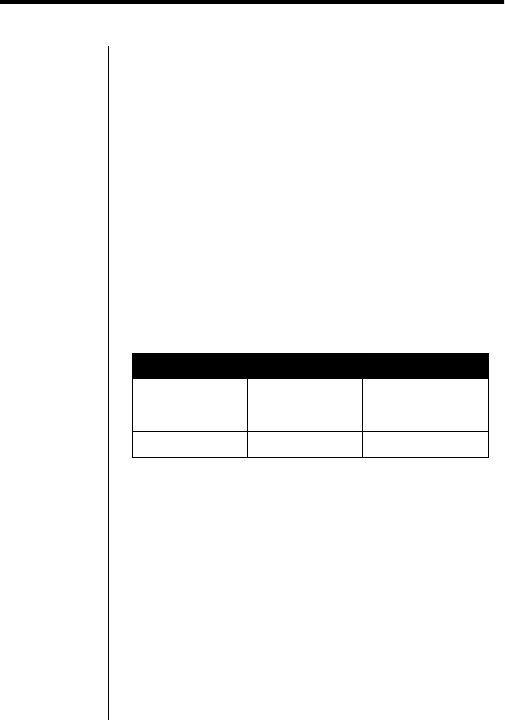
376
Infrared Connections
Some phones can connect to devices such as fax machines
or computers without wires. These connections are made
using infrared data links.
In this chapter you will learn how to establish an infrared
connection from your phone to other devices that accept
infrared links.
Important: In order to create and maintain an infrared
connection, the phone must be within one meter
(approximately three feet) of the other infrared device.
Nothing can block the line of sight between the two devices.
Menu Features
Establishing an Infrared
Connection
To establish an infrared connection:
Main Menu
Settings
Connection
IRDA Links
Find the
feature
1. Press
M
and navigate to the
feature
IRDA Links
.

Infrared Connections 377
Activate
link
2. Press
+
to activate the IRDA link.
The Infrared Link activates and
searches for a compatible device.
The phone displays the message:
Infrared link connecting
This message continues for 60
seconds or until the link is established
(whichever comes first).
When the phone successfully links with
another infrared device, it displays the
message:
IRDA link is active
Retry
link
If the phone does not find an infrared
device, it displays the message:
Infrared link failed. Retry now?
3. Press
-
to attempt another
connection.
Exit
4. Press
+
to abandon the
connection attempt.

378
Accessories
An exciting line of Motorola accessories, now smaller and
lighter than ever, can enhance and personalize your
wireless experience.
Lithium Polymer Batteries
Motorola’s Polymer (LilON) batteries
are high-energy density batteries that
offer increased capacity and are light in
weight.
Simple Desktop Charger
The simple Desktop Charger has one
pocket that can charge a battery
attached to a phone. An AC adapter is
required.
Dual-Pocket Desktop Charger
This desktop charger can be loaded
with two batteries at once. , The
charger’s front pocket can charge a
battery attached to a a phone, and the
rear pocket can charge a battery by
itself. An AC adapter is required.
Add
Illustration
Add
Illustration
Add
Illustration

Accessories 379
Travel Chargers
Standard, economy, and Rapid Travel
travel chargers are available to
conveniently charge your batteries. The
standard and Rapid Travel chargers use
universal voltage with Klaus adapters,
whereas the economy charger uses a single voltage with
fixed plugs.
Headset
The convenient mono headset provides
both an earphone and microphone in
one small piece for simple hands-free
and private telephone conversations.
The headset plugs directly into the jack
on the top of your phone, so that you can wear your phone
and move freely. Place the foam cover on the earpiece for a
more comfortable fit. This headset includes a send/end
button.
Holster
Your phone is so small and light, it is
positively wearable. Slip it in and clip it
on—for the ultimate in high-tech
fashion.
Add
Illustration
Add
Illustration
Add
Illustration

380 Accessories
Accessory Limited Warranty
Information
We recommend that you use Motorola original batteries
and accessories. Under its limited wireless telephone
warranty, Motorola specifically disclaims any responsibility
for damage caused by the use of portable wireless
telephone accessories not manufactured by Motorola.
For details on the complete line of Motorola wireless
accessories, see your dealer or visit our Web site at
http:/
/www.motorola.com/.

Troubleshooting 381
Troubleshooting
Question Answer
I pressed the
power button,
but nothing
happened.
What’s wrong
with my phone?
Be sure to press and hold the power button until the
display appears and you hear an audible alert. If
nothing still happens, check that you have installed a
battery and that the battery is charged. For more
information about batteries and charging see the
sections on batteries starting with “Installing and
Removing Batteries” on page XX.
My battery didn’t
last as long as I
expected. What
can I do to
extend battery
life?
Your battery’s “talk-time” and “standby-time” are
relative measurements of the battery’s capacity. The
more you talk on the phone, the less standby-time you
have, and vice versa.
To get the most from your battery, allow it to charge
fully. To charge the battery to 100% of its capacity,
leave it in the charger for an extra hour after the
charger’s light turns green.
You can also turn off the Service Light to extend
battery life.
Use only batteries that are compatible with your
phone.
Exposing your battery to extreme temperatures—
below -10°C (14°F) or above 45°C (113°F)—can
shorten battery life. Batteries are especially sensitive
to high temperature extremes. As a good rule, always
take your phone with you when you leave your car.

382 Troubleshooting
The display
says, “Locked.”
How do I unlock
my phone?
Enter the last three digits of your wireless number. If
that doesn’t work, use the factory preset lock code:
123. If all else fails, call your service provider (the
company that sends you your monthly wireless bill).
(See “Locking/Unlocking Your Phone” on page xxx for
more information on security features.)
I tried to place a
call and received
a fast busy
signal.
The wireless system did not process your call. For
example, the wireless system may be overloaded with
call attempts. To redial, press
O
before ending your
call attempt, or press
N
and try the call again later.
(See “Redialing a Number” on page xx.)
I tried to place a
call and received
an alternating
high/low tone.
Your call did not reach the wireless system. You may
have dialed the number too soon after turning the
phone on. Wait until the “NS” light stops blinking
before placing a call.
An alternating tone may also indicate that your
phone’s signal is blocked. Be sure you’re clear of any
obstructions such as bridges, parking garages, or tall
buildings.
I tried to listen to
my Voice Mail (or
use a paging
service, a calling
card, etc.) but
nothing
happened.
You may have turned off the Scratchpad tones. Place
your call, enter the access numbers when prompted
by the recording, then press
O
To avoid this
problem in the future, follow the directions “Turning
Scratchpad Tones On and Off” on page xx to turn the
Scratchpad tones on.
Question Answer

Troubleshooting 383
My phone was
stolen. What
should I report
and to whom?
Report a stolen phone to the police and to your
service provider (the company that sends you your
monthly wireless service bills).
I tried to place a
calling card call
using the
internal Phone
Book, but it
didn’t work.
You may have turned off your Scratchpad tones.
Follow the directions in “Turning Scratchpad Tones On
and Off” on page 107 to turn the Scratchpad tones on.
Check that you stored your calling card information in
the correct order, and make sure the groups of
numbers are separated by pauses. The easiest way to
correct the sequence may be to start from scratch.
Follow the instructions on “Storing and Placing
Numbers for Calling Card Information” on page 63,
enter your calling card information again, and store it
in the same memory location as your previous
attempt.
Also keep in mind that when using your calling card,
you must enter the number you are calling with the
area code, but without the initial “1.” Check with your
long distance carrier for details on using your calling
card.
Question Answer

384 Troubleshooting
I plugged the
data cable into
my phone but
my phone did
not beep. How
do I know if the
data cable is
ready to go?
The beep indicates that you are setup correctly. If you
did not hear the beep, the first thing to check is that
your phone is data capable. To do so, see “Using Data
Features” on page 1.
Next, make sure that both ends of the data cable are
connected—the smaller end to your phone and larger
to your computer. Also, check the model number of
the cable to be sure you have the right one. Look for
SYN7464 printed on the cable.
If all of the above checks out, your computer may have
deactivated the port to save power. Try opening an
application that uses the port, like a fax or dial-up
application, and your computer will automatically
activate the port.
My phone
beeped when I
attached the
data cable but
my fax and data
applications
don’t work at all.
What’s wrong?
You must be in an area with digital coverage. Check
your phone’s display for the digital icon
W
to be sure
you’re in a digital coverage area.
Some wireless networks may not support data or fax
transmission. If you see the digital indicator, but you
are roaming on an unfamiliar network, this may be the
case.
Also, remember that data and fax transmission usually
requires a subscription. Call your Service Provider for
more information.
Question Answer

Troubleshooting 385
When sending
data with the
data cable, why
does the
computer show
a connection
rate of 19200
Kbps?
19200 is the rate of the connection between your
computer and the phone. The rate of the connection
between your phone and the network is displayed on
your phone, and will be either 14400 or 9600.
I can’t end my
data call by
closing the
application on
my computer.
What can I do?
If necessary, try pressing
N
on the phone. Also try
disconnecting the cable or turning off the phone. If
possible, always close the connection through your
computer. These alternative methods may disrupt the
application on your computer.
I launched the
MiniBrowser but
the display says:
Service Not
Available. What
is wrong?
You are in an area without service. If you have
wireless service, look in the display for the Digital
indicator. If you don’t see it, you may have only Analog
service or no service at all. If you do see the Digital
indicator, you may be connected to digital network that
does not support Internet access.
I launched the
MiniBrowser but
the display says:
Data Server
Unavailable.
What is wrong?
Try again in a few minutes. The servers may be
temporarily busy.
Question Answer

386
Glossary
A
AC adapter An accessory device that allows you to power
your phone and charge any attached batteries from a wall
outlet.
accessory connector port A socket on the bottom of the
phone where you can attach accessories such as an AC
adapter, battery charger, vehicle power adapter, or optional
accessories.
air-time The amount of time you spend using a wireless
system. Especially, the time between successfully placing a
call and terminating a call.
antenna The device attached to your phone that sends
and receives wireless signals.
Auto Answer When you activate this feature, your phone
automatically answers after two rings.
Automatic Redial When your wireless network cannot
handle your call, this feature enables your phone to
automatically redial for the next four minutes.
C
Call Back number A phone number in a text message,
provided by the sender.
Caller ID A network/subscription dependent service that
allows you to view information on incoming calls before
answering. Not available in all areas.

Glossary 387
CDMA (Code Division Multiple Access) CDMA takes
digitized voice and encodes it in a unique scheme that is
sent out over the air. CDMA digital reduces the probability
of dropped calls. Your phone is equipped to handle CDMA
digital voice transmission.
D
DTMF tones See Dual Tone Multi-Frequency tones.
default A feature’s original setting as pre-programmed in
the factory.
Dual Tone Multi-Frequency tones The tones that your
telephone transmits when you press a key on the keypad.
These tones are used to access automated calling systems
such as Voice Mail, paging services, and banking-by-
phone. These tones are also heard by the party on the
other line if you use the Scratchpad while a call is in
progress. Synonymous with Scratchpad tones or touch
tones.
E
emergency call This feature allows you to make an
emergency call even if your phone is locked, by dialing 911
or another emergency access number.
F
fringe area The outermost range of a wireless system
where signals are weak.
H
Home Only Mode When your phone is active in this
System Mode setting and you are beyond the range of your
home Service Provider, your phone will not operate.

388 Glossary
I
icon One of the variety of symbols used to designate
menu features and messages.
indicator A symbol on your phone that gives you
information about your phone’s status.
Instant Redial This feature enables your phone to redial
when your wireless network is temporarily unable to handle
your call. Your phone automatically attempts the call for four
minutes or until it is picked up by the network.
Internal Charger A charger built into your phone for use
with an AC adapter or vehicle power adapter.
K
Keypad Tones The sounds produced through your
phone’s speaker when you press the keys. Note that
“Keypad Tones” does not refer to the tones sent by your
phone to communicate with automated phone systems.
L
Lithium Ion (LiIon) A battery technology used in personal
wireless telephones. Lithium Ion batteries generally provide
more energy capacity than Nickel Metal Hydride batters of
the same weight.
lock Use this feature to prevent unauthorized access to
your telephone.
lock code A three-digit code used to access your phone
once it has been locked. The factory programmed lock code
is 123.

Glossary 389
M
memory location A space in the internal Phone Book
where you can store a telephone number and a name.
Each of the Phone Book’s 99 memory locations (numbered
01-99) can hold 24 letters and up to four numbers, each
with as many as 32 digits.
menu feature Any feature that can be accessed through
the menu system.
menu system The hierarchical arrangement of your
phone’s features that allows for quick, intuitive access.
Message Center Key Located on the bottom row of the
keypad, the dedicated Message Center Key provides quick
access to messages and messaging functions.
Messages A network/subscription dependent services
that enables your phone to receive text messages and
numeric pages just like a pager.
Messaging Function Menus While viewing your Caller
IDs, reading your messages, or checking your Voice Mail,
you can use these menus to manage your messages.
Examples are locking/unlocking a text message or deleting
one or all of your Caller ID or text messages and numeric
pages.
MiniBrowser Software in your phone that allows you to
access information like stock prices and sports scores with
your wireless phone.
N
name directory An alphabetical list of the names and
telephone numbers you have stored into your phone’s
internal Phone Book.

390 Glossary
Notepad A memory feature that automatically remembers
the most recent number entered into the keypad.
P
pause A special character that tells your phone to “pause”
or wait for your input before sending a group of numbers
stored in memory.
Pause Dialing A method of storing Phone Book entries
that allows you to store multiple strings of numbers in one
memory location; useful, for instance, in accessing
automated phone systems.
Personal Identification Number (PIN) A private numeric
password that protects personal accounts such as bank-by-
phone or Voice Mail.
Phonebook An alphabetical list of the names and
telephone numbers you have stored into your phone’s
internal memory.
Priority Call This feature allows you to place a call from
memory location 01 even if the phone is locked.
prompt A message requesting input.
R
roam To use a wireless system outside of your home
system, usually when you travel beyond the range of your
home system.
S
scroll To move backward or forward through a list; for
example: to move backward or forward through the menu
system or the Phone Book using either the
<
and
>
keys or
the
*
and
#
keys.

Glossary 391
secure code A six-digit code used to access and change
certain security features. The factory-programmed secure
code is 000000.
service provider A company affiliated with a wireless
carrier that provides wireless service to its customers.
Service Tones Two short beeps used to alert you to
changes in your wireless service.
signal The radio waves that carry information between
your phone and the wireless system.
Silent Mode Select this feature and all your phone’s tones
are silenced and the VibraCall
®
alert activated.
Smart Button The bottom key on the side of your phone
used to access the Phone Book’s name directory, send
calls, end calls, enter the menu system, select features, and
toggle features on and off.
soft handoff Unlike traditional analog technology where
you are disconnected from one site and then connected to
another, CDMA digital technology connects you to a new
site before disconnecting you from the old site. This is
known as a “soft handoff.” With soft-handoff technology, you
can experience fewer dropped calls.
Speed Dial A feature that enables you to place a number
by entering the two-digit location of your number and then
pressing and holding
=
(or pressing and holding
S
or
TALK).
standby-time The length of time your phone is on but not
used for talking.
Standard Mode When your phone is active in this System
Mode setting and you are beyond the range of your home

392 Glossary
Service Provider, your phone seeks a home -type system,
then a non-home-type system.
status indicator See indicator.
submenu A secondary level of your phone’s menu system
hierarchy.
System Identification A five-digit number that identifies
your home wireless system. An even number indicates a
wireline system and an odd number indicates a non-
wireline system.
System Mode A setting that determines the system type
that your wireless phone accesses.
T
talk-time The total time that you can talk on the phone
before your battery is fully discharged.
toggle To switch between two possible options; for
example: on versus off. Pressing
=
toggles features on and
off.
Turbo Dial
®
keys a feature that enables you to dial
numbers stored in memory locations by pressing and
holding a single number key.
V
vehicle power adapter An accessory device that allows
you to power your phone and charge any attached batteries
from a car’s cigarette lighter.
VibraCall® alert Motorola’s silent vibration mode that
discreetly alerts you to incoming calls. It can be used alone
or in conjunction with the ringer.
Voice Mail Contact your Service Provider for availability.

Glossary 393
volume keys Located on the side of your phone, the upper
and lower volume keys are used to adjust phone volume.
W
wireless carrier One of multiple competing organizations
in a given geographic area that owns and operates a
wireless system.
wireless signal The radio waves that carry information
between your wireless phone and the wireless system.
wireless system The wireless equipment in a given
geographic area that relays signals to and from individual
wireless telephones and the landline telephone system.

394
The U.S. Food and Drug
Administration's Center for Devices
and Radiological Health Consumer
Update on Mobile Phones
FDA has been receiving inquiries about the safety of mobile
phones, including cellular phones and PCS phones. The
following summarizes what is known—and what remains
unknown—about whether these products can pose a
hazard to health, and what can be done to minimize any
potential risk. This information may be used to respond to
questions.
Why the concern?
Mobile phones emit low levels of radio frequency energy
(i.e., radio frequency radiation) in the microwave range
while being used. They also emit very low levels of radio
frequency energy (RF), considered non-significant, when in
the stand-by mode. It is well known that high levels of RF
can produce biological damage through heating effects
(this is how your microwave oven is able to cook food).
However, it is not known whether, to what extent, or through
what mechanism, lower levels of RF might cause adverse
health effects as well. Although some research has been
done to address these questions, no clear picture of the
biological effects of this type of radiation has emerged to
date. Thus, the available science does not allow us to
conclude that mobile phones are absolutely safe, or that
they are unsafe. However, the available scientific evidence
does not demonstrate any adverse health effects
associated with the use of mobile phones.

395
What kinds of phones are in question?
Questions have been raised about hand-held mobile
phones, the kind that have a built-in antenna that is
positioned close to the user's head during normal
telephone conversation. These types of mobile phones are
of concern because of the short distance between the
phone's antenna—the primary source of the RF—and the
person's head. The exposure to RF from mobile phones in
which the antenna is located at greater distances from the
user (on the outside of a car, for example) is drastically
lower than that from hand-held phones, because a person's
RF exposure decreases rapidly with distance from the
source. The safety of so-called “cordless phones,” which
have a base unit connected to the telephone wiring in a
house and which operate at far lower power levels and
frequencies, has not been questioned.
How much evidence is there that hand-
held mobile phones might be harmful?
Briefly, there is not enough evidence to know for sure, either
way; however, research efforts are on-going. The existing
scientific evidence is conflicting and many of the studies
that have been done to date have suffered from flaws in
their research methods. Animal experiments investigating
the effects of RF exposures characteristic of mobile phones
have yielded conflicting results. A few animal studies,
however, have suggested that low levels of RF could
accelerate the development of cancer in laboratory animals.
In one study, mice genetically altered to be predisposed to
developing one type of cancer developed more than twice
as many such cancers when they were exposed to RF
energy compared to controls. There is much uncertainty
among scientists about whether results obtained from

396
animal studies apply to the use of mobile phones. First, it is
uncertain how to apply the results obtained in rats and mice
to humans. Second, many of the studies that showed
increased tumor development used animals that had
already been treated with cancer-causing chemicals, and
other studies exposed the animals to the RF virtually
continuously—up to 22 hours per day.
For the past five years in the United States, the mobile
phone industry has supported research into the safety of
mobile phones. This research has resulted in two findings in
particular that merit additional study:
1. In a hospital-based, case-control study, researchers
looked for an association between mobile phone use
and either glioma (a type of brain cancer) or acoustic
neuroma (a benign tumor of the nerve sheath). No
statistically significant association was found between
mobile phone use and acoustic neuroma. There was
also no association between mobile phone use and
gliomas when all types of types of gliomas were
considered together. It should be noted that the
average length of mobile phone exposure in this
study was less than three years.
When 20 types of glioma were considered separately,
however, an association was found between mobile
phone use and one rare type of glioma,
neuroepithelliomatous tumors. It is possible with
multiple comparisons of the same sample that this
association occurred by chance. Moreover, the risk
did not increase with how often the mobile phone was
used, or the length of the calls. In fact, the risk
actually decreased with cumulative hours of mobile
phone use. Most cancer causing agents increase risk
with increased exposure. An ongoing study of brain

397
cancers by the National Cancer Institute is expected
to bear on the accuracy and repeatability of these
results.
1
2. Researchers conducted a large battery of laboratory
tests to assess the effects of exposure to mobile
phone RF on genetic material. These included tests
for several kinds of abnormalities, including
mutations, chromosomal aberrations, DNA strand
breaks, and structural changes in the genetic
material of blood cells called lymphocytes. None of
the tests showed any effect of the RF except for the
micronucleus assay, which detects structural effects
on the genetic material. The cells in this assay
showed changes after exposure to simulated cell
phone radiation, but only after 24 hours of
exposure. It is possible that exposing the test cells
to radiation for this long resulted in heating. Since
this assay is known to be sensitive to heating, heat
alone could have caused the abnormalities to occur.
The data already in the literature on the response of
the micronucleus assay to RF are conflicting. Thus,
follow-up research is necessary.
2
FDA is currently working with government, industry, and
academic groups to ensure the proper follow-up to these
industry-funded research findings. Collaboration with the
Cellular Telecommunications Industry Association (CTIA) in
particular is expected to lead to FDA providing research
recommendations and scientific oversight of new CTIA-
funded research based on such recommendations.
Two other studies of interest have been reported recently in
the literature:

398
1. Two groups of 18 people were exposed to simulated
mobile phone signals under laboratory conditions
while they performed cognitive function tests. There
were no changes in the subjects' ability to recall
words, numbers, or pictures, or in their spatial
memory, but they were able to make choices more
quickly in one visual test when they were exposed to
simulated mobile phone signals. This was the only
change noted among more than 20 variables
compared.
3
2. In a study of 209 brain tumor cases and 425 matched
controls, there was no increased risk of brain
tumors associated with mobile phone use. When
tumors did exist in certain locations, however, they
were more likely to be on the side of the head
where the mobile phone was used.
Because this occurred in only a small number of cases, the
increased likelihood was too small to be statistically
significant.
4
In summary, we do not have enough information at this
point to assure the public that there are, or are not, any low
incident health problems associated with use of mobile
phones. FDA continues to work with all parties, including
other federal agencies and industry, to assure that research
is undertaken to provide the necessary answers to the
outstanding questions about the safety of mobile phones.
What is known about cases of human
cancer that have been reported in users of
hand-held mobile phones?
Some people who have used mobile phones have been
diagnosed with brain cancer. But it is important to

399
understand that this type of cancer also occurs among
people who have not used mobile phones. In fact, brain
cancer occurs in the U.S. population at a rate of about 6
new cases per 100,000 people each year. At that rate,
assuming 80 million users of mobile phones (a number
increasing at a rate of about 1 million per month), about
4800 cases of brain cancer would be expected each year
among those 80 million people, whether or not they used
their phones. Thus it is not possible to tell whether any
individual's cancer arose because of the phone, or whether
it would have happened anyway. A key question is whether
the risk of getting a particular form of cancer is greater
among people who use mobile phones than among the rest
of the population. One way to answer that question is to
compare the usage of mobile phones among people with
brain cancer with the use of mobile phones among
appropriately matched people without brain cancer. This is
called a case-control study. The current case-control study
of brain cancers by the National Cancer Institute, as well as
the follow-up research to be sponsored by industry, will
begin to generate this type of information.
What is FDA's role concerning the safety of
mobile phones?
Under the law, FDA does not review the safety of radiation-
emitting consumer products such as mobile phones before
marketing, as it does with new drugs or medical devices.
However, the agency has authority to take action if mobile
phones are shown to emit radiation at a level that is
hazardous to the user. In such a case, FDA could require
the manufacturers of mobile phones to notify users of the
health hazard and to repair, replace or recall the phones so
that the hazard no longer exists.

400
Although the existing scientific data do not justify FDA
regulatory actions at this time, FDA has urged the mobile
phone industry to take a number of steps to assure public
safety. The agency has recommended that the industry:
•support needed research into possible biological
effects of RF of the type emitted by mobile phones
•design mobile phones in a way that minimizes any RF
exposure to the user that is not necessary for device
function
•cooperate in providing mobile phone users with the
best possible information on what is known about
possible effects of mobile phone use on human
health
At the same time, FDA belongs to an interagency working
group of the federal agencies that have responsibility for
different aspects of mobile phone safety to ensure a
coordinated effort at the federal level. These agencies are:
•National Institute for Occupational Safety and Health
•Environmental Protection Agency
•Federal Communications Commission
•Occupational Health and Safety Administration
•National Telecommunications and Information
Administration
The National Institutes of Health also participates in this
group.

401
In the absence of conclusive information
about any possible risk, what can
concerned individuals do?
If there is a risk from these products—and at this point we
do not know that there is—it is probably very small. But if
people are concerned about avoiding even potential risks,
there are simple steps they can take to do so. For example,
time is a key factor in how much exposure a person
receives. Those persons who spend long periods of time on
their hand-held mobile phones could consider holding
lengthy conversations on conventional phones and
reserving the hand-held models for shorter conversations
or for situations when other types of phones are not
available.
People who must conduct extended conversations in their
cars every day could switch to a type of mobile phone that
places more distance between their bodies and the source
of the RF, since the exposure level drops off dramatically
with distance. For example, they could switch to:
•a mobile phone in which the antenna is located
outside the vehicle
•a hand-held phone with a built-in antenna connected
to a different antenna mounted on the outside of the
car or built into a separate package
•a headset with a remote antenna to a mobile phone
carried at the waist
Again, the scientific data do not demonstrate that mobile
phones are harmful. But if people are concerned about the
radio frequency energy from these products, taking the
simple precautions outlined above can reduce any possible
risk.

402
Where can I find additional information?
For additional information, see the following websites:
Federal Communications Commission (FCC) RF Safety
Program (select “Information on Human Exposure to RF
Fields from Cellular and PCS Radio Transmitters”):
http://www.fcc.gov/oet/rfsafety
World Health Organization (WHO) International
Commission on Non-Ionizing Radiation Protection (select
Qs & As):
http://www.who.int/emf
United Kingdom, National Radiological Protection
Board:
http://www.nrpb.org.uk
Cellular Telecommunications Industry Association
(CTIA):
http://www.wow-com.com
U.S. Food and Drug Administration (FDA) Center for
Devices and Radiological Health:
http://www.fda.gov/cdrh/consumer/
1. Muscat et al. Epidemiological Study of Cellular Telephone Use and
Malignant Brain Tumors. In: State of the Science Symposium;1999 June
20; Long Beach, California.
2. Tice et al. Tests of mobile phone signals for activity in genotoxicity and
other laboratory assays. In: Annual Meeting of the Environmental
Mutagen Society; March 29, 1999, Washington, D.C.; and personal
communication, unpublished results.
3. Preece, AW, Iwi, G, Davies-Smith, A, Wesnes, K, Butler, S, Lim, E, and
Varey, A. Effect of a 915-MHz simulated mobile phone signal on
cognitive function in man. Int. J. Radiat. Biol., April 8, 1999.
4. Hardell, L, Nasman, A, Pahlson, A, Hallquist, A and Mild, KH. Use of
cellular telephones and the risk for brain tumors: a case-control study.
Int. J. Oncol., 15: 113-116, 1999.
FDA020400

403
Patent Information
Manufactured under one or more of the following U.S. patents:
4291475
4302845
4312074
4365221
4369516
4369520
4369522
4374370
4378603
4390963
4398265
4400584
4400585
4434461
4455534
4486624
4491972
4523155
4546329
4574243
4581602
4581749
4585957
4593155
4594657
4602218
4605987
4616314
4617520
4628529
4629829
4633141
4636593
4636741
4648125
4649543
4654655
4680787
4704588
4711361
4715063
4717884
4730195
4731813
4736277
4737976
4741018
4742562
4761621
4764737
4775998
4791527
4794489
4797929
4797947
4798975
4802236
4803726
4809356
4811377
4811404
4817157
4827507
4829543
4831647
4843621
4845772
4851966
4852090
4860336
4860341
4868576
4870686
4872196
4873683
4876552
4876656
4876740
4879533
4885553
4887050
4890199
4896124
4896361
4897873
4903326
4903327
4904549
4904992
4905288
4905301
4912602
4916262
4918431
4918732
4922178
4941203
4942570
4945570
4956854
4959851
4963812
4964121
4970475
4972355
4972432
4972455
4975808
4977589
4977616
4979207
4984219
4984290
4989230
4992753
4996529
5008925
5010309
5010570
5014294
5014346
5017856
5018188
5020076
5020091
5020092
5020093
5023580
5023866
5023911
5025387
5027388
5028083
5028859
5029233
5036532
5038253
5040127
5042071
5045824
5053924
5055800
5055802
5055803
5057762
5058136
5059885
5060264
5063340
5065408
5067139
5070310
5077757
5077790
5081674
5083304
5087004
5093632
5095503
5107487
5109400
5111162
5113400
5113436
5117073
5117441
5117449
5117450
5121047
5121288
5121412
5122480
5122722
5124889
5127040
5127042
5127100
5128834
5133010
5134717
5140286
5140635
5142551
5142696
5144533
5146620
5148471
5148473
5150075
5150359
5150384
5151643
5152006
5152007
5153590
5157693
5160898
5162144
5163159
5164652
5166596
5166642
5168522
5170173
5170485
5170492
5175729
5175759
5175874
5182749
5185566
5185790
5187640
5187809
5192924
5193223
5195106
5195108
5198887
5200655
5201069
5203009
5203012
5203013
5203021
5204977
5205751
5210793
5211581
5212815
5212826
404
5214675
5214774
5216389
5220290
5220936
5222078
5222104
5222251
5230007
5230093
5233506
5233633
5235492
5237257
5237570
5239127
5241545
5241548
5241592
5241688
5242767
5243355
5247544
5247565
5249302
5251331
5255292
5257414
5259005
5260170
5260988
5261119
5262710
5263052
5263055
5265271
5267230
5276588
5276707
5276913
5276915
5278832
5278994
5280630
5280637
5280644
5285443
5287013
5287553
5287555
5287556
5289505
5297142
5299232
5301365
5308716
5321705
5321737
5321847
5323421
5325405
5325429
5327578
5327642
5331123
5333153
5336984
5338909
5343213
5349588
5351245
5359696
5361400
5363071
5365549
5366826
5367538
5367558
5371791
5373101
5375143
5375258
5379324
5381114
5384825
5392000
5392023
5392331
5396654
5401927
5402447
5402448
5404580
5404582
5406146
5406562
5408693
5410275
5410741
5414711
5420759
5424689
5428362
5428820
5428836
5430416
5432017
5434947
5436802
5438684
5442680
5444764
5446763
5446766
5448763
5448770
5448771
5453997
5457744
5459640
5459774
5461643
5463351
5463406
5463628
5463646
5463674
5463688
5463694
5465409
5465412
5469177
5471671
5475752
5477192
5485506
5485513
5486843
5487184
5488649
5490177
5491739
5493198
5493700
5493714
5495206
5495208
5497126
5497382
5497383
5499273
5499394
5499397
5502437
5504494
5504812
5506490
5508709
5509048
5510693
5511235
5513078
5513996
5519303
5519346
5519506
5519777
5524276
5526398
5528666
5530399
5530922
5533119
5535258
5535434
5539360
5542016
5542103
5542106
5542116
5544250
5546275
5546380
5551078
5551627
5553137
5553376
5554996
5555550
5557743
5559471
5559522
5559806
5561436
5561437
5561852
5565881
5566224
5568548
5570453
5572223
5572224
5574976
5577267
5577268
5583520
5584054
5586146
5588041
5589796
5590177
5594778
5594951
5598129
5598431
5600341
5604050
5604468
5604787
5606332
5606560
5606730
5613229
5613863
5615233
5615259
5615260
5621763
5621766
5625316
5625683
5628001
5628057
5628089
5629979
5630159
5630210
5630213
5630215
5631538
5633484
5633786
5634202
5640690
5642368
5646576
5649306
5649309
5656914
5656917
5657418
5659601
5660945
5661433
5664973
5666429
5668871
5670912
5673001
5673003
5673287
5674326
5675591
5675702
5678201
5678221
5678227
5680063
5684384
5691947
5692046
5692101
5696497
405
5696821
5699070
5699389
5699408
5701130
5701244
5701589
5703470
5703539
5703909
5706019
5706313
5708445
5710862
5710987
5711001
5715520
5715524
5717307
5722052
5724004
5726983
5729221
5732350
5737327
5737685
5738954
5739792
5740525
5742894
5745116
5745566
5745848
5747970
5748727
5754141
5754455
5754583
5754645
5754956
5758271
5760714
5761300
5761610
5764100
5764111
5764730
5764743
5766794
5771182
5771471
5777521
5777856
5784368
5784419
5784585
5787128
5787577
5793315
5793866
5796822
5797101
5798716
5799011
5799256
5801513
5801567
5802111
5805992
5807012
5808585
5808586
5809020
5809419
5809421
5809430
5809433
5809544
5812093
5812542
5812590
5814798
5815507
5815570
5815804
5815805
5815807
5815820
5821820
5822726
5826224
5831826
5832080
5832388
5835006
5835535
5835785
5838202
5841851
5842122
5844943
5846094
5848072
5848152
5848356
5848718
5850440
5854549
5854785
5854972
5856763
5856766
5857148
5857192
5859522
5859567
5859890
5861853
5862460
5862493
5864799
5865487
5867063
5867127
5867140
5867510
5870670
5872744
5877633
5878075
5878209
5878336
5878353
5880637
5880646
5881377
5889737
5889768
5889859
5892410
5893036
5894597
5896054
5896261
5898933
5900829
5901347
5901357
5903825
5903852
5905956
5907418
5907615
5909102
5910944
5912648
5920549
5920550
5923007
5924044
5925835
5925942
5926119
5926503
5926751
5930268
5930288
5930299
5933330
5936516
5936972
5939939
5940452
5940746
5943027
5945852
5945964
5946395
5949020
5950131
5950139
5953413
5954817
5955700
5955999
5956626
5963848
5963876
5964858
5966101
5966667
5966671
5969545
5974042
5977916
5980268
5982881
5983082
5987012
5988577
5995050
5996178
5999115
5999821
5999832
6002922
6002937
6005498
6006104
6008636
6009168
6009309
6009325
6009336
6009552
6011699
6011784
6011959
6011961
6012634
6014376
6014552
6016312
6016422
6018584
6018651
6018671
6021332
D284759
D285439
D288432
D288683
D289156
D292578
D292920
D295627
D295973
D295975
D296187
D297734
D297735
D297736
D299136
D299137
D299232
D300742
D300827
D301473
D301476
D301883
D302015
D303656
D304189
D305427
D305717
D306015
D306163
D306293
D306299
D306441
D306583
D306594
D307271
D309301
D309451
D314173
D315330
D315346
D315543
D315559
D315565
D315907
D316417
406
D316859
D320780
D322783
D324024
D324388
D325028
D325029
D325032
D325583
D325915
D327061
D327062
D328302
D332261
D332785
D334746
D337332
D338012
D338887
D339127
D339335
D339336
D339337
D339564
D339578
D339581
D339582
D340709
D340710
D340711
D340906
D341589
D342248
D342663
D342729
D342730
D342741
D343173
D343615
D343616
D343834
D343835
D343836
D344087
D344271
D344444
D344511
D344512
D344945
D345977
D346785
D346786
D346798
D348071
D348250
D348427
D348470
D348665
D348666
D348668
D348674
D348880
D349273
D349701
D350113
D350348
D350349
D350350
D351375
D351840
D352497
D352503
D352946
D353131
D353361
D353587
D353588
D353591
D354055
D354062
D355181
D355895
D356084
D356309
D357224
D357249
D357457
D357680
D357681
D358148
D359052
D359734
D359735
D359959
D360398
D360632
D361070
D361763
D362840
D362852
D365094
D365817
D366872
D367640
D368479
D368696
D369162
D369359
D369797
D370016
D370463
D370672
D372237
D372481
D372703
D372896
D372919
D373585
D373764
D374013
D374014
D374227
D374424
D374872
D375732
D375733
D375734
D375932
D375935
D375952
D376127
D377792
D377934
D378366
D378911
D379558
D379624
D379981
D379982
D380468
D380751
D381021
D381664
D382537
D382538
D382872
D383115
D383748
D383749
D383759
D384080
D384662
D384951
D384952
D385271
D385283
D385555
D385873
D385874
D385875
D385877
D385888
D386175
D386494
D386757
D387054
D387055
D387199
D387346
D388078
D388079
D388080
D388081
D388082
D388424
D388429
D388430
D388775
D388783
D388793
D389157
D389476
D389478
D389488
D389641
D390221
D390222
D390509
D391567
D391955
D391966
D393470
D394256
D394423
D394425
D394433
D394438
D394439
D395301
D395302
D395431
D395642
D395875
D396472
D397337
D397689
D397694
D398926
D400161
D400165
D400204
D400209
D400496
D400526
D400527
D400874
D401554
D401929
D403265
D404397
D405080
D405782
D405801
D406098
D406191
D406586
D406695
D406812
D407063
D407685
D407708
D408401
D408402
D408418
D408783
D408815
D409186
D410459
D410460
D410929
D411165
D411196
D411202
D411204
D411507
D411535
D411843
D411844
D412000
D412487
D412709
D413893
D413898
D414159
D415122
D415499
D416226
D417224
D417449
D419155
D419290
D419565
PAT022500
Other patents pending.